FAITHFUL GENEROSITY STORY SHELF
Story Shelf Map
Find stories from the Faithful Generosity Story Shelf by location
Browse stories:
A comedian-turned-pastor opened an alcohol-free comedy club in his church's basement to support the sober community.
A comedian-turned-pastor opened an alcohol-free comedy club in his church's basement to support the sober community.
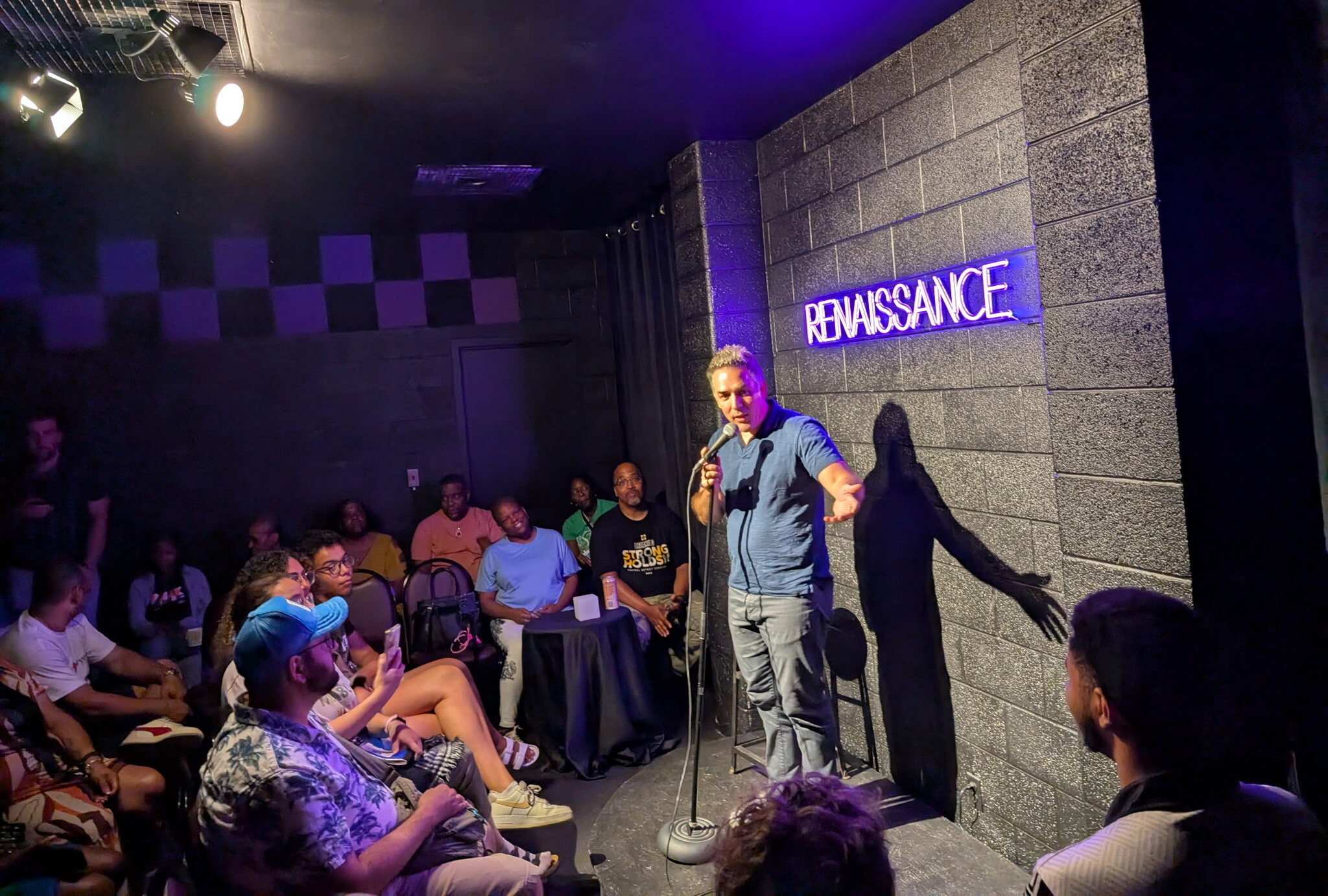
By Ray Marcano
Renaissance Vineyard Church builds community through the gospel, outreach and—comedy?
Yes. Comedy.
The church holds a monthly “Joke Gym,” a PG-13 rated show in the basement of its facility in Ferndale, MI, a suburb of Detroit.
Co-lead Pastor Drew Fralick used his background as inspiration for his church-comedy club idea, which he called “pretty controversial, really out-of-the-box.” But he’s a big believer in what he calls “in-between spaces” that connect church with community.
Fralick knows something about the funny business. He spent 11 years in China performing as a comedian and opening comedy clubs.
Upon moving back to the U.S., Fralick and his wife, Laurie, joined the church of about 100 congregants. In 2021, the church’s founding pastor announced he was leaving and asked Fralick if he’d like to succeed him.
“I thought, I’ve never been a pastor. I don’t really know anything about that. And he goes, ‘Well, you’re a therapist and a comedian. That’s a pretty good start for any pastor post-pandemic.’”
Now, Fralick and his wife serve as co-pastors.
Fralick combined his Master’s in mental health counseling and passion for comedy into a community experience.
Each Friday night, the church holds Celebrate Recovery, a Christian 12-step program for drugs, alcohol, and trauma.
Fralick decided that laughter could help attendees take their mind off their troubles, if only for a little bit. After the Celebrate Recovery meeting at 6:30 p.m., Fralick opened an alcohol-free bar at 8 p.m., followed by the comedy show at 9 p.m.
The bar became a community draw for people who wanted to have a fun night out without consuming alcohol.
“It exploded,” Fralick said. “The sober community is pretty big in Metro Detroit. We’ve had a lot of those people come through our doors, people who maybe haven’t stepped foot inside of a church in maybe 20-30 years or they wouldn’t be caught dead in a church, they’re coming to this in-between space.”
While his church board supported the idea, he ran into some opposition from parishioners and comedians.
The comedians wondered how they could perform in a church environment and follow the Joke Gym’s clean comedy mandate. “I think that a really good artist can fit within constraints,” Fralick said.
But he quickly learned he had to set boundaries for what was and wasn’t appropriate material.
“In the beginning, we said, ‘Let people use their best judgment,’ which was not a good idea,” he said, laughing. “I learned 85% of (comedians) are very smart. They’ll read the room, and they’ll say, ‘Oh I’m in a church, maybe I shouldn’t do this.’ And 15% of people just don’t care. We’ve hemmed it in a bit, because comedians will just go right to the edge if you let them.”
Off-limit topics include glorifying drug use and violence, and pedophilia and rape.
Some members of the congregation worried about the joke topics and that comedians would poke fun at religion. (Fralick has poked fun himself, like with his routine on a privileged Adam and Eve.)
Fralick pushed on, painting the church basement walls and ceiling black so it had a more comedy club vibe. The basement already had a stage, and he created an area for the bar. With a little paint and elbow grease, he created the club space with little money.
Over time, the opposition waned. Comedians now contact Fralick hoping for a chance to perform. Most of the shows are donation-only with just a few ticketed events for bigger names. Every week, the space, with about 40 seats, sells out.
Church goers mingle with community members, an important part of Fralick’s in-between philosophy.
“We need a place where the religious world and the outside world can interact,” he said.
Now, some two and a half years later, the Joke Gym has become a community staple, and Fralick is proud of the church’s uniqueness.
“This church values authenticity,” he said. “It’s not a stuffy religious environment. So having a comedy space helps us not take ourselves too seriously, to poke fun at stuff, and have a good time. This church does a lot in the community, so being able to host events aligns with that.”
When a church invites a line dancing group to use its basement for practice, a mutually beneficial relationship develops.
When a church invites a line dancing group to use its basement for practice, a mutually beneficial relationship develops.
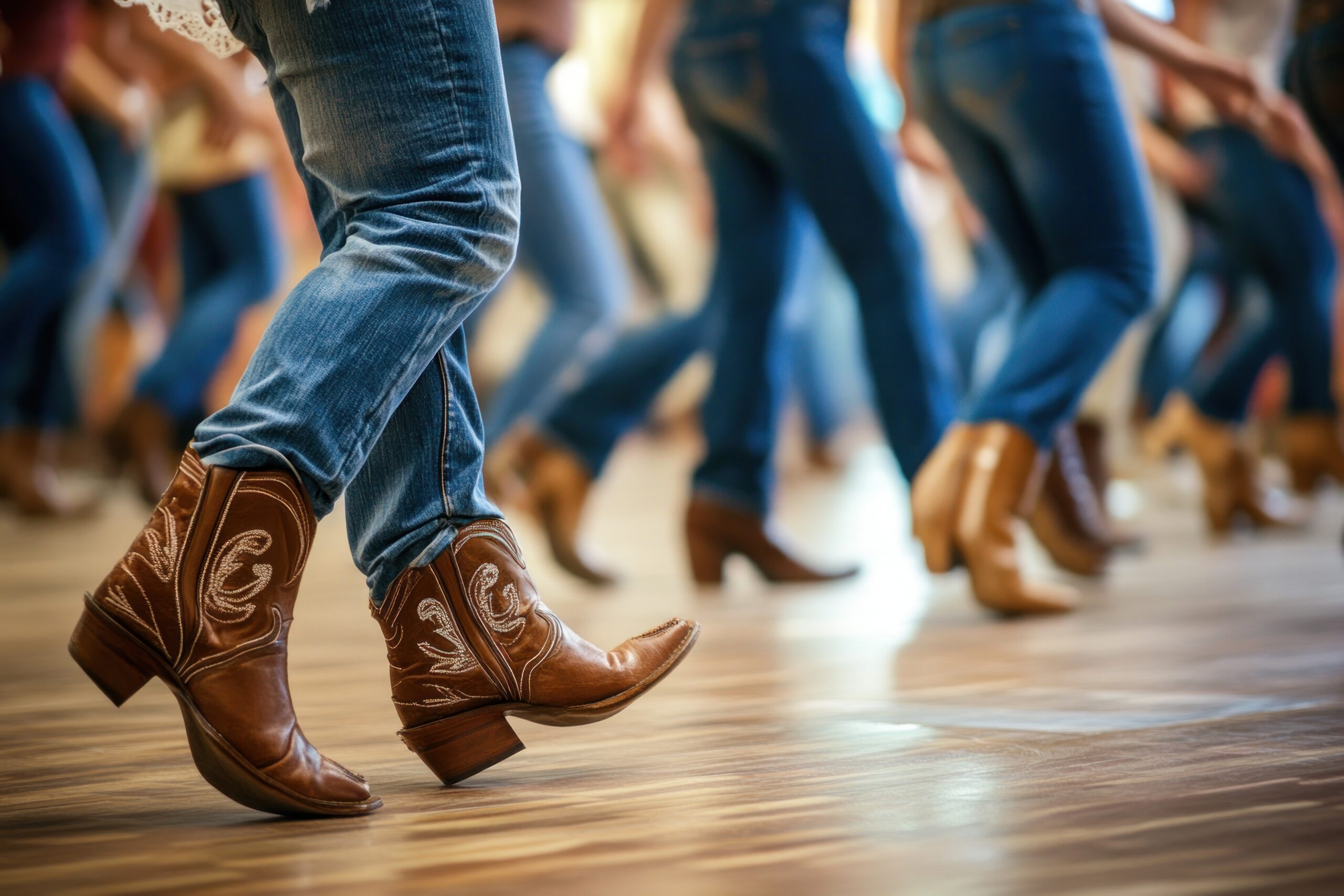
By Kelly Dunlap
One fall evening in a small North Carolina town, a group began to congregate, uninvited, in the pavilion of New Salem UMC. A well-intentioned member of the church set off to inform the group that they couldn’t gather on their property, but when Pastor Steve Bergkamp caught wind of what was happening, he ran after them to insist that they were welcome to stay.
The unexpected visitors were a recreational line dancing group that had lost access to their usual facility and needed a place to dance. Bergkamp invited them to return as they wanted and offered the use of the church’s fellowship fall, free of cost.
The members of New Salem UMC were not surprised by, or resistant to, these new regulars on their property. Since beginning at the church just two years prior, Bergkamp had built up trust among the congregation and conveyed his desire to cultivate new relationships in the community.
Bergkamp had told the congregation: “The church isn’t going to grow by what we do on Sunday mornings. Our goal is to utilize our property and buildings Monday – Saturday, then Sunday will take care of itself.”
However, while church growth is welcomed, these community interactions are not covert strategies to grow the flock. Bergkamp has made sure that it’s clear, both in his congregation and the community, that there are no strings attached when community groups use their space—there are no requirements for visitors to join the congregation or claim religious beliefs. If there were expectations, Bergkamp believes that “people will sniff that out and know we’re not authentic.”
The congregation went through a discernment process during the recent schism in the United Methodist Church, in which some churches chose to disaffiliate. New Salem decided to stay in the UMC and through those discussions on values and vision, the congregation identified that they cared more about having an impact on the community than growing attendance on Sunday mornings. This clarity of vision gave Bergkamp a “green light” to put energy toward relationships outside of the church. A very small number of members, already unhappy with New Salem’s decision to stay in the UMC, left the church over the its approach to community outreach.
Those who stayed had a renewed energy to make space, literally, for new life in the church. Church members have been cleaning out the church library and old Sunday school rooms so that they can be used by the community. Bergkamp says that attention is being paid to respecting and preserving their heritage, while not letting it be a hindrance to what they believe God is calling them to today.
Church trustees even decided to spend $12,000 to replace the fellowship hall floor to better host the line dancers. The dancers became very active in the church’s fundraisers for this project and even other ministry efforts.
While there was no expectation the dancers would support the church in this way, Bergkamp did say he’s given one stipulation for their use of the space: that people of all backgrounds from the community were welcome to participate for free. The group eagerly agreed.
Building community partnerships is not a new territory for Bergkamp. Prior to becoming a pastor, he served for 35 years as a Park Ranger and Superintendent, including being a “burn boss” responsible for prescribed fires. In these roles he organized community groups to assist in park operations. He recognizes that some of those outreach and organizing skills are being put to use in his new role as pastor.
But Bergkamp doesn’t see New Salem’s outreach efforts as exceptional, but rather as a part of a larger trend of congregations asking how they can use their properties in service to the community.
And New Salem’s new ways have stirred curiosity in the town about the church. “We’ve become known as the church that has a full parking during the week,” Bergkamp says.
A chance encounter with a man experiencing homelessness led to a comprehensive church-based ministry to help the most vulnerable in the community.
A chance encounter with a man experiencing homelessness led to a comprehensive church-based ministry to help the most vulnerable in the community.

By Ray Marcano
A chance encounter with a homeless man led to a church-based outreach program that helps vulnerable members of society.
The homeless outreach effort, by New Covenant Church in Thomasville, GA, also shows that community connections can be more valuable than cash.
The outreach began by chance. About two years ago, senior pastor Dave Allen and his wife, Alli Allen, joined another man who was going on a “street feed” to take food to the homeless.
The Allens encountered a man living in the woods who had spent time in prison and just been released from a crisis center. They gave him a meal and companionship and talked to him about how he wanted to give himself to the Lord.
The next morning, the man showed up at New Covenant. He had walked to town from the woods, with no shoes and blistered feet. His determination gave the Allens the strength to take a leap of faith. With no money and few connections, the couple decide to start the homeless outreach ministry.
“Our statement is ‘Love, mend, train, send,’ so we love them where they’re at, help with the mending process and do training” to help them improve their lives, Alli Allen, who co-pastors with her husband, said.
Thomasville, with a population of almost 19,000, has its struggles. More than one in five residents live in poverty and it has one of the highest crime rates in the country for a city its size.
Speaking of the area where some of the homeless lived, Alli Allen said, “We didn’t know it was a really bad area. It was a wooded area, a lot of sex trafficking, drugs, violence, murder in the area.” But the Allens pushed forward, convinced of the need for their ministry.
The church board support the effort, as does the small congregation of about 75. But the Allens were still responsible for driving the project, raising money and attracting volunteers to build their vision.
They have rallied the community for in-kind contributions. Local restaurants donate food and Dave Allen drives a van borrowed from another church to shuttle the homeless to and from programs at New Covenant.
But the in-kind donations aren’t enough to sustain the program. So the Allens get small cash donations from family members and friends — $50 here, $200 there — to buy grits, coffee and other items. Local churches also pitch in with a few dollars here and there.
“It’s all about building relationships,” Alli Allen said.
From that one feed two years ago, the program has now grown to include activities and meals two to three days a week. Thursday’s a big day. The attendees can take showers in the church locker room, eat breakfast and lunch, and drop off laundry. Alli and a few volunteers do the cooking and serve upwards of 25 meals on any given day.
The outreach also includes a Bible-based program that helps the homeless understand the challenges they face, which includes addiction. The Allens both have a mental health counseling background, and they use scripture to share the message that, “with God’s help, they can have the power to overcome and get to the root issues of why they’re doing drugs or alcohol or having a non-productive lifestyle,” as Alli put it.
There are risks, and big ones. Some of the homeless have mental health issues, still struggle with drugs, and can be violent.
“I’ve had our front doors ripped off and stuff stolen,” Alli Allen said. “I have a friend in Chicago that did homeless ministry, and he got stabbed. He made it, but barely. Because we get close, there’s always a risk. But I think when you see lives radically changed and true love happen, you take the risk.”
The risk has certainly paid off and made a difference in lives, like the homeless man that Allens first encountered. He moved into a tent on church property, and the Allens helped him get a job. He now helps with the street feed and Dave Allen continues to mentor him. More importantly, he’s reconnected with his mother, an alcoholic who now volunteers two days each week at the church.
The Allens take Matthew 22:37-39 to heart: “Thou shalt love the Lord thy God with all thy heart…. Thou shalt love thy neighbor as thyself”
As Alli Allen said, “We just love people.”
A Detroit church has created a community haven where visitors can not only find spiritual support and connection, but can clean their clothes, too.
A Detroit church has created a community haven where visitors can not only find spiritual support and connection, but can clean their clothes, too.
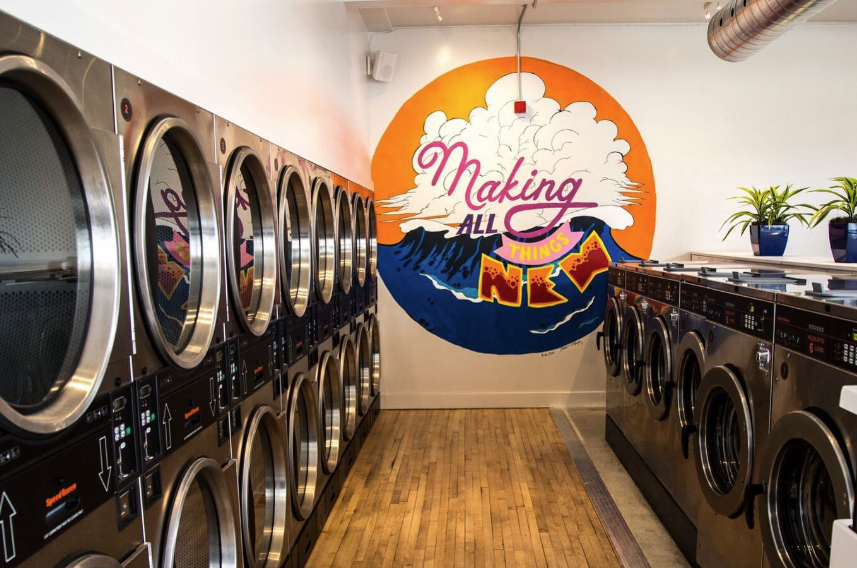
By Ray Marcano
A Detroit church has created a community haven where visitors can not only find spiritual support and connection, but can clean their clothes, too.
Back in 2018, Mack Avenue Community Church opened The Commons, a laundromat and coffee shop. It gave the neighborhood “a space to congregate, to meet, to connect, to cross paths, to hang out, to engage with each other,” church pastor Leon Stevenson, said.
On its face, combining a laundromat and coffee shop under one roof might seem an odd pairing, like putting pickles on a peanut butter and jelly sandwich. The project came together after the church met with community members to learn how it could help the struggling area. The church learned that people needed a place to wash their clothes.
“Our vision is to see communities transformed, both physically and spiritually, starting right here with our own,” Stevenson said. “So, on the spiritual side, the church is excited to invest in people and lead with discipleship and see people grow in Christ.”
Investing in Detroit’s zip code 48214 meets the church’s vision of helping neighborhoods flourish. Nearly 30 percent of local residents live below the poverty line.
Moreover, The Commons is located 1.3 miles east of the church in an area that needs support. The laundromat/coffee shop sits across the street from a vacant lot and a mini-mart. Some houses are boarded up, others in drastic need of repair. Crime is also a problem, as the zip code is one of the more dangerous in the country, according to Crimegrade.org.
Eight years prior to opening The Commons, the church started a nonprofit for community development and other initiatives like an after-school program, legal clinic and sports program.
But The Commons was a massive undertaking. Through philanthropy and grants, the nonprofit raised $1.4 million to purchase a vacant building, renovate it, and buy laundromat equipment.
Stevenson’s board and small congregation of 90 people back the project. But the wider church community that had partnered with Mark Avenue on other projects was more reserved, and that hurt.
“They were like, good idea, but let’s see how that goes. Get back to us when you get halfway through it,” Stevenson said. He had the financial resources to complete the project, but wanted more spiritual support to carry him through times of doubt.
“I think that we all want to be affirmed,” he said. “We want to know that this risk we’re taking is worth it. Knowing that people are behind you and believe in you and are praying for you, really can make the difference.”
The area provides a challenge and risk for The Commons. Some have tried to steal the tip jar. Others have come in angry, broken things in the store and accosted staff. Stevenson is amazed that when these things happen, customers take action, as if to say, “No. Not here.”
“Our customers have jumped behind the coffee bar to make sure our people were safe,” Stevenson said. “You don’t do that unless it’s a place you care about. You don’t give of yourself unless you felt other people love and care for you. That’s what gets me emotional sometimes, thinking that people would fight for this place in that way.”
The Commons is priced with the community in mind. A cup of coffee costs $1.89, and a breakfast sandwich is $3. A small load of laundry costs $3.50 to wash and $0.25 to dry. You can even buy laundry detergent ($0.50 for a half cup, $1 for a full cup).
It’s a big undertaking that has paid off for a neighborhood that needs it. Everything — the building’s location, its services, and its perseverance in the face of poverty — fits into the Mack Avenue Community Church’s philosophy.
Stevenson said, ‘What we hope you say about our church is that because they exist, my quality of life is better.”
In an effort to make amends, the Episcopal Diocese of Maryland established a $1 million reparations fund to benefit Black communities.
In an effort to make amends, the Episcopal Diocese of Maryland established a $1 million reparations fund to benefit Black communities.
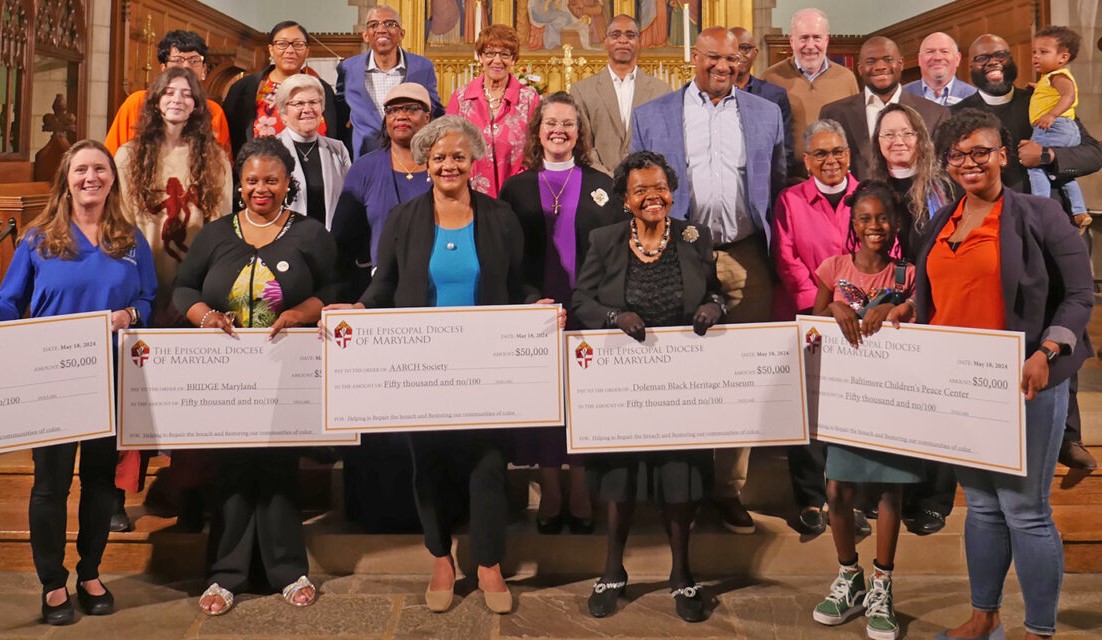
By Dan Holly
Sitting just south of the Mason-Dixon line – the line separating slave states from free states in the early history of this country – Maryland was located just barely in slavery territory. But the state was deeply into slavery nevertheless. The commodities produced by slaves “provided the foundation for Maryland’s economy,” according to a state history document.
Today, strikingly, Maryland is a leader in reconciliation efforts between Black and White residents, including reparations initiatives for Black residents. Among the more prominent of these projects is one undertaken by the Episcopal Diocese of Maryland, which, in 2020, established a $1 million seed fund to be disbursed to programs in Black communities.
The initiative for the fund came from Bishop Eugene Taylor Sutton, who, in 2008, became the first bishop of color in the diocese. When the diocese’s convention passed a resolution establishing the fund, Bishop Sutton commented: “Passing the resolution is in recognition of our collective complicity and contributing to the impoverishment of Black communities. I had nothing to do with enslaving persons. I’m not guilty of that, but I have a responsibility. … I know we don’t all agree that this is the best vehicle to make amends. We all do agree, I’m quite sure, that we will do all we can to eradicate the sin of racism off the face of the earth and repair the damage that it has done to this nation, this state and our communities for centuries.”
Since 2022, the diocese has awarded over $655,000 in reparations grants to more than a dozen organizations, and the grants will continue. (The fund was set up so that grants can come from interest, not principle, and can continue in perpetuity.)
Standards for use of the Reparations Fund have never been set in stone. From the beginning, there was controversy. Diocese archives show that there was a lively debate in 2020 when the resolution establishing the plan was proposed: “Those who spoke against the resolution did so not as much in opposition to the concept of reparations, but with questions as to how the money will be wisely and faithfully spent,” the archives state.
A committee was established to disburse the funds. Suggested uses included:
- Improving housing assistance programs that help Black Americans purchase homes.
- Developing mixed-use housing that supports socio-economic diversity.
- Bringing desperately needed services such as grocery stores, urgent care centers, and community centers to communities, and
- Developing meaningful job-training programs in partnership with corporations and local businesses for actual job placement.
The chosen winners have depended a lot on the strength of the application, according to J. Jason Hoffman, Director of Communications for the Episcopal Diocese of Maryland. In the third round in 2024, $50,000 grants went to African American Resources Cultural and Historical Society, Baltimore Children’s Peace Center, BRIDGE Maryland, Doleman Black Heritage Museum, and Marian House.
For the fourth round, in 2025, the grantmaking focus has changed some to emphasize start-ups. “Fifty thousand dollars is really not a lot of money,” Hoffman said, “but it can have a great impact on a start-up.”
The $50,000 grant that the Doleman Black Heritage Museum got in 2024 played a “vital” role in helping the group accomplish its mission, said Alesia Parson McBean, the museum’s project director. The museum, located in Hagerstown, Maryland, is dedicated to preserving African American culture and history. The grant allowed the museum to restore stained glass windows from a local church that had been torn down. The windows were more than merely decorative; in slavery times, the church was a stop on the Underground Railroad and the windows show images that secretly alerted escaping parties that the church was a safe house, McBean said.
The restored windows will be displayed at the museum’s new home, which is under development.
“We [African Americans] are 14% of the [county] population, and the median income is less than $40,000, so people who have an interest in preserving Black heritage, history and culture don’t always have the disposable income to throw at it,” McBean explained. “This grant came at a wonderful time.”
Two people in a good position to assess the impact of the diocese’s Reparation Fund are the Rev. Nancy H. Hennessey, rector of Sherwood Episcopal Church in Cockeysville, Md., and Stephen Gibson, a retired school principal from Baltimore. They were co-chairs of the first Reparations Fund Committee.
Both can point to success stories for individual grant recipients, but they cannot offer hard data on the fund’s overall impact, because the grants are not set up in a way that specific metrics of success can be applied.
“From the very beginning our approach was to say, if we are truly looking at reparations, we are not going to micromanage and look at what you did, dollar for dollar,” Gibson said. “That was never the intent of the Diocese of Maryland. The intent was to go through the discernment of letting God lead us to organizations that are trying to do the right things. We have people in the committee who are assigned to that particular organization to take a look at it and work with them. But we do not ask for a lengthy report where we say, ‘Show me how you spent each and every dollar.’ ”
More important, Rev. Hennessey said, is the impact on people. “It’s about building relationships – particularly for the White community, to understand what barriers are still in place now. …A lot of our churches were built on the backs of slaves. So that’s a whole ’nother component of it. Eventually, I hope, each of our congregations will do a deep dive into their own history. Some have done a fabulous job already. Others are still trying to come to terms.”
“We’re a little unorthodox, but you know, that’s the point,” Rev. Hennessey reflected. “And it is all about restitution.”
When a church member deeded a large plot of land to his church, the congregation leased 80 acres for solar farms, leading to a surplus of income and the Gratitude Project.
When a church member deeded a large plot of land to his church, the congregation leased 80 acres for solar farms, leading to a surplus of income and the Gratitude Project.

By Dan Holly
The First Baptist Church of Mount Olive is a small, old church in a small, struggling town in eastern North Carolina. But due to a stroke of luck about 20 years ago – or perhaps it was divine providence – the church has something even a megachurch in a prosperous suburb would love to have: a steady source of income above and beyond congregation donations. Good income.
A few years ago, church members decided they needed to do something with their extra money: give it away.
Rev. Dennis Atwood, the former pastor of 22 years, did a series of sermons on gratitude that culminated with a call to take $100,000 and put it into a fund to “make a difference.”
His sermons evidently were effective. He put the proposal to a vote and it was a unanimous “yes.”
They decided to call it the Gratitude Project.
“I didn’t begin the sermons with that [the Gratitude Project] in mind…but I thought we had to do something concrete about poverty, education, the lack of affordable housing in our town. We are one of the poorest areas in the state. …I thought $100,000 would be a good starting point.”
The seeds of the Gratitude Project were planted back in 2003. That was when a church member deeded more than 200 acres to the church in his estate. In 2013, Birdseye Renewable Energy was looking for tracts of land for solar farms. The company contacted the church and the end result was leasing two parcels – a 38-acre tract and a 39-acre tract – for solar farms. The farms bring in $80,000 per year to First Baptist Church of Mount Olive.
Bryan King, a church member who is an attorney, was appointed chairman of the four-member committee designated with deciding how to give away the funds.
The committee first researched other places that had done something similar. “We tried to approach it from the get-go that this wasn’t going to be just charity, just giving money away,” King said. “It was more about trying to address structural problems in our town, the biggest one being poverty.”
Mount Olive has a population of just over 4,000, according to the town’s website. The median household income is just below $42,000 and the poverty rate is 27 percent, according to Data USA.
Mount Olive is almost a Southern cliché. Railroad tracks divide the town and one side is mostly Black, with many rundown and overcrowded houses; the other side is largely White and middle class. First Baptist sits on the White side of the tracks – one block in. The 350-member church is overwhelmingly White.
The Gratitude Project gave out 10 grants for projects ranging from housing repair to piano lessons.
Some of the grants had a direct impact on poverty. For instance, an $18,000 grant to the Wilmington Area Remodeling Ministry (WARM) went for extensive repairs to the home of a man who had fallen behind on upkeep due to health issues.
Other grants took an indirect approach, such as the $12,000 given for football equipment for the Mount Olive Hurricanes, a youth football club that mainly serves young people from low-income families, according to the club’s director Ronnie Wise. The club’s equipment was so old that the club’s future was in peril, Wise said. The grant ensured its future, he said.
The last of the $100,000 was disbursed in January 2025.
Rev. Atwood would like to see a second phase of giving, as more money becomes available, focusing on affordable housing. He also has written a book about his journey to gratitude. He hopes other churches will follow his church’s example.
“The Gratitude Project was just a way to throw another stone into the pond and create ripples,” he said. “You could affect people in other ways; this is one way to do it. I think it gave us a little bit of fresh air and a boost in our approach to missions in the community. It’s a model – a model other churches could use when they reach out to their community.”
To learn more about The Gratitude Project, contact Rev. Dennis Atwood at dennisratwood@gmail.com.
A church and mosque collaborate to power—and empower—their neighborhood by installing solar panels on the church roof.
A church and mosque collaborate to power—and empower—their neighborhood by installing solar panels on the church roof.

By Dan Holly
The main mission of Shiloh Temple International Ministries is to advance Biblical principles, like any Christian church. But when the Minneapolis, MN, church was approached with the idea of installing solar panels on their roof to serve the surrounding community, the idea fell on fertile soil.
Head Pastor Richard D. Powell Jr. saw merit in the idea, particularly because it could be helpful to the community, a neighborhood in north Minneapolis with many low-income residents.
“It’s important that the faith community be supportive of solar-powered energy because the mission of the church is to be a lighthouse for the community,” Rev. Howell said.
It was really a matter of square footage that the church was chosen for the project. “We chose Shiloh Temple because they had a huge roof,” explained Julia Nerbonne, executive director of Minnesota Interfaith Power & Light, a group that, according to its website, “works in partnership with multifaith communities and all Minnesotans to co-create a just and sustainable world.” Shiloh also happened to be in a community where Minnesota Interfaith Power and Light had other ongoing projects.
The group partnered with Cooperative Energy Futures, a Minneapolis-based nonprofit whose mission is “to empower communities across Minnesota to build energy democracy through solutions that are clean, local, and ours.” Together, the two groups helped Shiloh develop a solar array on the church’s rooftop — 630 panels that provide 204 kilowatts of power. It opened in 2017.
The array of panels provides power to neighborhood residents who subscribe to it; currently, 25-30 homes are subscribers. The cost is lower than residents pay for traditional sources of energy.
That was good news for neighborhood residents such as Noy Koumalasy.
“To me and my family it means an awesome opportunity,” Koumalasy said. “Once we subscribed to the Shiloh array it was definitely less bills for me.”
The project also provided jobs for some residents; one requirement of the project was that the installation team be at least 50 percent people of color.
Keith Dent, resident of the north Minneapolis neighborhood where the church is located, worked on installing the solar panels.
“Working on this solar garden especially feels wonderful being that I’m a resident of north Minneapolis and I’m a subscriber to the actual solar array,” Dent said.
Edward Owens of the St. Paul NAACP sees the project as a boon for the community.
“Solar energy is an opportunity for us to move forward,” Owens said. “Solar energy is an opportunity for the community to work together.”
The project had benefits beyond saving money and helping the environment, according to Nerbonne. “One of the cool things about this project is that Masjid An Nur, a mosque, and Shiloh Temple, a large African-American church, are working together to make this happen,” she said.
The solar array provides energy to both Shiloh Temple and Masjid An Nur in addition to community residents.
Imam Mohammed Dukuly said the mosque is “proud to be part of this process.” He added: “We believe that this process will restore economic justice to this community.”
Interfaith cooperation and understanding is another benefit of the project, Rev. Howell said: “Isn’t it amazing that we can get along? We may have different viewpoints and ideologies, but isn’t amazing how we can work together and make a difference in the community?”
NOTE: Comments from Pastor Richard Howell, Imam Mohammed Dukuly, Noy Koumalasy, Edward Owens and Keith Dent were taken from a YouTube video produced by Minnesota Interfaith Power & Light.
A church's fixer-upper parsonage becomes a community center to preserve Latino culture and bridge cultural, generational, and denominational gaps.
A church's fixer-upper parsonage becomes a community center to preserve Latino culture and bridge cultural, generational, and denominational gaps.
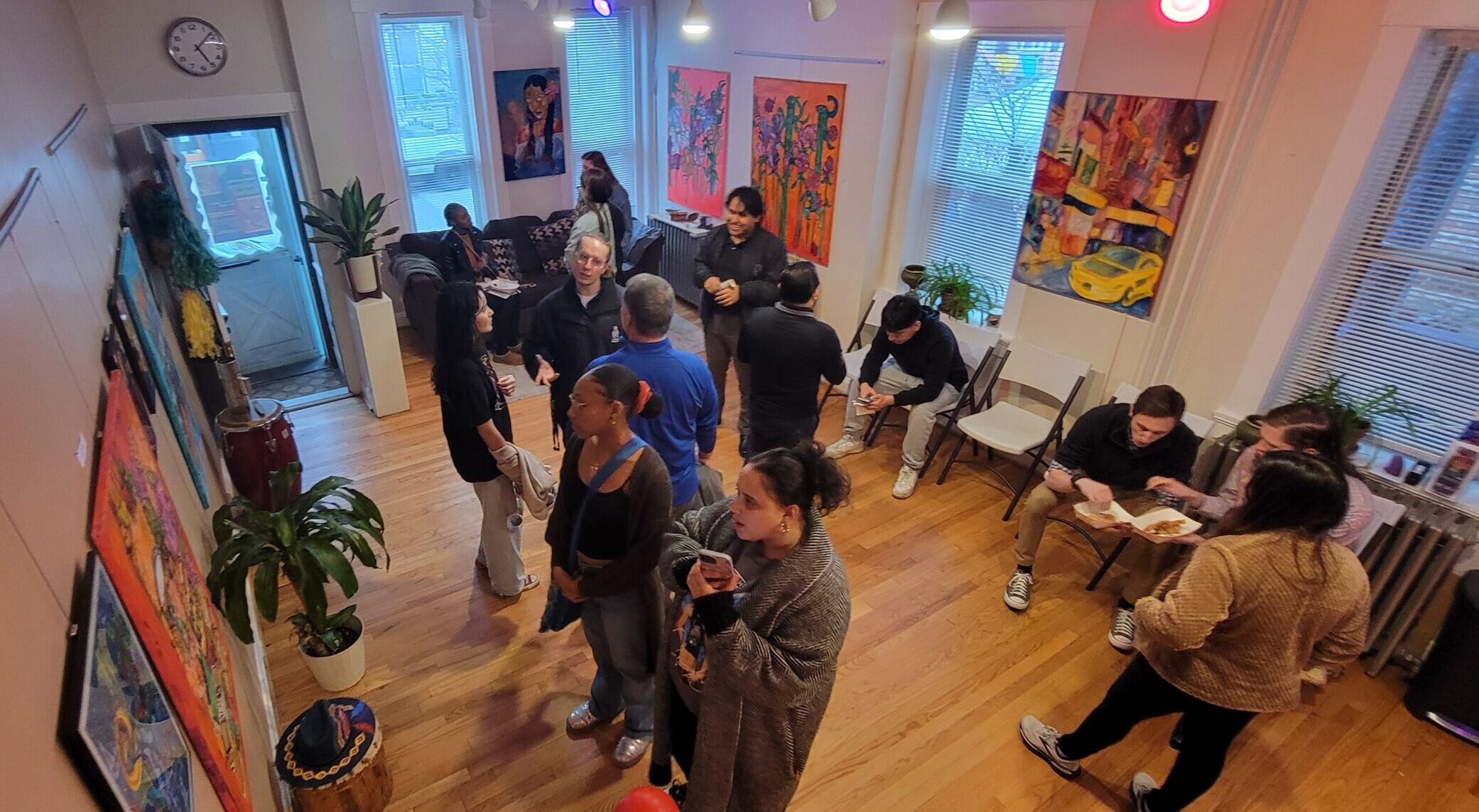
By Dan Holly
When Cassy Nuñez became lead pastor of Salem United Methodist Church in July of 2021, she inherited a church in a low-income part of Baltimore. The lack of financial resources in the neighborhood forced the church to think a little differently about funding its ministry than it might have otherwise.
“We needed to do a lot more fundraising and be more creative with what we did have,” Nuñez recalled. “I started getting to know community organizations. The church started to become more of a community center. Other things happen here Monday through Friday that are of benefit to the community.”
The church’s higher profile in the community became a matter of opportunity meeting preparation. One of the activities the church hosted was a Covid Vaccine Clinic. One of the attendees was Angelo Solera, founder and executive director of Nuestras Raices, Inc. (“Our Roots”), a local group with the mission of educating, preserving and promoting Baltimore’s Hispanic/Latino culture.
Solera mentioned to Nuñez that the group was looking for a space. They had been meeting in coffee shops, restaurants, and libraries and were looking for a permanent home. The day of the Covid Vaccine Clinic, Solera had an appointment to look at a building that he thought might fit the bill.
It just so happened that Salem United Methodist Church had an old parsonage next to the church, a home for the pastor – if it were livable. But it wasn’t; its problems included walls that leaked when it rained, a nonfunctional basement, and lights and windows in disrepair.
“It was not in a state that we could live in it,” Nuñez recalled. “We could use it for other things….but it would have been very expensive to fix up.”
The church did not have the money and the building stood empty. Nuñez mentioned the parsonage to Solera and told him that it might be another option if the building he was on his way to look at didn’t work out.
As it turns out, it didn’t. Instead, Nuestras Raices took over the old parsonage rent-free for three years. They were able to fix it up with a $45,000 loan from the France-Merrick Foundation, a philanthropical organization “devoted to supporting the people and organizations that make the Baltimore region vibrant and diverse.”
Nuestras Raices transformed the parsonage into Casa de la Cultura (“House of Culture”), which opened in August of 2022. Casa de la Cultura is central to Nuestra Raices’ mission, Solera said. Among the activities the group has held there are art exhibits, theater and dance productions, arts and craft workshops, and guitar classes – all representing Hispanic/Latino culture in some way.
“Casa de la Cultura is the first and only educational and cultural empowering center in the state of Maryland,” he said. “The Latino community is comprised of people from 25 different nations. When they come to the United States, they’re very detached from their home country. When they try to adjust to American culture, they often lose their own culture.”
Casa de la Cultura, he said, “is a place where people can be who they are and become renewed to who they are. …This is a place that helps preserve the richness and diversity of the Latino culture.”
A recent exhibit at La Casa de la Cultura featured Dominican folklore. The artist, who goes by Lusmerlin, said the exhibit shared a part of the culture she grew up with in Santo Domingo. “It was magical to see people from all backgrounds, not only Hispanic, to be enthralled and interested in our stories,” Lusmerlin said.
Pastor Nuñez sees La Casa Cultura as related to the church’s spiritual mission but not in some specific, planned way. “Salem has become a gathering place for the community, and not just people who come to church on Sunday morning,” she said. “The church is also full Monday through Saturday. …This church is everybody’s church.”
One thing she is proud of is how the church has contributed to bridging gaps among various denominations – a goal that is important, she said, because the Latino culture is dominated by Catholicism. Dialogue with other denominations is needed.
“Our mission is to be a spark for the community,” Nuñez said. “No matter what denomination, you are welcome.”
Scottsville Church of Christ stepped forward, without hesitation, to run a food distribution program when an urgent need arose in their community.
Scottsville Church of Christ stepped forward, without hesitation, to run a food distribution program when an urgent need arose in their community.

By Ray Marcano
Food insecure residents in Allen County, KY., faced a problem.
The church that had been running a food distribution program for years could no longer do so, threatening to leave thousands of people without access to the free meals they needed.
Enter the Scottsville Church of Christ in Scottsville, KY., which stepped forward, without hesitation, to fill a void and use its ministry to help community members in need.
“When the opportunity presented itself, everyone was on board and excited to take on this new challenge and role in the community,” Terry Stinson, the church secretary who helps administer the food programs, said.
The small church is having a big impact locally. It now administers three food programs that serve hundreds of households each month.
Scottsville volunteered to take on the food distribution responsibility “because of the need in the community. This was a beneficial program for the community, and we wanted just to step in and carry it on,” Stinson said.
The need is certainly there. Allen County sits in a rural area of the state and abuts the Tennessee border. Nashville is the nearest major city and it’s 52 miles away. In Allen County, 14% of residents face food insecurity, according to Feeding America. Furthermore, 16.5% of the county’s 20,588 residents live in poverty, according to the U.S. Census Bureau. More than three dozen areas in Allen County are considered a food desert, according to one report.
Given these concerning numbers, there’s a clear need for reliable and consistent food distribution. With its new duties, Scottsville now runs three food distribution programs. It participates in the two Feeding America programs it took over in September — one for seniors 60 and over and one emergency food assistance program for anyone in the county who meets income requirements. Those programs provide food once a month.
It also participates in a retail program through Feeding America in which the church picks up surplus food from a local retailer and distributes it weekly. Neighbors come to the church, get a bag, and can fill it with milk, produce, frozen items, or whatever’s available. Stinson estimated that though this retailer program, the church distributes hundreds of pounds of food each month.
The church relies on a dozen or so volunteers to make the program go. In addition to the volunteer hours and Stinson’s time, Scottsville pays Feeding America about $200 a month to deliver the food to the church, purchases boxes used for food, and more.
The community is appreciative. “It’s wonderful. They tell us it’s such a blessing to them that it’s helping them feed their families,” Stinson said.
It’s a major undertaking for a small church of about 150 congregants each Sunday, but one that meets its ministry.
“Well, we’re just trying to help our fellow man.” Stinson said. “You know, we’re told to give food if anyone’s hungry, and we’re just trying to fulfill that commandment and help out in the community to feed the hungry.”
On its website, the church wrote: “We are a group of forgiven sinners striving to serve God and serve others as we journey through life here on earth.”
Nourishing the body and the soul certainly serves others, even when the service can seem like an immense undertaking.
“It seems overwhelming when you start thinking about it,” Stinson said. “But when you come together as a church, you can make it happen.”
Reeman Christian Reformed Church in Fremont, MI., opened Wellspring Adult Day Care in 2016 to help those who need a place to go during the day while giving their caregivers a much-needed break.
Reeman Christian Reformed Church in Fremont, MI., opened Wellspring Adult Day Care in 2016 to help those who need a place to go during the day while giving their caregivers a much-needed break.
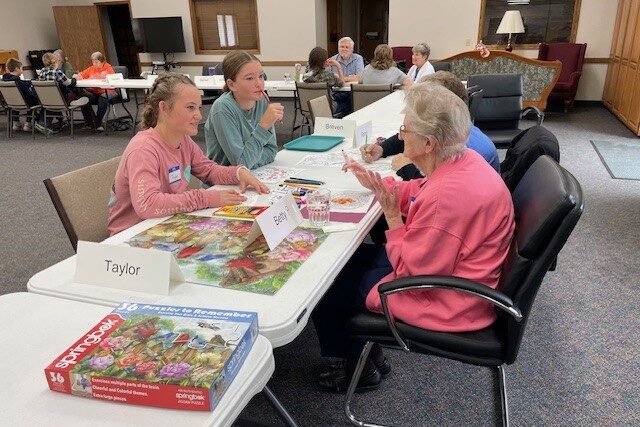
By Ray Marcano
A small church in a small town has utilized its resources to make a big impact on the lives of their neighbors.
The Reeman Christian Reformed Church in Fremont, MI., opened Wellspring Adult Day Care in 2016 to help those who need a place to go during the day while giving their caregivers a much-needed break. It took prayer, research, and overcoming initial rejection for the project to move from idea to reality.
Tammy Cowley, Wellspring’s business manager, said, “We hear so many times that (caregivers) could not keep loved ones home as long as we do if it wasn’t for Wellspring.”
In 2015, a congregation member told Nate Kooistra, now the church’s associate pastor and chair of the Wellspring team, there was a need in the larger community for adult daycare services. In addition to giving the adults a place to go during the day, adult daycare would alleviate a little pressure on caregivers, who could have a little break and time for themselves.
Church members prayed about the idea, visited a few adult day care centers, and decided to recommend this new ministry to the church council.
The council, at first, said no.
“We didn’t have enough details for them,” like financial data and a staffing structure, Kooistra said. The council loved the idea, but told Kooistra, “You’re not there yet.”
The initial rejection turned out to be a blessing because it forced the team to dig deeper to get more information. It also reminded the team that people who are unsure at first aren’t necessarily against a proposal. “They just need some time to let it sink in,” Kooistra said
The team visited three adult daycare centers and found one in Indianapolis that served as inspiration because it was a ministry of a church, which is what Wellspring sought to be. The experience helped the Reeman team understand a church-based adult daycare’s activities structure, staffing models and policies. Reeman also learned how to sustain this new ministry through funding sources such as grants, guest fees, Medicare dollars and fundraisers.
Kooistra and his team had another potential hurdle —- he had to meet with and convince the roughly 300-member congregation that an adult daycare fit the church mission.
“Some were excited, several very skeptical, just didn’t quite know why a church would get into this world of things,” he said. “A couple thought it just wouldn’t work. That was a concern for all of us.”
But the congregation approved an effort that fits nicely into the church’s overall mission.
“That’s kind of the mission of our church, to be a neighborhood church, to find ways to use the gifts God’s given us to bless the people he’s surrounded us with. So, it fits … into that kind of merging of those two passions of loving God and loving our neighbor.”
Next, the team talked to local doctors and nurses, who overwhelmingly supported the Wellspring concept. “Every one of them said, ‘I have so many people that could use that,’” Kooistra said.
And then, in the midst of prayer and hope, came an unexpected development that pushed the project over the finish line. Someone from the church donated $10,000 to the ministry, and a local organization provided a grant. Additionally, Wellspring developed other funding sources, such as an auction, and church volunteers help support the mission.
“Those things collectively felt like affirmations that this was where the Lord was leading us and providing a way do this ministry,” Kooistra said.
Now, Wellspring has become an important part of the community at large. Open Monday, Wednesday and Thursday, the program provides lunch, activities, music and more for a maximum of 15 people.
Some attendees use wheelchairs, others have dementia or other ailments. All are welcome.
Wellspring “falls nicely into that sense of loving our neighbors and seeing churches as more than just a place to come for an hour for a week,” Kooistra said. He said a measure of success revolved around these questions: “If your church left the neighborhood, would anybody care? Who would protest? Who would be upset? I think people would be upset now if they lost Wellspring.”
A seminary in Ohio has combined its theological teachings with environmental concerns to feed the body while nourishing the soul.
A seminary in Ohio has combined its theological teachings with environmental concerns to feed the body while nourishing the soul.
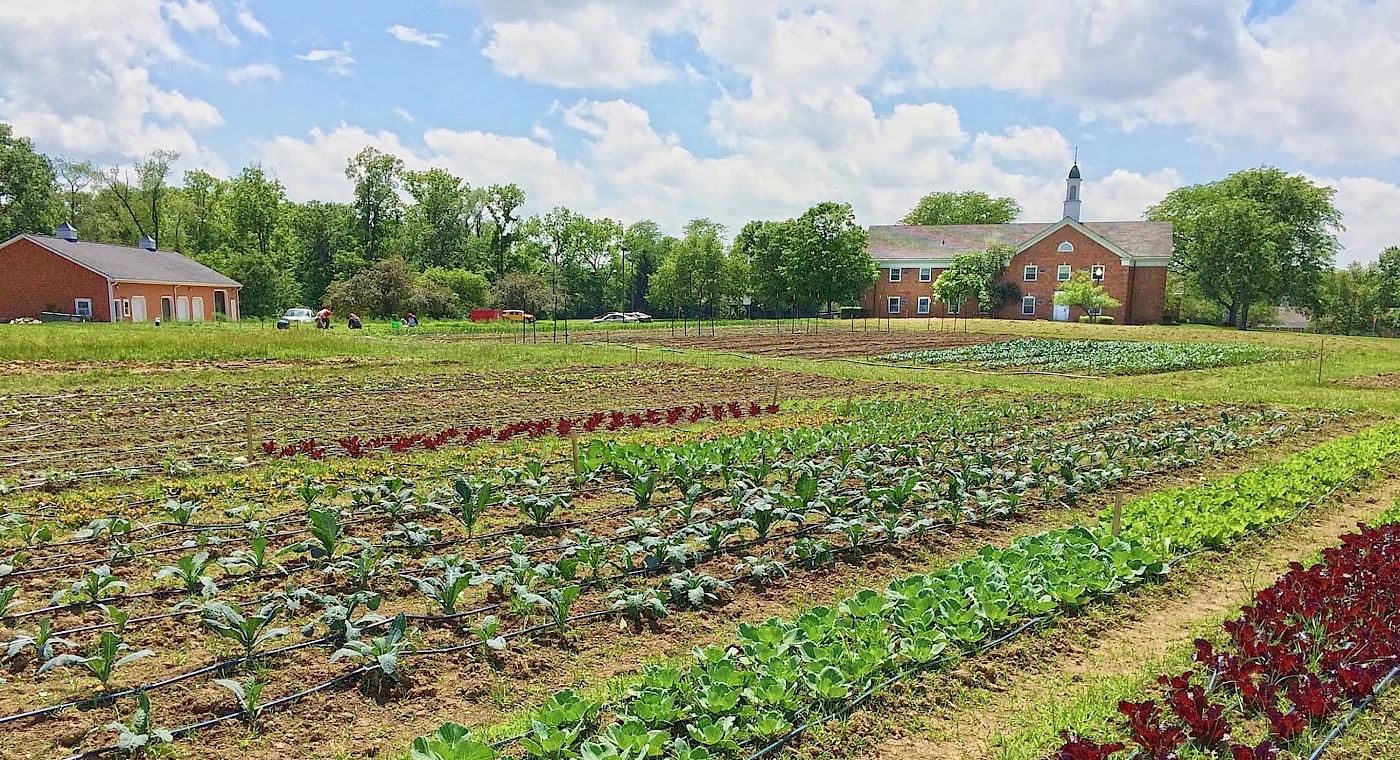
By Ray Marcano
A seminary in Ohio has combined its theological teachings with environmental concerns to feed the body while nourishing the soul.
The Methodist Theological School of Ohio created Seminary Hill Farm in 2013 and, at the same time, adopted the term Ecotheology to describe how its unique farming program dovetails with scripture.
“It’s not always been seen, in the environmental justice world, that church can be helpful,” Jay Rundell, the school’s president, said.
The school’s teachings have a historically strong social and ecological justice bent, yet students saw a disconnect between pedagogy and practice. They would eat processed foods in the cafeteria and see staff mowing lawns, examples of “all the things they were learning were hard on the world,” Rundell said. Students “called us out on our hypocrisy,” he added.
MTSO met a prospective student who ended up not enrolling. But the student ran a farm-to-table operation that intrigued Rundell. He was so excited he decided to take the idea of starting a farm to his board.
That’s where the bumps in the road started.
During a board meeting, a long-time member asked a simple question: Why does a seminary need a farm?
“It dawned on me that in all my excitement about doing this, I had missed really connecting [the idea] to the educational program,” Rundell said. “I learned right there I needed to tie it together to be credible.”
By the next board meeting some four months later, board members had begun to shift. They noted that family members, friends, and neighbors were all proponents of sustainable farming. Rundell got the go-ahead to start the farm and, with it, a new course of study MTSO has dubbed Ecotheology.
But then, Seminary Hill ran into more conflict. Through grants and partnerships, the farm had the resources to be successful –tractors, trucks, paid staff and interns, and, most importantly, free MTSO land. With no overhead, Seminary Hill could sell goods cheaper at area markets– the same markets local farmers depended on for income.
“What I thought was giving back to the world felt like an unfair marketplace to people who were in this work,” Rundell said. “That’s a lesson I had to learn in a hurry, to work with the larger ecosystem of people doing this work.”
As a result, Seminary Hill put more emphasis on education and less on profit. The farm has 10 acres but rarely cultivates more than five. (Rundell doesn’t envision it getting any bigger).
Seminary Hill receives occasional funding from The Ohio State University, which Rundell believes is the “only example of a land grant university funding a denominational seminary.”
Other partnerships include AmeriCorps, which provides interns, and the Culinary Institute of America, which uses Seminary Hill as a placement site for aspiring chefs.
The farm builds revenue by selling some of its produce to restaurants and by writing grants. Since the farm isn’t a profit center, Seminary Hill uses excess funds to help the seminary’s community outreach goals. For example, the farm helps stock a food bank and participates in a food and wellness program for underserved and food-insecure communities.
According to its website, the farm grows seven different kinds of peppers, six different types of winter squash, three different types of tomatoes, cucumbers, onions, potatoes, herbs, and more. Seminary Hill has a Community Supported Agriculture (CSA) that buys a share of what the farm produces.
Seminary Hill has grown so much and become such a part of MTSO that people search for the term “Seminary Hill” more than they search for “MTSO,” which is the common acronym for the seminary.
“We realized there was more interest in what some felt (was) an appendage or a side business, when all of a sudden that became why people were looking for us,” Rundell said. “And I think that’s when we started to realize this isn’t going to go away. This is a part of who we are.”
A Presbyterian church transforms their unused manse (minister's house) into a home for Afghan refugees, and serve as community for the home's first tenants.
A Presbyterian church transforms their unused manse (minister's house) into a home for Afghan refugees, and serve as community for the home's first tenants.
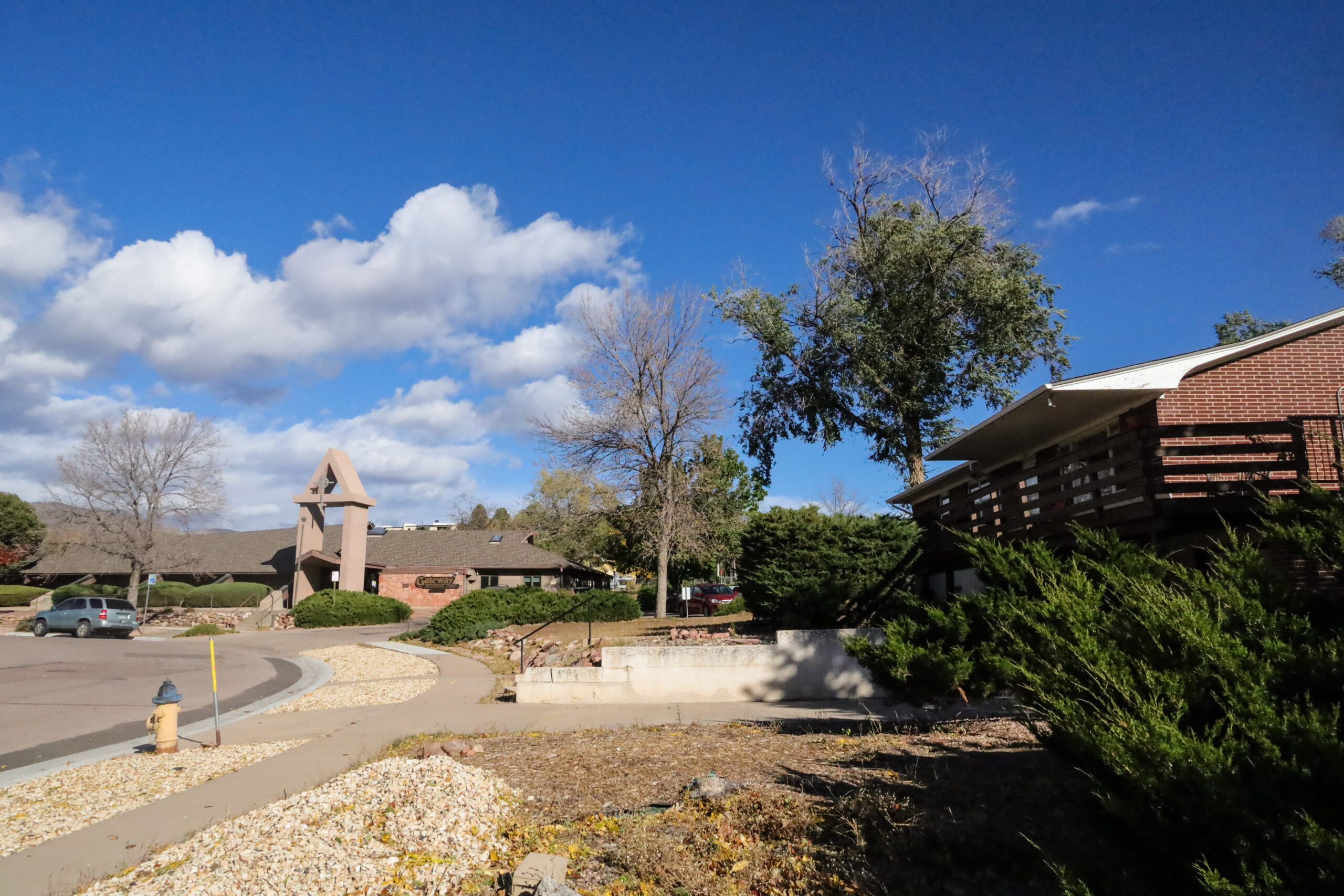
Abbreviated excerpt from The House Next Door by the Presbyterian Foundation.
What should a church do with property it no longer needs? It’s a question that many congregations are facing. Gateway Presbyterian Church in Colorado Springs, CO owns a house that was used as a manse (minister’s house) for several decades. Gateway members began to consider how they could honor God with good stewardship of this resource they affectionately called “the house next door.”
“It’s a paid-for asset and it had been rental property for 20 years. And the general consensus was, we’re not called to be landlords, but we’re probably called to use that in some kind of ministry,” said Rev. Victoria Isaacs, pastor of Gateway.
A dedicated crew of church volunteers fixed up the house without being entirely sure how it might be used. That is, until Elder Paula Warrell had an idea.
Warrell recalled, “One morning … I read an article saying some of the Afghans would be coming to the United States. I thought: well, here we have this big house and it’ll be ready.”
At that time, hundreds of refugees had settled in the Rocky Mountain region, fleeing violence, persecution, and poverty. Lutheran Family Services is the agency that helps the families settle in the area. The first step is finding them a transitional place to live. That can be a challenge.
“As anywhere in the country, rents are increasing at very high rates,” explained Matthew Cramm of Lutheran Family Services. “We always have to keep in mind that when our families get here, they end up in minimum wage jobs, so we also have to factor in that they’re going to have to be able to pay this rent with the jobs they get.”
More than that, refugees need a sense of community, and that’s one of the unique ways a church like Gateway can help.
“They need care … they need people that understand that starting their lives all over again is extremely difficult,” said Floyd Preston of Lutheran Family Services. “But what makes it easy is churches like this … come alongside the families and help them and alleviate some of that pressure to know that “you’re not by yourself, we’re here to walk with you.”
Just a few months after reaching out to the agency, Victoria got the call that a family from Afghanistan needed a home in Colorado Springs. The house next door was ready.
Victoria visited with neighbors to ensure they would be welcoming. And they were.
The neighbors have embraced this family knowing that circumstances in their homeland were dire.
The family fled the wrath of the Taliban. The oldest son of the family had served as an interpreter for the U.S military in Afghanistan. He emigrated to America six years ago. When the U.S forces pulled out of Afghanistan, his family became targets of the Taliban, who threatened members of the family at gunpoint, twice. The U.S. State Department got the family safely out of Afghanistan, and Lutheran Family Services helped them resettle in Colorado Springs.
The family is learning English and how to find jobs. As they re-build their lives, they feel at home in the house next door.
The refugees reported, “We’re so happy for living in this house. Especially, we are safe here. It’s like a good thing for us that we’re next to the church. They bring some foods for children for us or sometimes some books for us. They have helped us a lot in everything. We are thanking God that we have them here.”
Church members feel a renewed sense of purpose and how God is using the house next door. They spend time with the family and invite them to church events. Through it all, they are following Christ’s command to love their neighbor.
Warrell exclaimed, “It was just meant to be. It was a miracle. We had the place. We had the people working and we all had open hearts to welcome a family. And then we got the best family in the world.”
“Their history has been ‘the little church that could.’ And, yet again, God has allowed them to be able to do something meaningful and life-changing,” said Rev. Isaacs.
A closed church reopens as a worship space for Spanish-speaking immigrants, offering healing sound therapy.
A closed church reopens as a worship space for Spanish-speaking immigrants, offering healing sound therapy.

By Dan Holly
Se pueden leer la traducción en español aquí (Read this story in Spanish)
Congregacion Luterana San Timoteo doesn’t look like your typical Lutheran church, but it especially doesn’t sound like your typical Lutheran church.
For one thing, all members of the church are immigrants from Central and South America, and services are conducted in Spanish. But what makes this Chicago church really different is its use of healing sounds in its services. Singing bowls, rain sticks and other instruments provide sounds that are reminiscent of some of the rituals common in countries from which immigrants came.
The church uses sound therapy not only to make immigrants feel welcome but also as a form of emotional and spiritual healing – something especially needed by church members, many of whom have suffered tremendously in their treks to the United States, church leaders say.
Most of the congregation came to the United States by way of Texas, where they landed after crossing the border from Mexico. Texas authorities, in response to border crossings, have instituted the controversial practice of putting immigrants on buses and sending them to states in the North, leaving them in strange cities with little resources.
“They dropped them off in the streets and in different areas of the city where there were Latino people,” said Rev. Del Risco-Nolla, who co-pastors the church. “They arrived with whatever they had on their bodies – that’s it.”
Congregacion Luterana San Timoteo was planted in 2023 by the Evangelical Lutheran Church in America, taking over a building on North Kildare in Chicago after another congregation moved out. (Technically, it is still officially a “mission,” not yet a church.)
The church that had been there was populated by the mostly white residents of the neighborhood. As the neighborhood’s demographics changed, the church closed, and the building remained unused until Congregacion Luterana San Timoteo took it over, adopting the Spanish version of the old church name (St. Timothy’s). Only one resident from the old church remained a member.
The new church grew as other immigrants heard about it – it now has about a dozen members but more than 30 attendees at a typical Sunday service.
“There are some people from the neighborhood and some from other areas,” said Rev. Del Risco-Nolla, whose official title is mission developer. “Some travel long distances because they have identified this church as a place where they belong.”
Church leaders used part of a $12,000 grant from the Evangelical Lutheran Church in America to boost their sound healing ministry. The funds came from a grant program aimed at helping the Lutheran Church reach out to nontraditional populations.
Congregacion Luterana San Timoteo was able to buy four singing bowls, two rain sticks, one ocean drum and a Jewish harp.
For many, these techniques are reminiscent of traditions in their homelands such as spiritual healing by shamans and icaros, a form of healing through songs. “It’s part of their identity,” she said.
A classical pianist and a music teacher, Rev. Del Risco-Nolla is certified in sound healing. She uses her training to blend Christian worship with sound healing techniques.
“We worship Jesus Christ,” she said. “It’s just that we use singing bowls in worship.”
With singing bowls, mallets are used to rub bowls in a way that produces a humming sound. That sound is considered calming by many people. Some health-care professionals say the sounds and vibrations can even promote emotional and spiritual healing.
On Sunday, singing bowls are occasionally used as people take communion. Other sound therapy techniques are a prime feature of Tuesday night services.
Healing sounds are one of the things Edward and Jennifer Rodriguez, who have been members of Congregacion Luterana for five months, like about the church. “The music calms me down,” Edward said. “I think it’s relaxing and effective.”
Said Jennifer: “They [members of Congregacion Luterana] were the second people we met and the only ones we have right now.”
NOTE: Edward and Jennifer spoke in Spanish. Their comments were translated using Google Translate.
A NYC church continues its long-term relationship with the theater community and generates needed income by opening rehearsal space.
A NYC church continues its long-term relationship with the theater community and generates needed income by opening rehearsal space.
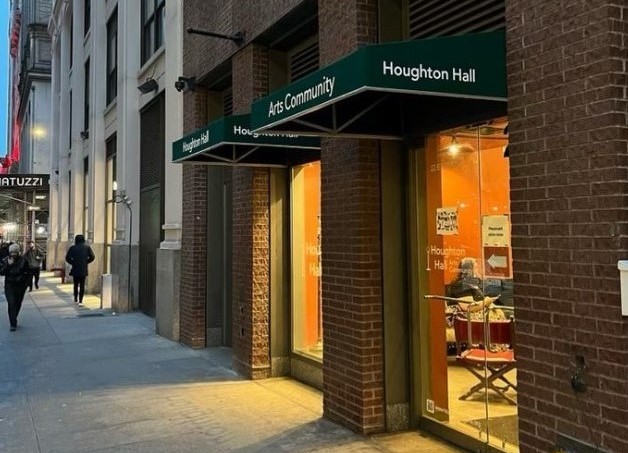
By Dan Holly
The Church of the Transfiguration in New York City has a lot of things going for it – a prime location in midtown Manhattan just blocks from the iconic Empire State Building; a rich history (it was a stop on the Underground Railroad); and a Gothic-style brick building with national landmark status. But until recently the church also had something of an albatross – it owned property next door that sat empty.
The Episcopal church does not need the neighboring property, which consists of the first four floors of a modern building, for church functions. But it has depended on the space for rental income, according to Katherine Hutt, the clerk of the church’s vestry.
“We had a tenant for many years that provided income needed to support the historic [church] property, which is expensive to maintain,” Hutt said. “They moved out during the height of the pandemic and we were not able to find a new renter.”
The church came up with an oh-so-New York solution – it is now renting the property to theater groups. Hutt explained: “We decided to turn the space into a rehearsal facility for theatre groups and manage it ourselves.”
In early 2022, the empty space was transformed into the Houghton Hall Arts Community. Hutt, who is also president of a communications company, co-founded the community organization.
“More than 50 different groups have rented space: theatre companies, acting schools and teachers, dance groups, clowning and stage combat instructors, play reading groups, and more,” Hutt explained. “…We have also hosted a number of events, including training for public school theatre teachers, a piano festival, a teen theatre festival, black box style performances, and a songwriting collaborative.”
She added: “The long-term goal for Houghton Hall is to replace the revenue that a single tenant provided to the church. While we are still several years away from achieving that goal, we are moving in that direction.”
Hutt says the reaction from groups that rent the space has been “overwhelmingly positive.”
One of the satisfied customers is Urban Angels Acting Workshop. The group uses Houghton Hall for such activities as relaxation, sensory work, improvisation and monologues. “Urban Angels Acting Workshop found a home when Houghton Hall was just starting out,” founder Karen Giordano said. “It’s a welcoming and community-minded, creative space for artists.”
The ties to the theater community are not only practical, considering the church’s location in New York City, but also consistent with the church’s theological tradition and mission. The rehearsal space is named for the church’s first rector, Dr. George Houghton, who was among the first clergy in New York City willing to do funerals for actors.
The church’s website recounts the history that cemented its ties to the theater community:
A few days before Christmas in 1870, Joseph Jefferson, an actor renowned for his portrayal of Rip Van Winkle, approached the rector of the now-defunct Church of the Atonement to request a funeral for his friend and fellow actor, George Holland. Upon learning that the deceased was an actor, the rector refused to hold a funeral for the man in his church. Joseph Jefferson persisted, and asked if there was a church in the area that would hold services for his friend. The rector said, “I believe there is a little church around the corner where it might be done.”
That “little church” was Church of the Transfiguration. (“Little Church” remains its nickname, to this day.)
“The church has had a long history with the theatre community, so this new use for our rental space is a great fit,” Hutt said.
While the arrangement is mutually beneficial for the community and the church, it is more than a matter of convenience; the space is, after all, owned by a church.
“The secondary goal is to strengthen the ties that the church has long had with the theatre community, and we are seeing results from that, as well, including a marriage and a baptism from among our users,” Hutt said. “Although Houghton Hall is not a church outreach program per se, we do think that those in the theatre community who may be seeking a spiritual home would find Transfiguration to be a very welcoming, inclusive, supportive place.”
Churches in Wilmington, Delaware share their commercial kitchens so food entrepreneurs can grow their businesses.
Churches in Wilmington, Delaware share their commercial kitchens so food entrepreneurs can grow their businesses.
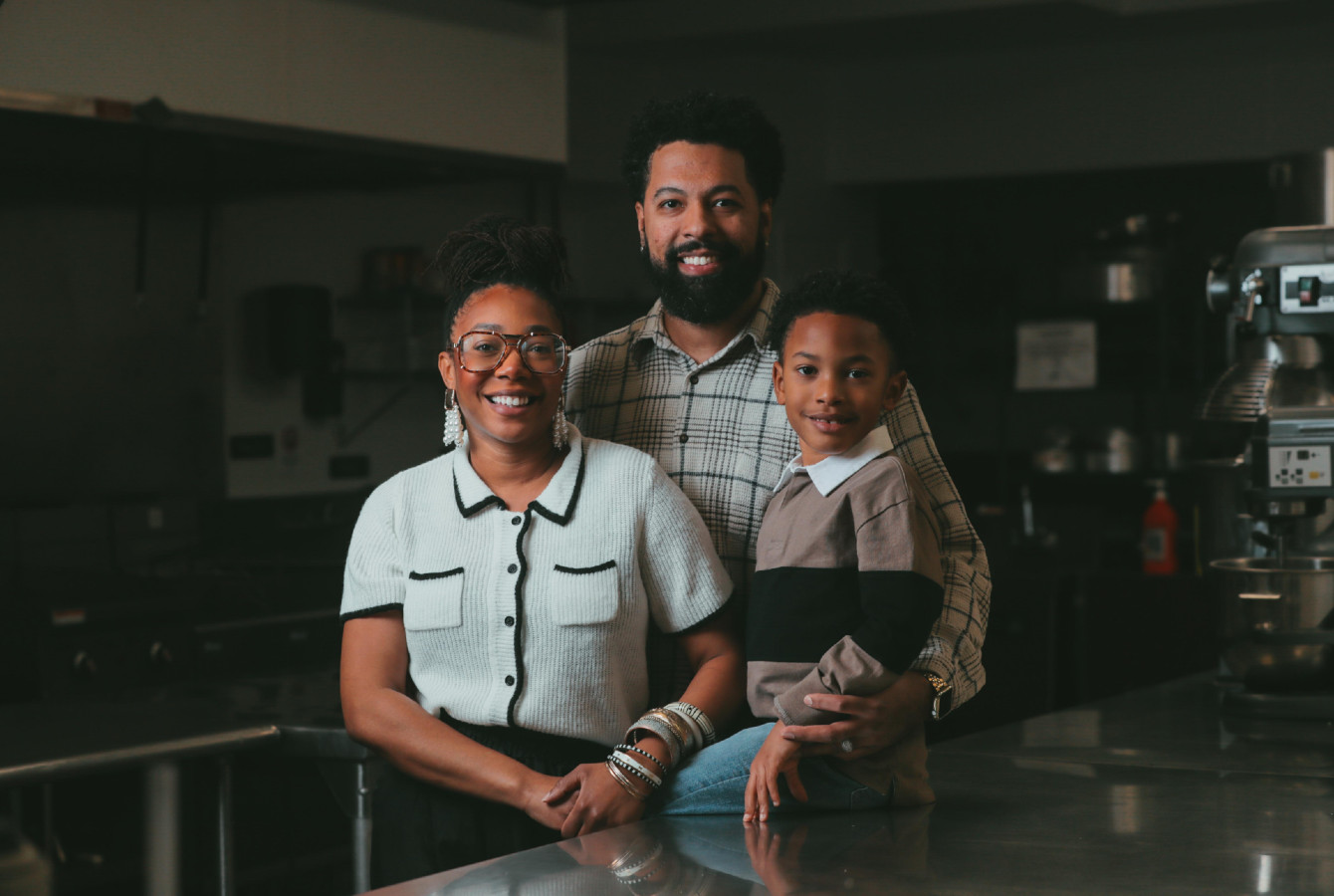
Edited excerpt from Cooking up new businesses by using church space creatively by Holly Quinn for Faith & Leadership.
The Wilmington Alliance had a plan. In 2019, the economic revitalization nonprofit in Wilmington, Delaware would launch a commercial kitchen incubator, helping food entrepreneurs build businesses while utilizing vacant spaces in the city.
But converting vacant warehouse spaces into commercial kitchens was more complicated than anticipated. What the project really needed were existing commercial kitchens that were rarely if ever used. Kitchens that could be renovated, rather than built from nothing.
Enter Grace United Methodist Church. Established in 1866, the active church with a magnificent chapel and stained-glass windows is known for its community outreach. At one time, the large kitchen in the basement was used often. By 2019, it was not.
The idea of using a church kitchen seemed impracticable at first. How would a church share space with entrepreneurs from the community? What were the risks? Was it sustainable?
The Rev. Chelsea Spyres was working part time for Grace UMC and Riverfront Ministries in January 2020 when she heard about the project.
“At the time, the Riverfront board was starting to ask, ‘How do we invest more deeply physically in the city?’” she said.
“For Riverfront, the communion table is this reminder of God’s presence with us, of belonging. But also, we talk a lot about how the communion table calls us to create other spaces of belonging and importance. And so when Grace started thinking about this shared commercial kitchen, Riverfront said, ‘this might be the right thing for us to invest in.’”
Today, Spyres is the pastor and executive director of Riverfront Ministries, the operating partner of the Wilmington Kitchen Collective leading the work alongside Wilmington Alliance and the church partners. The Collective currently serves 16 entrepreneurs in two renovated church kitchens — the original space in the basement of Grace UMC and a second kitchen at First & Central Presbyterian Church.
Getting a business in the food industry off the ground is challenging. Food trucks in Delaware, for example, are required to have access to a commercial kitchen, an often insurmountable hurdle for entrepreneurs with limited resources. Those facing the biggest barriers tend to be people of color and women, and the Kitchen Collective’s cohort of entrepreneurs reflects that.
Fulfilling a need
Joanne Graves and her husband wanted to expand their honey business, GravesYard Apiary, by adding herbs to create electuaries, sweet medicinal pastes that are mixed with hot water or milk.
“You cannot do that legally unless you’re in a commercial kitchen,” Graves said.
The same is true for the Rhythm + Heat spice blends made by husband-and-wife team Lance and Adrienne Williams. Inspired by flavors from her St. Louis background and West Indian heritage, Adrienne adapted her cooking to be flavorful yet low in sodium.
The Kitchen Collective not only gives them access to a commercial kitchen space to make the products legally; it also helps guide them through the complexities of business ownership. Currently, Rhythm + Heat spices are sold through their e-store and in Wilmington.
Startup incubation as ministry
Laura Viau, the pastor at First & Central Presbyterian, immediately saw the Kitchen Collective as an extension of her ministry. Still, running a kitchen incubator inside a church has its challenges. Saturday mornings at First & Central are especially busy in the winter, between entrepreneur activity and the church’s ministry of opening its doors to people who need a place to get warm.
“This has given us an opportunity as leaders in the church to think, ‘How do we find a way to support these [entrepreneurs] that we’ve made a commitment to, and take care of our neighbors who are also in need of support?” Viau said.
Balancing kindness with business has had an impact on the Kitchen Collective’s entrepreneurs, who have helped build a close-knit, collaborative community. A far cry from the hypercompetitive style of entrepreneurship seen on TV, the Kitchen Collective stands by the idea that community and caring is good for entrepreneurs.
“Early on, it became the foundation for us, of caring about the whole person and their business goals,” Spyres said. “We had so many members who said, like, ‘Why do you care? Why are you as a pastor spending all your time building this shared kitchen? I’ve never had a church care about me in this way.’”
The congregation of Biltmore United Methodist Church sold their property and is devoting their energy and resources toward responding to Asheville, North Carolina’s most pressing social needs.
The congregation of Biltmore United Methodist Church sold their property and is devoting their energy and resources toward responding to Asheville, North Carolina’s most pressing social needs.
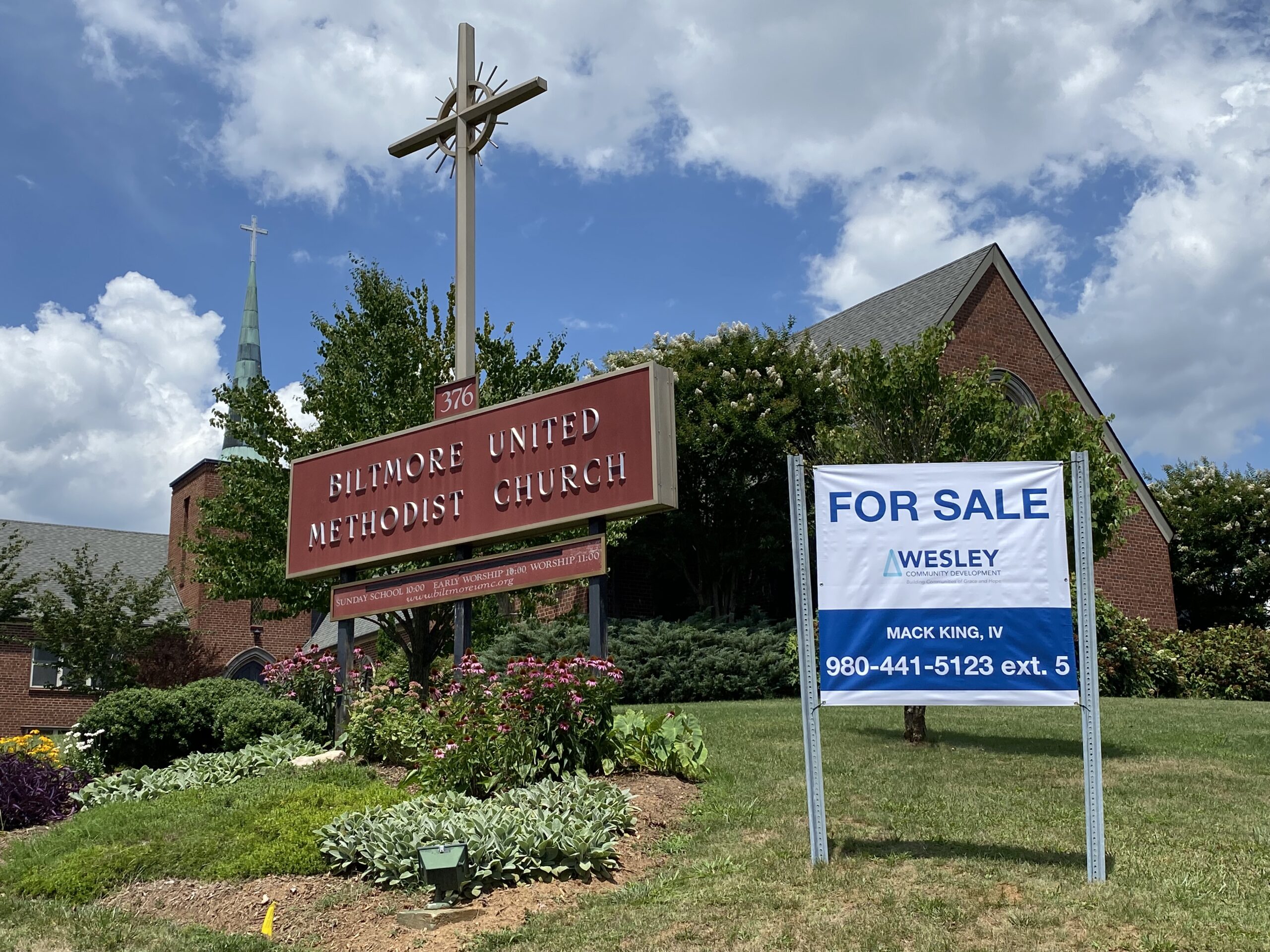
Republished with permission from Wesley Community Development news. By Mack King, Senior Director of Real Estate Services for Wesley CDC.
The congregation of Biltmore United Methodist Church has voted to sell its property and devote its energy and resources toward responding to Asheville’s most pressing social needs.
“The church is the people – not the building,” said Mike Moyer, chair of the Biltmore UMC Church Council. “We are a smaller community now, and we want to be free to be the hands and feet of Christ.”
The decision comes after more than two years of study and listening sessions to consider the church’s financial condition, prospects for growth and market value of the 1.9-acre property. Assisting with the sale is Wesley Community Development Corporation, a United Methodist-affiliated, non-profit real estate firm that helps churches re-purpose and/or sell property with an eye toward ministry and stewardship.
Acting as stewards of the history
Biltmore UMC’s stately, red brick campus overlooking Hendersonville Road has welcomed Methodists since the years after World War II, a time when church attendance peaked in the United States. As recently as the 1990s, the church was drawing 250 for Sunday worship.
But the opening of Interstate 40 next to the campus created geographic challenges. The church found itself separated from central Asheville, overshadowed by an interchange, and, in more recent years, surrounded by medical offices and commercial buildings. Meanwhile, population growth shifted southward toward Skyland, Arden and Fletcher, making it harder to attract congregants.
COVID-19 added a new layer of difficulty. The church halted in-person worship and community support groups, and ceased operations with the Asheville Creative Arts Preschool.
Faced with ever-increasing expenses for maintenance, utilities and upkeep, the leadership team began considering a different future. Church leaders drew inspiration from their experience in Seeds of Change, a series of workshops led by Wesley CDC for churches to learn how to better use their properties for more effective ministry.
Wesley CDC is the official property manager of the Western North Carolina Conference of the United Methodist Church. Part of its mission is to help United Methodists explore the demographics and challenges of their communities.
Responding to needs in Asheville
Wesley CDC emphasizes the idea that churches serve as anchor institutions of their communities. Oftentimes, however, the physical spaces are outdated and no longer suited to the needs of the users.
In the case of Biltmore UMC, the mission resides in places where people are hurting. Proceeds from the sale will fund an endowment to address homelessness, food access, health care, children’s needs and other priorities in partnership with local nonprofits. These are big issues in a city with the highest cost of living in North Carolina, according to a recent analysis.
The congregation will consider multiple options for a new home – perhaps leased space or a shared arrangement with another church.
Woven into the vision is a commitment to racial justice. The protests following the murder of George Floyd last year prompted the congregation to embark on conversations and calls of action to end personal and systemic racism.
“My hope and prayer is that we, as the Church, can rally around the injustice in our midst such that our world can be changed,” Pastor Lucy Robbins told the congregation. “And that begins locally.”
Biltmore UMC already partners with a number of local organizations, including Haywood Street Congregation, a United Methodist mission church that engages adults living with mental illness, addiction and homelessness.
The endowment could provide seed money for nonprofit partners to launch new initiatives. Church leaders envision an ongoing ministry of presence for whichever projects they take on.
“There’s no shortage of things we could plug into,” Moyer said. “And we don’t want to just give out money — we want to be invested. If it means turning dirt, painting a wall…we’ll still be Christ’s disciples.”
***
Wesley CDC continues to position itself to assist faith-based leaders across the nation with it’s Blueprint Network program. Their work has expanded from Western NC to multiple states helping various denominations navigate their real estate opportunities. Visit WesleyCDC.com to learn more.
A community group in North Carolina asked to use a church's lawn for a small community garden. The church agrees to share their lawn, free of cost, and new neighborhood relationships are formed.
A community group in North Carolina asked to use a church's lawn for a small community garden. The church agrees to share their lawn, free of cost, and new neighborhood relationships are formed.
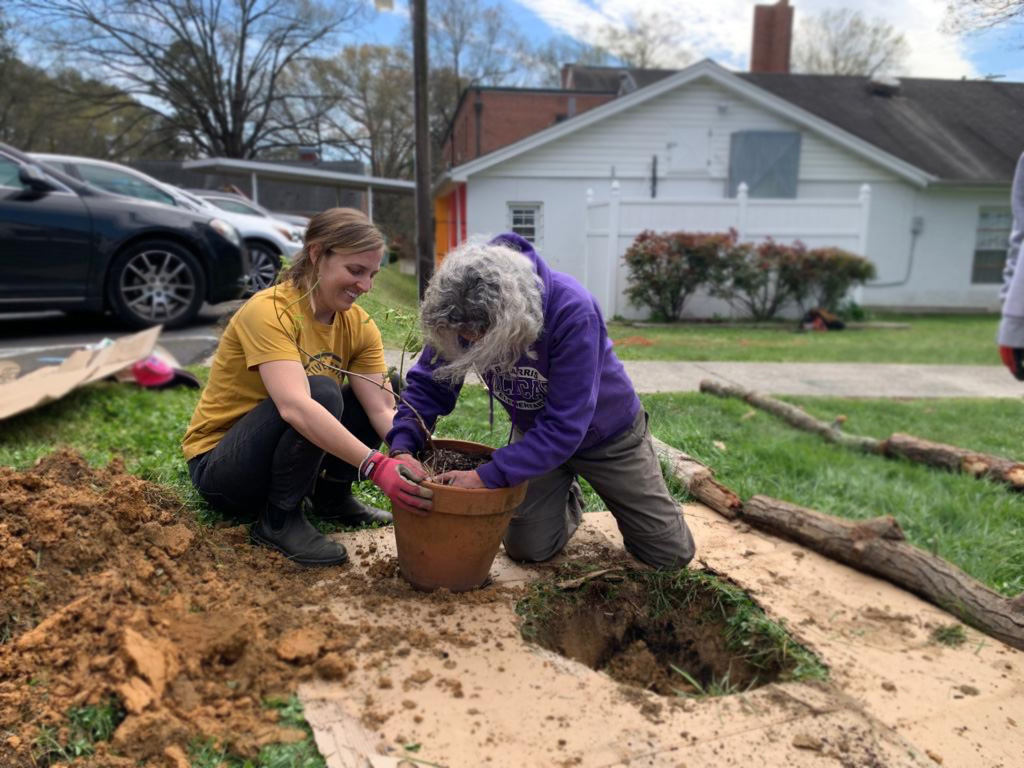
By Kelly Dunlap
Several years prior to the COVID-19 pandemic, community members in Durham, North Carolina gathered to learn about injustices in the city’s history and to organize for a more equitable future. When the pandemic hit, the group asked how, together, they might tangibly support their neighbors. They created North Durham Mutual Aid and began outreaches like “free markets.” While brainstorming other potential neighborhood resources, one of the organizers suggested a community garden.
As they began investigating properties around town where they might grow a garden, an organizer thought of the large lawn at the church across from her house. The organizer already knew Rev. Casey Mursten, pastor of St. Paul United Methodist Church, so she approached her with the idea. Casey was excited by the prospect and invited the team to take the idea to the church council.
The organizers presented the council with their proposed map of the garden and community-building vision. The church council wanted to know it would be well maintained and the long-term plan for the space. After a productive discussion, the council voted to let the organizers use the yard space for the garden, free of charge. While the church would not take the lead in maintaining the garden, several church members with an interest in gardening – or merely a passion for connecting with the community – decided they’d roll up their sleeves and get involved by attending the monthly workdays.
In late 2022, neighborhood and church volunteers began planting. The garden, which they named Neighbors Growing Together, was given wide paths so it would be accessible to those with mobility aids. It was designed as a permaculture food forest, meaning it would be low maintenance and sustainable, and produce edible perennials. Trees – including a walnut and a persimmon – and seeds were donated by community members. In its first year, the gardeners have tended to the trees and grown flowers, strawberries, and more.
Rev. Casey sees the garden’s presence on the church property as spiritually significant. She chose to host their Easter sunrise service in the garden as she preached about Christ as the gardener and their call to be co-creators with God. She also sees alignment between the garden’s mission – provision in response to needs, environmental sustainability, and genuine relational connection – and her church’s mission. While the coordinators maintain responsibility for the garden’s upkeep, she happily goes out to water the garden as needed. She feels invested in its success: “I want it to flourish.”
The idea of putting the church property in service to the neighborhood is not a new one to this worshiping community. They have a “village playground” – the only greenspace in the neighborhood – and basketball courts that are open to the public. They have also operated a music venue for local artists in a small building on their property for 15 years. Still, when approached with the garden idea, Rev. Casey saw an opportunity for even deeper connection, and a project in harmony with the church’s theology and values. “When they came to us with the idea, I thought: We can’t pass this up.”
Operating an initiative with no religious affiliation on religious property has the potential to produce tensions, and it was a factor discussed by the organizers. One organizer explained, “Ultimately, we felt comfortable using the space because Pastor Casey was explicitly welcoming of those who might not feel comfortable in a religious space – such as those who hold different or no religious beliefs, and members of the LGBTQ community.”
Rev. Casey is grateful for the ways the garden has strengthened relationships between the church and neighbors. “When you have your hands in the ground, walls come down and conversations happen,” she says.
The organizers have big dreams for the garden. They hope to grow the garden so they can share the harvest with those who are food insecure, while continuing to provide a safe place for neighbors to connect. One organizer hopes that it can serve as a model for similar projects and that other small-scale, community-maintained gardens pop up on church properties around the city.
“It’s a great way for religious folks – who have this great resource – to interact with those who are non-religious,” she says. “It’s a beautiful collaboration.”
Conversations among church and community members lead to thriving neighborhood program that provides job training, an after-school program for children, low-cost clothing, a weekly lunch, food pantry, and more.
Conversations among church and community members lead to thriving neighborhood program that provides job training, an after-school program for children, low-cost clothing, a weekly lunch, food pantry, and more.
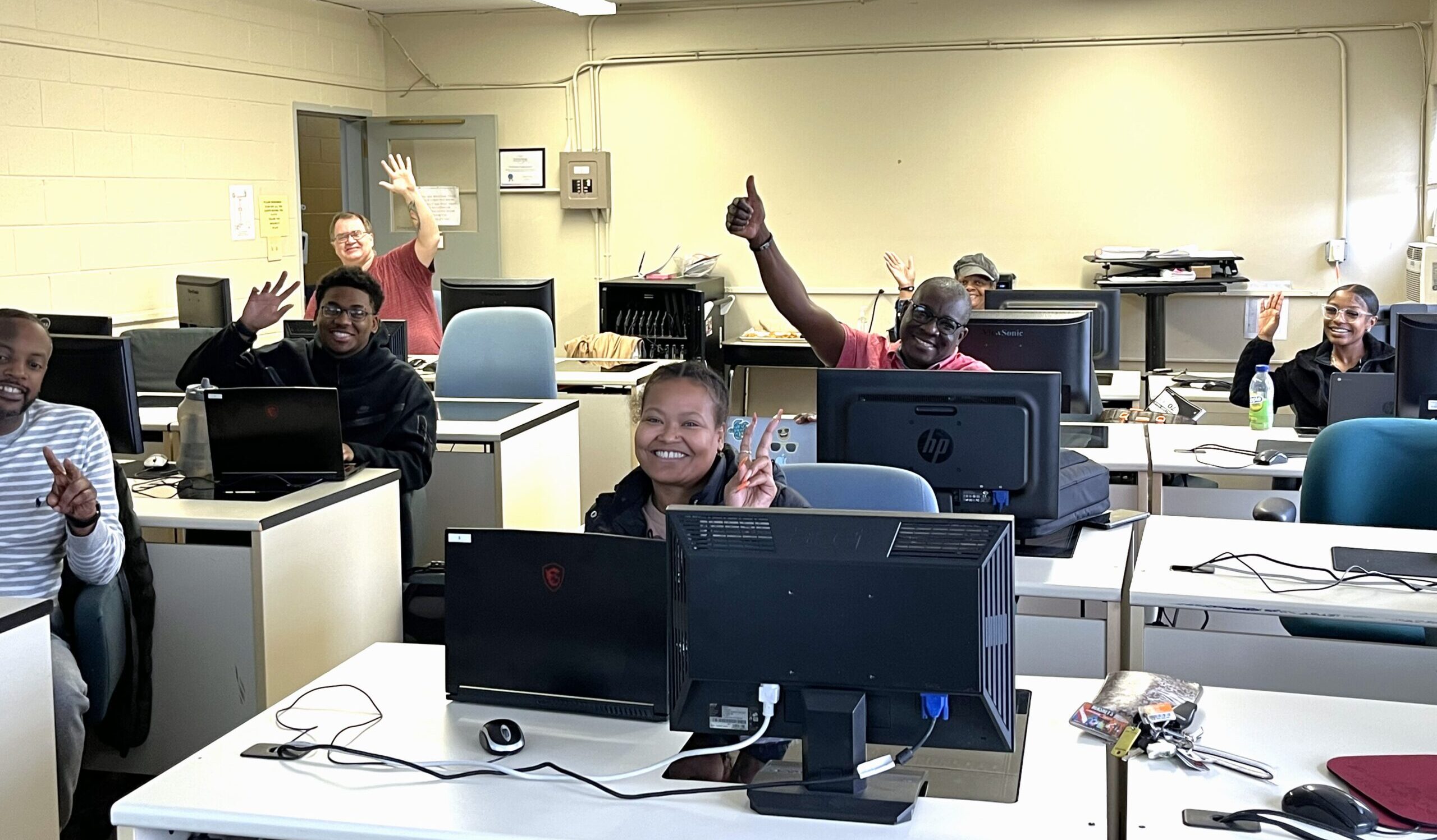
By Ray Marcano
The Rev. Peter Matthews looked beyond the pews of his church and saw a neighborhood that needed his help.
While it hasn’t been easy, the efforts have turned Matthews’ McKinley United Methodist Church into an indispensable part of its Dayton, Ohio community.
McKinley, Ohio’s oldest African American Methodist Church, sits in zip code 45402, one of the 23 poorest in the state and the overall poorest in Dayton. This zip code’s median income of $37,566 is 43% below the state’s median of $65,720. Nearly one-third of residents have incomes below the poverty level.
Making matters worse, the COVID-19 pandemic threatened to derail his efforts and hard-won gains.
By 2020, McKinley had rebuilt its membership to 200 parishioners, up from the 39 members Matthews pastored when he took over in 2016.
But when the pandemic hit, Matthews knew McKinley needed to push even harder to transition from just delivering the word from the pulpit to preaching that the church was dedicated to helping the community meet its needs.
“With the onset of COVID-19 in 2020 we had to look both within ourselves and upward to God simultaneously,” he said. First, he partnered with a local COVID mobile clinic that tested 2,500 people. That opened avenues for him and his pastoral staff to engage with the neighborhood.
There were “countless hours of conversations with both persons who live in the community and the church who now began to see itself as more than merely a place to worship on Sunday morning.”
Those conversations led to a program that’s become core to the neighborhood.
The church started the Dayton Equity Center, which provides a number of services including job training, an after-school program for children, low-cost clothing, a weekly lunch, food pantry, and more.
The programs serve 4,500 people annually, Matthews said.
The center’s motto “Opportunities For All,” comes from the church’s social principles that affirm the value of every person.
The effort carried risk because the church sought to build a sustainable social service infrastructure. The small church staff took on roles in the equity center in addition to church duties. Matthews found himself fundraising to keep the center afloat. He spent time reaching out to community leaders and businesses to push for job training initiatives at the church.
His congregation wondered whether he was paying enough attention to their needs.
Along the way, the church had to overcome difficult barriers. Churches aren’t “suited to offer basic needs to working class and persons below the poverty line,” Matthews said. Historically, churches take care of those in their flock and, while they offer some services, they don’t have the expertise to implement a full-fledged social service program.
But McKinley’s role in an urban area required its leaders to “lean into their faith in systemic and holistic ways” to become a community anchor.
That’s what McKinley has done, by offering opportunities to help people position themselves for a better life. For example, the equity center offers a six-week boot camp that provides entry level certification in cyber security. Those jobs pay $60,000 and up, a life-changing salary in an area that needs as many of them as it can get.
McKinley’s leadership continues to push on. The equity center has led to their newest initiative, The Global Village. The consulting firm recruits and works with future urban leaders and congregations to help improve their communities. The project currently has contracts with two seminaries, 11 HBCU’s and 11 churches across the country.
With all of these endeavors, and more to come, Matthews calls the stories he hears from people his “quilt of inspiration.”
It’s a quilt that isn’t finished.
An AME church and a Latino congregation united their congregations and community outreach efforts.
An AME church and a Latino congregation united their congregations and community outreach efforts.
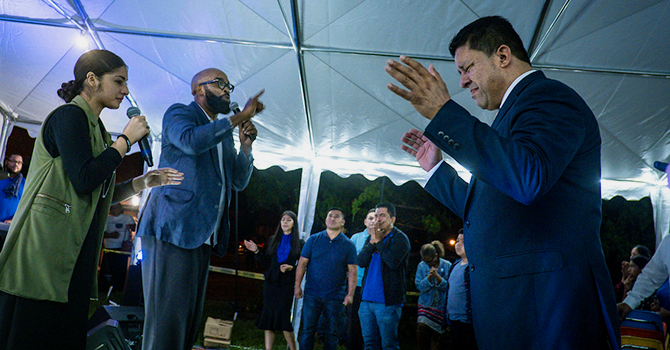
Excerpt from Sharing a building leads to a shared mission for an AME church and a Latino congregation by Leslie Quander Wooldridge for Faith & Leadership.
Se pueden leer la traducción en español aquí (Read this story in Spanish)
On a bright Sunday morning in September, the congregation of Turner Memorial AME Church gathers at its Hyattsville, Maryland, building. A pastor is delivering an impassioned message. Applause crackles through the space as worshippers lift their hands under the sanctuary’s vaulted ceiling.
But the person speaking from the pulpit is not the Rev. Dr. D. K. Kearney, Turner Memorial’s pastor since 2015. The preacher is the Rev. Cesar Moreno, a minister originally from Guatemala, who is sharing the day’s word in Spanish.
For nearly two years, the pastors’ churches—one an African Methodist Episcopal (AME) congregation more than a century old, the other a largely Latino nondenominational congregation established in 2010—have been sharing the Turner Memorial building.
It’s more than just a transactional arrangement. Church members have worked carefully and intentionally to build the relationship between the two congregations, which includes regular shared services and, this fall, the “Soul Saving September Revival,” a four-week joint endeavor. It involves the close friendship of the two pastors, as well as the efforts of a young interpreter, Josary Moreno Mejia (a preacher in her own right and the granddaughter of Cesar Moreno).
“In Christ, there is no Jew or Gentile. There is no race or color,” Kearney says from the pulpit after Moreno’s message concludes. The Turner Memorial pastor looks out on the congregation, which includes members of Iglesia Evangelica Horeb Asamblea de Dios (Mt. Horeb for short), the church pastored by Moreno and his wife, first lady Loly Moreno.
“We cannot allow the world’s culture of division to separate us. We cannot allow the enemy who comes to steal, kill, and destroy to separate us,” Kearney continues. “We are one in Christ Jesus.”
This focus on unity exemplifies Turner Memorial’s activities, efforts deeply rooted in the church’s traditions—including, for example, its long-standing relationship with a local synagogue. Kearney is now working to unify the Turner Memorial and Mt. Horeb congregations under one roof, as together they reach out to the surrounding community.
This work is important to both pastors.
“As followers of Christ, we are to follow Christ’s example. And the example which he laid out during his ministry here on earth centered, in my opinion, around community, and building community, and living in community,” Kearney said. “As a church, that which represents Christ, we are to serve our community with the hope [that] by serving the community we win persons over to the family of God.”
Moreno agreed. “Speaking spiritually, people need salvation. People need to be on a better path. This is the objective, to teach people the path of God, . . . so that new generations can have hope and live better,” he said.
When Kearney became pastor of Turner Memorial in 2015, he found that the church’s surrounding community was in large part Latino. He wanted to reach those community members and began considering different ways the church might connect beyond its walls. He also began leading the church in a series of workshops focused on deploying spiritual gifts to make an impact.
In 2017, Moreno and his granddaughter began attending Turner Memorial services while seeking a space for Mt. Horeb.
When the two pastors met, they realized they could create opportunities for their congregations—one English-speaking, one generally Spanish-speaking—to worship together. They began partnering in December 2017.
Today, Mt. Horeb holds its own services in the Turner Memorial building. But on the second Sunday morning of each month, its members join Turner Memorial’s. There, Moreno preaches in Spanish while his granddaughter interprets.
And on the fourth Sunday evening of each month, Turner Memorial members go to Mt. Horeb’s service, where Kearney delivers a message that Mejia translates into Spanish.
“We have come to let the enemy know that no race, no language barriers will stop us. We are not trying to build walls, but we are building bridges,” said Kearney.
An enterprising pastor in Wilson, North Carolina pushed his congregation to revive its nonprofit and launch a plan to improve seven properties.
An enterprising pastor in Wilson, North Carolina pushed his congregation to revive its nonprofit and launch a plan to improve seven properties.
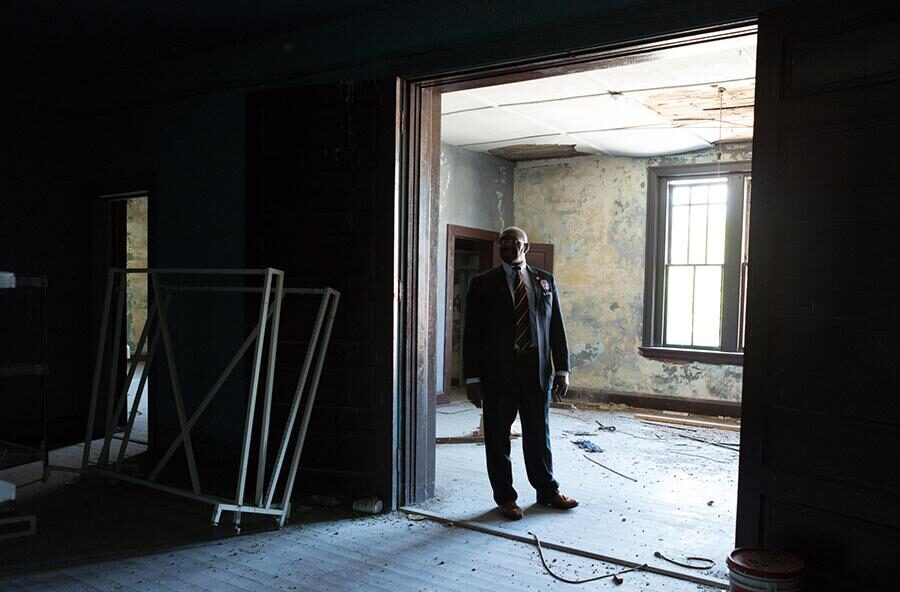
Excerpt from A renovation project brings income to a church nonprofit and vitality to a former tobacco town by Bridgette A. Lacy for Faith & Leadership.
When the Rev. Dr. Michael Bell arrived at St. John AME Zion Church in 2004, he saw the blight surrounding his historic church and walked around the area seven times. The dilapidated houses needed something beyond local government help.
“I went straight to the Lord,” he said. Like Joshua in the Bible, Bell claimed the historically African American neighborhood of East Wilson. It was his Jericho.
The preacher from Jamaica started small, focusing on helping people in the neighborhood, first by hosting summer camps for children and later by converting the church parsonage into a shelter for homeless men.
Leveraging the capacity of the church’s nonprofit, the St. John Community Development Corporation, Bell worked to revitalize the area by buying deteriorating buildings, renovating them, and acting as landlord of the small businesses housed there.
“I believe in microenterprises,” Bell said. “Churches should not sit around and wait for tithings and offerings, because there are poor folks in your congregation who can’t give because they don’t have it to give. But through microenterprises, you can stimulate the economy and put people to work.”
Bell and the nonprofit are passionate about their mission to help at-risk youth and revitalize a section of Wilson left in despair by a changing economy.
East Wilson was once a predominately African American, working-class enclave. Black men working in the tobacco industry lived with their families in the small houses owned by their employers.
When the tobacco industry dried up and the local economy shifted to higher-skilled manufacturing jobs, the community lost its luster as landlords abandoned their properties or let them fall into disrepair. St. John AME Zion, a congregation founded in 1868 and located in a historic red-brick building, created the St. John CDC in 1998 to provide social and educational services as well as economic and workforce development.
But when Bell arrived as pastor in 2004, it was dormant. They had a 501(c)(3) and $60 in the bank. Nothing more. Through careful planning, fundraising, good negotiation, and some borrowed funds, the CDC has turned around, taking the community with it.
In 2005, St. John CDC established the Save A Youth program, which provides after-school care and summer camp for youth in grades K-8. It has served more than thirty-five hundred children.
Then it launched the downtown revitalization project, which was designed to provide funding for the youth programs as well as jobs and community development.
The nonprofit is also working on converting space into affordable apartment lofts and adding a laundromat and a small grocery store.
For Bell and the St. John CDC board, community development is just one aspect of the mission.
The real success lies in helping the community’s youth through its after-school programs, summer camp, gang prevention, vocational training, and other services.
At the end of the 2014-15 school year, nearly 97 percent of student participants tested in the after-school program performed at or above grade level. In June, the Save A Youth program held a graduation ceremony celebrating the academic successes of the 365 children in the program. St. John board member Ward said the graduation ceremony was a “real milestone,” and that seeing people from state officials to parents and grandparents at the event was a confirmation that their work is making a difference.
Bell said he’s not finished with his brand of urban renewal yet. “I want to go from block to block and remove the blight and create beauty and jobs.”
A rural Tennessee church closes with one final, old-time singing and a donation to a Christian disaster relief agency.
A rural Tennessee church closes with one final, old-time singing and a donation to a Christian disaster relief agency.

Excerpt from A final song, a familiar end by Cheryl Mann Bacon for The Christian Chronicle
The final assembly of the Ragsdale Church of Christ was an old-time singing, the kind they used to have every fourth Sunday.
Charter member Elvie Sellers, 97, doesn’t get out often, and her family wanted a singing on that last Sunday so they could bring her one more time.
And so they sang. Old standards, sentimental favorites. Then about five minutes till three, Mike Sellers, Elvie’s son, took his place behind the oak table engraved with the words “In Remembrance of Me.”
After asking if any had been unable to partake of the Lord’s Supper that morning, Sellers carried the tray down the center aisle to his mother’s seat—two rows from the back—to serve her one more time.
A final prayer. One verse of “Blest be the Tie.”
And they were done.
Ragsdale, Tennessee used to be a community of its own; now it’s part of Manchester, on the edge of town. After exiting I-24 about an hour south of Nashville, the two-mile stretch of Ragsdale Road feels like a retreat in time.
The eighty or so people who came to sing on Sunday, March 6, represented twenty-one congregations from Coffee County, Tennessee, and adjacent communities, people who came to say goodbye to the church where family or neighbors or friends had once attended.
It had been a long time since that many folks filled Ragsdale’s white-block building. The week before, there were only eight, including the preacher. One member said, “It’s hard to operate and do any good when you’ve only got eight to ten people.”
The pastor attributes Ragsdale’s decline to location, societal changes, and economics. Young people have left the region seeking employment, and generational changes contribute as well.
A congregation that was thriving fifty years ago dwindled until closing its doors was the only option.
The church began as a “planter church” in the early 1950s; such churches were intended to take the gospel out of the county seats and population centers to smaller communities. The congregation met for a while in a school building, often with just a handful of women and one man who led singing, preached, and served Communion.
After a few years, a local family donated land to build the church building.
In the thriving years, the congregation supported at least three men as they prepared to become preachers.
Neat, handwritten entries in a worn red ledger from the 1970s detail other Ragsdale efforts—support for Samoa Mission, the East End church, and Sunny Acres children’s home.
The gathered congregation on that last Sunday were invited to “think of all the good. Remember that—all the good.”
A few years ago a young farmer bought the acreage adjoining the church. The land where the church building stands will become his as well in exchange for his donation to Churches of Christ Disaster Relief Effort Inc. The relief agency responds to major disasters in the U.S. by sending trucks of food, water, and supplies to local churches that aid disaster victims. After final expenses are covered, any remaining church funds will also go to the agency.
The building will be torn down, replaced by fields of corn or soybeans or maybe wheat.
One lifelong member said she hopes Ragsdale will be remembered as a congregation “that put all of our faith and trust and love into the Lord who we knew would be walking beside us every step we took—if we were walking like he had told us to do.”
The pastor concluded his final sermon by saying, “It’s my duty to encourage members to start worshipping in another congregation of your choice. We have plenty of places to worship our God, and we’ll go and worship regularly. We step into the annals of church history.”
People keep asking him, “What are you going to do?” he said.
“Well,” he replies, “I’m going to worship God every Sunday.”
Bethel A.M.E Church of Ardmore responded to food insecurity in their community by starting a garden on their property. The project started with one bed and now has 15 that produced 1,200 pounds of food in 2022.
Bethel A.M.E Church of Ardmore responded to food insecurity in their community by starting a garden on their property. The project started with one bed and now has 15 that produced 1,200 pounds of food in 2022.

By Ray Marcano
Se pueden leer la traducción en español aquí (Read this story in Spanish)
In 2018, the Bethel A.M.E Church of Ardmore in Lower Merian, PA met with Trellis for Tomorrow, a non-profit with expertise in organic farming. The church and Trellis partnered to tackle an inconspicuous problem in one of the state’s wealthiest townships.
Food insecurity.
The Rev. Carolyn Cavaness, Bethel’s pastor, knew that some families would have difficulty feeding their children during the summer months since 10% of the community’s students relied on free or reduced meals at school. Partnering with Trellis, she created The Bethel AME Church Community Garden and Ardmore Victory Gardens, which provides free, fresh produce for anyone who needs it.
The garden started on church property with one bed and now, five years later, has 15 that produced 1,200 pounds of food in 2022, according to its annual report. The program has helped build 50 garden beds for local families and organizations. The garden operation is now so large it’s hired a full-time staffer to supplement the program’s 50 current volunteers and has a budget of $75,000.
Cavaness called Trellis “the project’s architect” because it had the expertise to get the program off the ground. Building garden beds isn’t as simple as putting seeds in the ground. Cavaness learned which crops would thrive in the northeast, what type of irrigation system would be best for her crops, whether the beds should be in direct sunlight, and much more. Today, Ardmore Victory Gardens uses their newfound skills to help people in the community with questions about their gardens — such as, what kind of fence best keeps out squirrels.
In addition to learning the ins and outs of gardening, Cavaness had two other issues to confront. She had to convince her 125-member congregation of the project’s overall benefit, and village residents that people were going hungry in their affluent community.
Some congregation members saw a risky project with no direct benefit to the church and worried about the cost. The water bill might increase, some said. The effort may divert focus from other projects. But Cavaness said she doesn’t use church funds and received grants and other contributions to keep the garden growing.
Cavaness also experienced some skepticism because Lower Merian is one of the wealthiest townships in the state, with a median annual household income of nearly $149,000. If you live here, how could you not afford food, Cavaness would hear. But she had a simple message: “This is real. This is in our neighborhoods,” she said.
The skepticism has faded. Now, the Victory Garden project has grown into a community staple with festivals, lectures, and workshops, all around themes of food insecurity, empowerment and justice, and how these gardens can help make people become self-sufficient.
The project helps other churches build beds on their property and provide seed for people who need it. The program also serves as support for people of color interested in agriculture. It hosted a webinar with the Black Church Food Security Network, which empowers Black churches with land to grow food. In conjunction with one of its partners, Haverfarm, it hosted Amirah Mitchell of Sistah Seeds, which educated Black and brown growers on culturally important seeds.
The AME Church was founded on principles of self-help and self-determination. “This is core of being self-sufficient,” and meets the church’s mission and values, Cavaness said. “We took care of ourselves, each other, and the community at large. If somebody needs it, we have it here.”
Lutheran Church of the Reformation rents out space to Hill Havurah, an independent, Jewish community. It’s a landlord-tenant relationship that has financial benefits to both sides, but it is so much more than that.
Lutheran Church of the Reformation rents out space to Hill Havurah, an independent, Jewish community. It’s a landlord-tenant relationship that has financial benefits to both sides, but it is so much more than that.

By Dan Holly
The Lutheran Church of the Reformation is an established church in Washington, D.C. that dates back to 1869, but if you visit on a Saturday you might be surprised. Instead of Christian symbols inside, you’ll see an ark holding the Torah. A rabbi will be leading a Shabbat service.
The church has rented out space since 2016 to Hill Havurah, an independent, Jewish community founded in 2001 that had never had a permanent home until it found space in an unusual place – inside the Lutheran Church of the Reformation. It’s a landlord-tenant relationship that has financial benefits to both sides, but it is so much more than that.
Jarrod Jabre, director of operations for Reformation, says that membership has shrunk from its peak and is down to about 400. The building is much larger than the church needs, Jabre said.
“With a building like ours, when you walk through and there’s not somebody making a joyful noise,” Jabre said. “So to be able to have other groups worshiping in the space and utilizing the space for that purpose is fantastic. It keeps the place alive.”
Alan Shusterman, Hill Havurah’s executive director, said the combined congregations produce a synergy that helps both groups. For instance, they combined forces recently on a project to feed immigrants.
“We are both relatively small congregations, so we’re doubling the number on either side,” Shusterman said. “Instead of 300 strong we’re now 600 strong. That changes what we can do.”
The partnership began as a financial arrangement for both sides. Reformation – located on Capitol Hill, near the Supreme Court – can hold as many as 450. “We have space that we do not use, that we cannot use,” Jabre said. The church was not desperate, but church leaders realized that they had space in a prime location that was going to waste, Jabre said.
Meanwhile, Hill Havurah had a growing congregation and, in 2016, appointed its first rabbi. Someone at Hill Havurah knew someone at Reformation and found out they were looking for a tenant and a relationship was born, Shusterman said.
For their part, Hill Havurah gets space at a below-market rate, he said. The congregation not only has offices at Reformation, it also uses the church for its preschool.
Both sides say the joint occupation has required some adjustments. Conflicts are minimized by the fact that Hill Havurah’s services are on Saturdays and Reformation’s are on Sundays. Plus, Hill Havurah’s services are small enough – 40 to 50 people – that they can be held in the church’s St. John’s Room rather than the sanctuary.
At least that’s what the room used to be called; the Saint John’s Room has come to be known as the Shalom Room. Both congregations call it that.
On high holy days, Hill Havurah moves to the church’s sanctuary, which has more space. Reformation leaders remove the crosses from the sanctuary, so Hill Havurah feels comfortable worshiping there. Similarly, Hill Havurah uses a portable ark rather than a built-in model that a typical synagogue would use. When they are not using the Shalom Room for services, the ark is stored in a closet.
Both Shusterman and Jabre said the arrangement has been met with little resistance from their congregation’s members. “I have not heard a single negative word. …Our congregation is enamored with being able to have Hill Havurah here with us,” Jabre said.
Shusterman said the joint occupation has led to a lot of interfaith dialogue, but said it has been mostly at the clergy level. They would like more of that dialogue to filter down to the congregation but “we’re not sure what that looks like,” he said.
But Shusterman said the dialogue has been enriching to him.
“What’s interesting to me,” he said, “is that when you get to know other religions you realize that we’re struggling with the same things…We’re all trying to understand the same big life themes.”
After a flood did major damage to Bethel Church of Morristown, its pastor had a vision of rebuilding their property with support from outside of the congregation and to meet the needs of the larger community.
After a flood did major damage to Bethel Church of Morristown, its pastor had a vision of rebuilding their property with support from outside of the congregation and to meet the needs of the larger community.
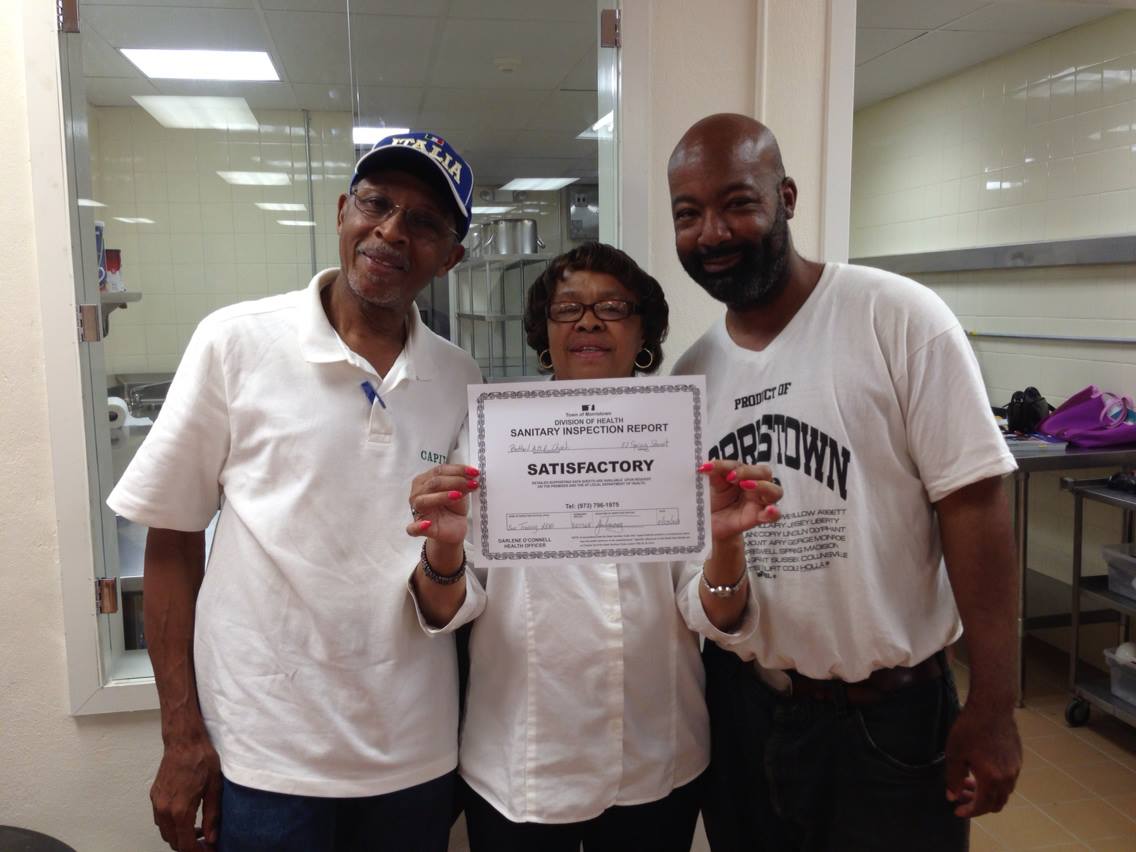
Adapted from A devastating storm becomes a turning point for a historic African Methodist Episcopal church (December 2020) by Ray Marcano, with permission from Faith & Leadership.
In late August 2011, Hurricane Irene roared up the East Coast and nearly destroyed Bethel Church of Morristown, New Jersey.
The storm did such damage — including to the organ, piano and walls — that it would cost almost $1.5 million to fix. The church had no flood insurance, and the congregation of about 75 active members couldn’t afford the repairs on its own.
Bethel’s senior pastor, Rev. Dr. Sidney S. Williams Jr., knew that in the long term, he would have to raise money from the community to repair the church.
“I felt very strongly that if we were going to the community for support, we needed an impact statement to pay it forward. It was unreasonable to ask without a credible way to serve the community,” Williams said.
The area in which Bethel is located lags in every economic indicator. Almost half of its residents have a household income of less than $50,000 annually. Nine percent of its children live in poverty, and the jobless rate is well above the county average.
Williams had a vision to serve the community and rebuild the church: Bethel would start serving a free meal five days a week, Monday through Friday.
. . .
When Williams presented his vision, some church members didn’t agree. They recalled bad experiences with homeless people sleeping in the pews uninvited, bringing hygiene and security issues. As a result, some left the church.
Others wondered whether the small congregation could support feeding people five days a week.
But Williams had a different take. “It’s great we worship and believe together, but if we’re not living [the mission], what’s the point?”
Still, the adjustment was difficult at times.
“For many, the African American church is their sanctuary,” he said. “Here they separate themselves from the world’s problems. In a sense, we have disrupted that sanctuary…. There have been hurdles from members who thought their spaces were being invaded from people who didn’t think, speak or worship like us.”
For example, Williams reminded congregants who wanted an after-school program for African American youth that it would have to be for all children, including children in the Latino community. He began hosting exchanges with other churches so the members could better understand each other.
. . .
To secure funding for the vision, Williams approached other congregations, civic clubs and the like. It was a local real estate trust that really made a difference — the trust leaders met with Williams and volunteered to build the kitchen and contribute about $1 million of the rebuilding cost.
The rest of the money came from current and former church members, community organizations and grants. All told, it took two years for the church to reopen and the Table of Hope to launch in 2013. During the COVID-19 pandemic, Table of Hope became the leading distributor of food in Morris County, Williams said.
Of course, hunger isn’t the only challenge facing people in the county. Bethel also provides free backpacks to children; annual community health days with free screenings for diabetes, high blood pressure and other ailments; and a program to end homelessness in Morris County.
. . .
Ultimately, the 2011 disaster marked the beginning of a new mission for the church, 170 years after its founding.
None of the folks they serve may ever step into the rebuilt sanctuary. But that’s not the focus, Williams said. “It’s less about church growth and membership and more about social impact. There is no doubt we’re having a social impact.” His core argument that congregations should focus more on social impact than growth is explained in his book, Fishing Differently: Ministry Formation in the Marketplace.
“You cannot confine your ministry to the support you’re able to garner from the members of your church,” he said. “You can find yourself as a conduit or a catalyst to solving your community’s problems, meeting their needs in a way that far exceeds your capacity.”
For Williams, the experience is an example of what can happen when the church serves more than just its own members.
“When you focus on the real needs of the community, the community will rally around you.”
____________
Related resource: Leadership Education at Duke Divinity prepared a comprehensive case study examining this Bethel Church initiative. Read the Feeding the 5,000 case study.
Amid calls for reparations, Arlington Community Church launched a foundation to lend interest-free funds to help Black Americans purchase their first home in their community.
Amid calls for reparations, Arlington Community Church launched a foundation to lend interest-free funds to help Black Americans purchase their first home in their community.
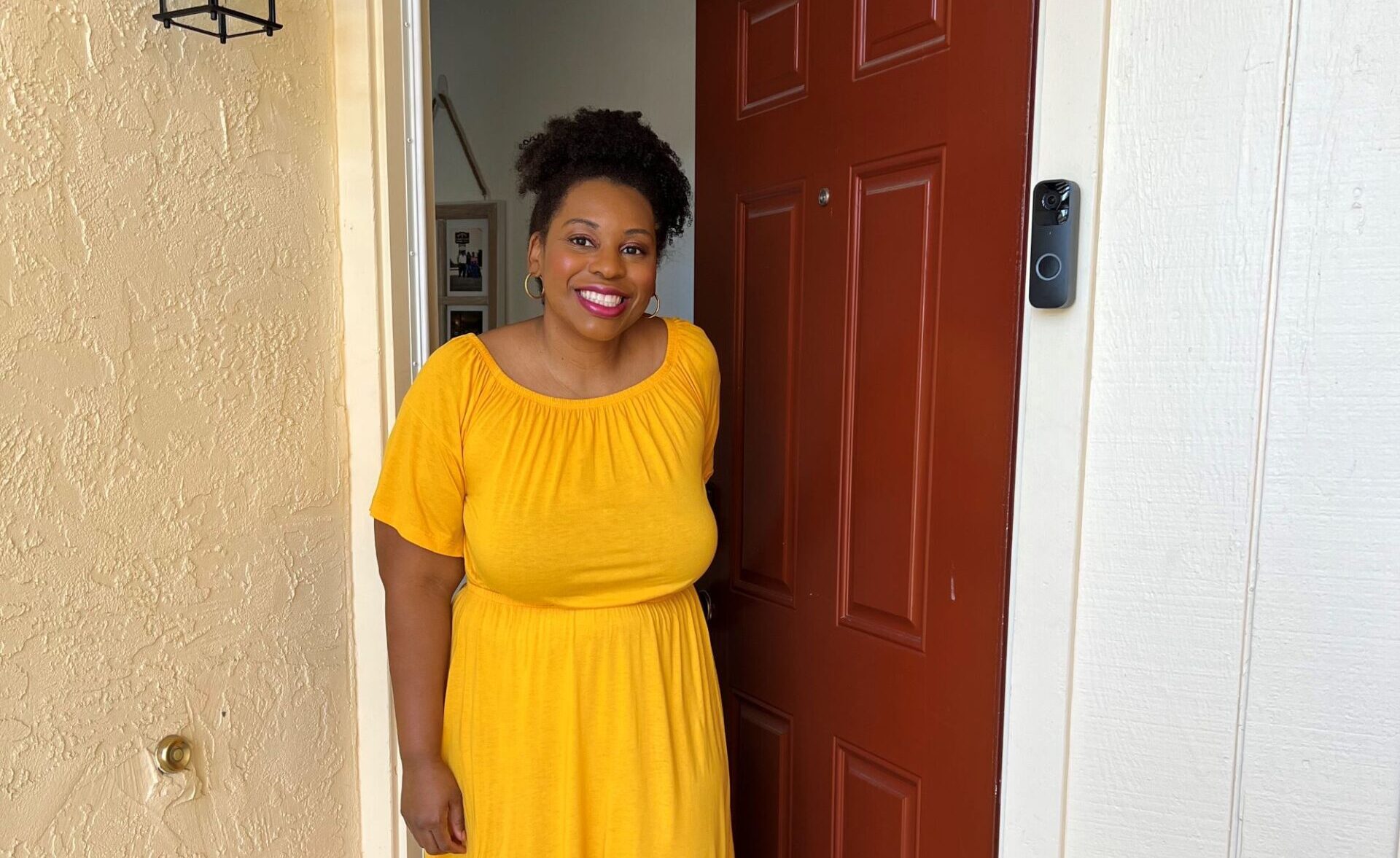
At 35 years old, Astrid Heim knew that buying a home would help to build the foundation she wanted for herself and her future family. She worked in the biotech industry, but when she initially pursued a loan on her own, it wasn’t close to the amount she needed. In 2022, with a loan from Black Wealth Builders Fund, she purchased a three-bedroom condo with that future family in mind.
Black Wealth Builders was launched only one year prior to Astrid’s home purchase, when one California Bay Area church considered the growing call for reparations and how they, as a congregation, could respond.
Members of Arlington Community Church (UCC), a predominately white congregation, had formed an anti-racist discussion group in the wake of the murder of George Floyd, and then moved into action. They decided first to engage in conversation with local Black leaders to learn what the community needed.
“I think it’s important for congregations that want to do this work to find Black folks to do the work with and to get their input and actually be in solidarity with the community,” said Rev. Celestine Fields, pastor of Arlington Community Church.1
In those conversations, one need was expressed over and over: housing.
There were few Black homeowners in their area, a trend which can be traced to segregation, redlining, and the systematic rejection of loan applications and withholding of mortgages from Black Americans. These racist policies and practices, even if not all currently in effect, have had a long-term and significant impact on Black homeownership and the wealth-building opportunity it provides.
Arlington Community Church’s response was to create Black Wealth Builders Fund, a foundation for lending interest-free funds to help Black Americans purchase their first home. In the church’s thinking, the loan fund not only provides a path to home ownership but also expressly welcomes Black individuals and families as members of the community.
Labeling the fund as a “reparations project,” however, has not come without pushback. The foundation was born in a time of national debate on what constitutes reparations and the merits and harms of labeling personal or private efforts as such. The organizers themselves admit that it is an “imperfect” example of reparations, and that ideally the subsidies and down payments would not have to be repaid.2
When the church began fundraising during Lent in 2021, the original goal was to create a fund of $50,000, hoping to help just a few individuals or families. To date, they have raised about $330,000 — with donations from churches, community organizations, individuals, and the California Association of Realtors — and they have provided 15 interest-free loans (to be paid back only when the home is refinanced or sold) and helped 21 first-time homebuyers. Loans range from $15,000 to $20,000 and can be used for down payments, closing costs, or other needs associated with buying a first home.
Susan Russell, one of the founders of the fund, said, “This project has succeeded beyond anything we thought possible. We were hoping to raise $50,000 to help just a few Black homebuyers, but we quickly realized that interest in this project—and the need for it—were much greater than we first thought.”
The ministry cites a biblical foundation — Leviticus 5 (in which God tells Moses that God’s people should make restitution when they become aware that their sin has harmed others) and Luke 19 (in which a changed Zacchaeus determines to repay with interest those he has overcharged for their taxes) — in its resolution. The fund also fits the church’s larger mission “to be stewards of creation and to build a just society based upon the inspiration of our faith.”
“Arlington Community Church and the United Church of Christ have a rich history of social justice work. This project inspires us to keep that tradition alive,” says Russell.
No more than a year into home ownership, Astrid said, “I can see the benefits already.” She can rest easier at night knowing that her rent won’t increase, and even recently discovered that her property value has risen after only a few months of owning.
1 https://www.ucc.org/bay-area-church-fights-racism-by-raising-money-for-down-payments-on-homes/
2 https://nextcity.org/urbanist-news/a-bay-area-church-attempts-housing-reparations
Hudson River Presbytery transferred the title of former church to the Indigenous-led Sweetwater Cultural Center as a "pledge of partnership" and in an effort to make amends for harm done to Native American populations.
Hudson River Presbytery transferred the title of former church to the Indigenous-led Sweetwater Cultural Center as a "pledge of partnership" and in an effort to make amends for harm done to Native American populations.
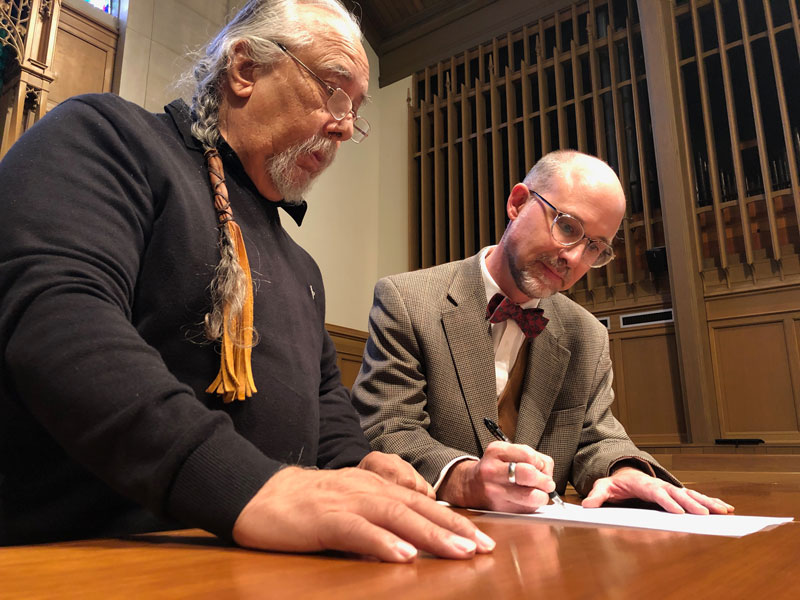
Excerpt from Hudson River Presbytery transfers title of former church to Sweetwater Cultural Center by Noelle Damico for Presbyterian News Service.
On November 20, 2019, Hudson River Presbytery transferred the title of the former Stony Point Church and all its property to the newly created Sweetwater Cultural Center “to promote the education, health and welfare of indigenous or native peoples and to preserve their cultures and ceremonial practices locally, regionally, and around the Western Hemisphere.”
As soft afternoon light filled the sanctuary of White Plains Presbyterian Church, the small group of leaders representing the presbytery, the administrative commission of the Stony Point Church, and the Sweetwater Cultural Center joined hands around the Communion table and prayed. They prayed for the role that Sweetwater would have in the preservation of native culture and ceremony, for the educational programs Sweetwater would offer native and indigenous peoples and their allies, for the nurture of right relationship with the land, and for the sweetness of the moment in which Native tribal communities and the Presbyterian Church, affirming one another as partners, had begun writing a new chapter in history together.
“This gift is a pledge of partnership with our Native American neighbors that we will walk into God’s future together,” said Deborah Milcarek, general presbyter of Hudson River Presbytery.
“This gift has the potential to change everything,” said Chief Dwaine Perry of the Ramapough-Lenape Nation, the co-chair of Sweetwater Cultural Center. The Ramapough-Lenape Nation’s land encompasses parts of New Jersey and New York, where Hudson River Presbytery is located. “We are breaking new ground when Christians take real action to make amends for the harm that has been done to Native American and indigenous people.”
The transfer was the culmination of months of discussion within the presbytery and with Native American leaders in light of the presbytery’s commitment to helping Stony Point Church distribute financial assets in a way that would “honor the congregation’s legacy and commitment as a progressive, theologically grounded presence in their community,” and that would also align with the PCUSA’s formal repudiation of ‘the Doctrine of Discovery,’ which, in the name of God, had once claimed the lands of indigenous peoples for European colonization.
“This land return is profound for those of us who are natives given that we’ve lost so much: so much history, so many of our ancestors, so much of our culture and many of our tribes have lost our languages,” said Dee Ellenwood, a ruling elder at White Plains Presbyterian Church in Hudson River Presbytery and a member of the Nez Perce Tribe. “It does bring a lot of heartache to think of how much our ancestors have suffered and sacrificed, so to see some land being given back is beyond words…. I give God the glory for all that is being done.”
By design, the board of Sweetwater Cultural Center, which has a majority membership of native or indigenous persons, includes seats for at least two representatives of Hudson River Presbytery for the next ten years. This long trajectory of participation allows Presbyterians to continue to be partners in the adventure of Sweetwater and its groundbreaking work. That Sweetwater will be a site for continued worship and advocacy has many in the presbytery excited for how their congregations can participate in this adventure.
The Rev. Stephany Graham Walker said she was honored to be representing Hudson River Presbytery on Sweetwater Cultural Center’s Board. She said members of her church were excited to imagine what it could mean to be friends and partners in this new ministry. “There is much to learn and a lot of work to be done, but I am fully engaged with heart and hands,” she said.
Pastors of churches in Rockland County where Sweetwater is located were equally energized.
“I’m excited this is happening in our county,” said the Rev. Angela Maddalone, anticipating the opportunity for exchanges at Sweetwater that will deepen understanding and relationships. “This demonstrates, especially to young people, that the church does care and is making a difference on matters of real importance. With this small step we are participating in acknowledging and repairing harm that has been done to Native cultures and building a new future together. What a moment!”
In 2004, the Muslim Center of Detroit partnered with physicians from the Islamic Association of Greater Detroit to open a free health clinic on the second floor of the prominent local mosque.
In 2004, the Muslim Center of Detroit partnered with physicians from the Islamic Association of Greater Detroit to open a free health clinic on the second floor of the prominent local mosque.

Adapted from The HUDA Clinic: A Case Study of the Reimagining Muslim Spaces series developed by the Institute for Social Policy and Understanding.
For a long time, American Muslims have contributed to providing health services to low-income, underserved populations in their communities. The HUDA Clinic in Detroit, Michigan, is an example. Established in 2004, the HUDA (Health Unit on Davison Avenue) Clinic began operations on the second floor of a mosque, The Muslim Center of Detroit. The Muslim Center has a strong focus on community service, with a vision of creating a distinct Islamic footprint. According to the center’s website, they wish “to work with Christians, Jews and other religions, as well as people of goodwill, putting our common God first.” Other services at the Muslim Center include a soup kitchen and a women’s self-defense class.
The first step in providing health care was a free monthly health clinic that offered basic health screening services at various locations in and around Detroit. Separately, a group of physicians from a suburban mosque, the Islamic Association of Greater Detroit (IAGD), decided to launch a free health clinic. The two groups connected and began to work together. Part of their goal, in addition to providing free health care, was for Muslims from the two mosques to work together. The Muslim Center is urban and primarily African American. The IAGD is suburban and primarily South Asian.
The two groups—physicians from IAGD and board members at the Muslim Center—worked together for six months to plan the clinic. This planning/board group used resources for providing and running a free health care center; accessed legal services to establish the center as a legal entity separate from the mosque; and took steps to ensure the clinic was established as a nonprofit, met requirements for financial assistance, and was fully insured and bonded.
When the clinic opened, they did not have the number of patients they had anticipated. So, they reached out to homeless shelters and the immigrant community. Their plan worked, and numbers increased dramatically. Through volunteer physicians, the clinic also partnered with local hospitals. Later they added a website. Word spread about this access to free health care.
An early debate centered around whether the clinic was for Muslims only or for everyone. Strong opinions were held and expressed on both sides. The decision was made on the side of diversity, but the struggle to ensure diversity did not go away.
The clinic began operating one day a week and has grown to operating four days a week with 60 professional volunteers on its roster (including physicians, physician assistants, dentists, an ophthalmologist, an oncologist, and a podiatrist) and a small, part-time paid staff. All services, medications, and resources are free of charge. Although medical services are for adults only, the clinic also provides a program aimed at getting children ages nine to fourteen excited about science and medicine.
Until 2012, the HUDA Clinic rented space in the Muslim Center. That relationship was not without tensions. With increased patient volume and enough funding to purchase its own property, the clinic bought and remodeled a former church building across the road from the Muslim Center.
Although the HUDA Clinic got its start at the Muslim Center, there are differing opinions on the role the Muslim Center played in the clinic’s success. For the HUDA Clinic board members who are also involved with the Muslim Center, the clinic’s success can be traced directly to the support it received from the Muslim Center, and the two continue to have a symbiotic relationship.
The HUDA Clinic continues to grow and evolve to meet the needs of its community. The clinic now makes long-term, strategic plans which helps it to maintain its diversity, respond to environmental changes, and remain transparent and accountable.
When a Muslim group needed a place for youth religious education, it began meeting at a synagogue. This arrangement led to mutual curiosity and real friendship.
When a Muslim group needed a place for youth religious education, it began meeting at a synagogue. This arrangement led to mutual curiosity and real friendship.

Adapted from Jews and Muslims in New York bond over shared space and shared values (May 2021) by Martin Davis, with permission from Faith & Leadership.
In 2016, Naz Georgas, a Muslim woman, took a cab to East End Temple, a Reform synagogue in New York City.
The reason for her visit was to ask the synagogue leadership whether her organization could use space in their building. She was starting a new, pluralistic approach to teaching Muslim children, but she needed a place to gather.
“I was apprehensive,” she said. “What would I say to the rabbi? I remember thinking, ‘God, make this easy for me.’”
She had little to be apprehensive about.
With the blessing of the synagogue’s interim rabbi, Georgas began leading youth in religious education classes every Sunday at East End Temple, which is home to a congregation of about 350 families.
The synagogue had a “willingness … to be vulnerable and get to know people,” according to its current rabbi, Joshua Stanton. That openness has led to a remarkable interfaith relationship with Georgas’ organization, Cordoba House.
At first, the relationship was a simple space-rental agreement. But over the years, it has developed into a deep connection between the two communities that now includes adult learning, worship and activism.
This type of relationship is “not for the faint of heart,” Stanton said. “Building deep relationships with another religious community … requires vulnerability, acknowledging that you don’t have all the answers or even close to all of them, and working to see the world through the lens of their community members.”
Building community, navigating tragedy
As Muslim students began attending classes at East End Temple, mutual curiosity blossomed. Sometimes the teachers would leave Islamic teachings on the whiteboards, for example, and the Jewish children would ask about what the Muslim kids were learning.
There also was a feeding program at the synagogue on Sundays, so the program’s volunteers and the people from Cordoba House would cross paths. Conversations naturally followed.
“There were always little moments of friendship,” Georgas said.
A women’s group would get together, share food, and talk about spirituality. Georgas invited people to attend jummah prayers on Fridays; Stanton provided space at the temple. The synagogue’s cantor, Shira Ginsburg, invited members of Cordoba House to Shabbat rituals.
The burgeoning friendships would reach a new level in the wake of two tragedies.
The first occurred Oct. 27, 2018, when a gunman walked into the Tree of Life synagogue in Pittsburgh and opened fire. “Not only did Cordoba House show up at Shabbat services, they came and spent time with us quietly on Sunday during their school,” Stanton said.
It was an act that, as Rabbi Stanton said, made clear that this relationship was not performative but deep and caring. “They sat shiva with us,” he said, referring to the Jewish mourning ritual.
Not five months later, another gunman entered a house of worship and opened fire, this time at a mosque — and then a second mosque — in Christchurch, New Zealand. The horrific attack left people feeling vulnerable, Georgas said.
That Sunday, however, as she and the Cordoba House youth approached East End Temple for religious school, they were greeted by Stanton and the synagogue’s youth with a large card that read: We are here for you. And we will not let what happened at Christchurch happen to you here.
The East End group sat with their Muslim friends and mourned. And Stanton had a revelation.
While listening to the imam talk about the event, he came to appreciate that the needs of those in Cordoba House “were entirely different” from his community’s after the Pittsburgh shooting.
“Muslims murdered while praying are martyrs who go straight to heaven. The imam’s concern was for the Muslims after the event, who were in shock,” Stanton said. This was different from the Jewish focus on mourning the dead.
In this tense time, Stanton came to appreciate how to “listen and support appropriately” his interfaith community members.
Deeper than dialogue
What has happened at East End Temple is interfaith lived at a level much deeper than formal dialogues and academic discussions, participants say. It’s Jews and Muslims inviting each other into their lives and, in the case of the temple, their sacred space.
“Welcoming our neighbors in our sacred home is as holy as it gets,” Stanton said.
Rather than sell one of its properties for substantial profit, the Rocky Mountain Synod of the ELCA transferred ownership to Four Winds American Indian Council in a small but meaningful act of decolonization.
Rather than sell one of its properties for substantial profit, the Rocky Mountain Synod of the ELCA transferred ownership to Four Winds American Indian Council in a small but meaningful act of decolonization.
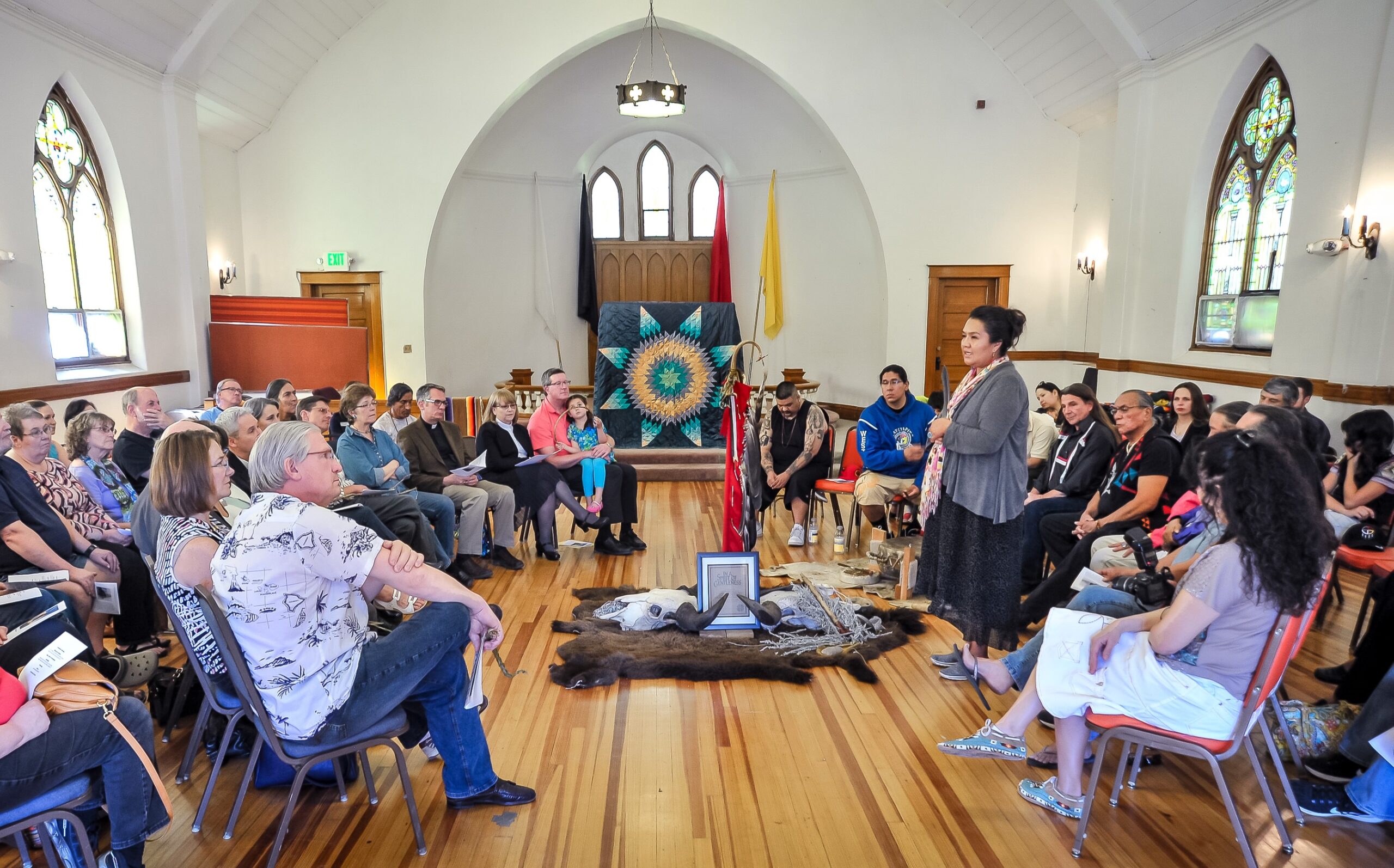
By Caleb Rollins
Sometimes the right use for a church building takes time to become clear. For one plot of church land near downtown Denver, this process took over a century. In the early years of the twentieth century, a congregation of Danish American Lutherans wanted to build a larger gathering place for their growing community. They found a plot of land at Fifth and Bannock Street to construct a building that would serve Bethany Danish Lutheran Church for sixty years. Upon the closure of the congregation in 1973, the building was turned over to a predecessor denominational body of the Evangelical Lutheran Church in America (ELCA). For the next few years, a Lutheran social service agency used the building, and then a joint ministry between Lutherans and Episcopalians filled the space. Yet one tenant that began meeting in the building in the late 1980s brought lasting life and purpose to the old church building.
Four Winds American Indian Council, formed in 1989, is an organization and community committed to supporting the liberation of all indigenous people and lands. The group began using the old church building still owned by the Rocky Mountain Synod of the ELCA, on a rent-free basis, to deepen connections among the native community in the Denver area. One member of the Four Winds community, Jolynne Locust Woodcock, expressed appreciation for how the space allowed community to gather for important and sacred events. “Just to have that place, somewhere that we can gather for birth and death and all that comes in between, is a gift,” reflected Woodcock.
In the early 2010s, real estate prices around the old building were increasing, and the Rocky Mountain Synod of the ELCA had the opportunity to sell the building and land for a substantial profit. Bishop Jim Gonia of the synod remarked, “The white American thing would be to make a profit off this building, which was sitting in a critical spot in Denver and could have netted possibly a million dollars.” However, in the decades of partnering with Four Winds, the synod and its members had developed relationships with indigenous leaders in the area. Some Lutheran leaders, including local pastor Rev. Dena Williams, felt uneasy with displacing the Four Winds community through the sale of the property. They wondered why the ownership of the land could not be turned over to Four Winds American Indian Council as a small but meaningful act of decolonization.
Part of the barrier to this seemingly reparative next step in the land’s history stemmed from some hesitation to participate in the Euro-American logic of land ownership. “Some Four Winds members were adamantly opposed to the entire concept of ownership of land,” said Williams.
Intentional and earnest conversations between the Lutherans and Four Winds community continued over the next few years. Ultimately, a task force from the ELCA synod and the Four Winds American Indian Council drafted a joint resolution that the land would be formally transferred to Four Winds, and Four Winds gained the nonprofit status necessary for legal land ownership.
In early 2015, the property formally changed hands to the Four Winds American Indian Council, and it continues to serve as a “liberated zone” in the heart of Denver for indigenous peoples. Reflecting back on this process, Rev. George “Tink” Tinker, renowned theologian and founding member of Four Winds, wondered about the possibilities that this just land return and others like it open for church bodies. Tinker encouragingly imagined, “And that becomes a role model to the rest of the euro-colonial world, the colonizer world. What churches in the United States are not on Indian land?” The Lutheran community in Denver came to this resolution after years of ministry, learning, and discernment, perhaps showing a way forward for other faith communities.
A Lutheran church, UCC church, and Disciples of Christ church in Minneapolis renovated a church building to fit the worship space needs of the three churches simultaneously.
A Lutheran church, UCC church, and Disciples of Christ church in Minneapolis renovated a church building to fit the worship space needs of the three churches simultaneously.
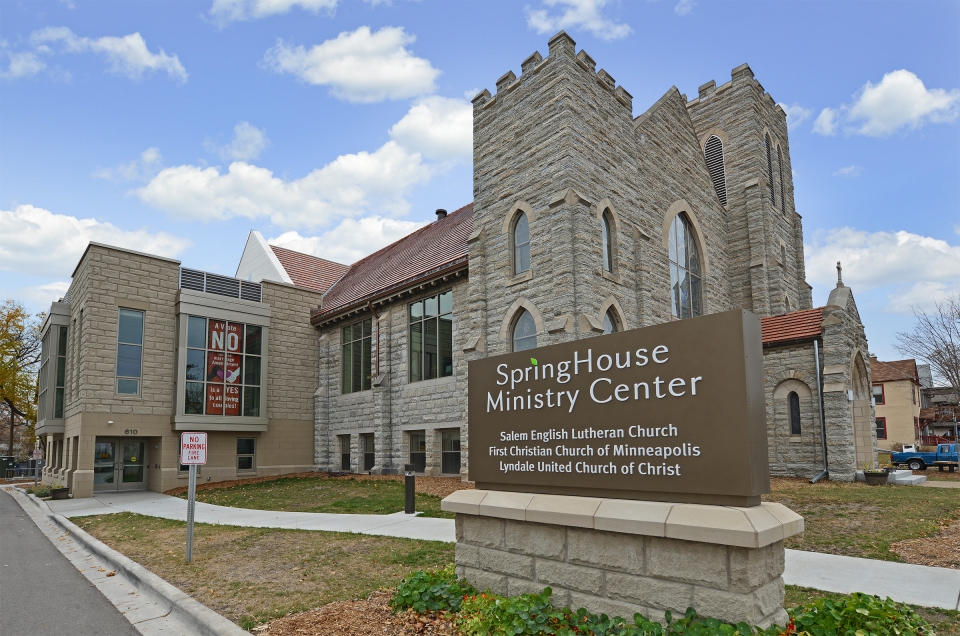
By Caleb Rollins
It’s a familiar story for all too many congregations in North America. Their membership ages and declines at the same time their building ages and declines. They struggle to discern how to best care for the decaying facility that houses a majority of their ministries. Maybe they could attempt a capital campaign, apply for grants or financing, or decide to release their property assets in support of one of their ministry partners. Or maybe they could move in with the neighbors.
That’s the path taken by Salem English Lutheran Church, Lyndale United Church of Christ, and First Christian Church (Disciples of Christ) in south Minneapolis, who worship and serve in their shared space known as SpringHouse Ministry Center. The intertwining of their journeys began in 2004, when Salem was struggling to keep the lights and heat on in their old building at the corner of 28th Street and Lyndale Avenue in the Whittier neighborhood. Instead of choosing to close down their ministry entirely, they decided to partner with nearby Lyndale UCC, a congregation with a similar commitment to justice and equity in the neighborhood. In 2006, Salem moved in with Lyndale UCC but retained ownership of their old property. Together with Lyndale UCC, they plotted how they might collectively invest in the neighborhood through the use of Salem’s former building and land. After seven years of partnership, Lyndale sold its own decaying building, and the two congregations moved into a nearby arts center. Meanwhile, Salem and Lyndale UCC had connected with First Christian, another neighborhood congregation with similar values who was facing challenges in sustaining an old building. In 2011, these three congregations formally agreed to work together and share space in the soon-to-be renovated old building of Salem.
According to current Lyndale UCC minister, Rev. Rebekah Voekel, each congregation committed a little over $1 million to the restoration of the old Lutheran sanctuary. First Christian had sold their building to a local arts institution, while Lyndale opted to sell to a local congregation of mostly African immigrants. Salem retained ownership of the original sanctuary building but sold an addition to a developer who built sixty-three affordable housing units on the site. With this infusion of cash, the three congregations could renovate one of the existing buildings to fit the needs of three churches simultaneously.
Their new shared space included woodwork from the old First Christian building and ceiling beams made from the old pews of Salem’s original sanctuary, and it offers three distinct worship spaces. However, the congregations rotate seasonally around these areas. “We don’t stay in one worship space so that we can’t claim that it’s ours and get too comfortable and start to decline again,” says First Christian senior pastor, Rev. Dr. Laurie Pound-Fielle. In addition to these shared worship spaces, the congregation’s commitment to the neighborhood shines through in the use of the building throughout the week by various community groups.
The congregations share more than just their space. They also gather together for their children’s and youth ministries and even celebrate baptisms collectively. According to Pound-Fielle, this not only solved a practical problem of small numbers of children in each congregation but also embodied innovative practices of church for young people. “It brought more energy and a different understanding for the children and the youth of what church could be.”
While this partnership has energized each congregation, it has not come without challenges. The sharing of ministries between faith communities of different denominations has inevitably led to some friction from various cultural differences. The commitment to shared space also means that each congregation must plan to use spaces with intentionality rather than assuming a room will be empty because their congregation doesn’t have an event planned.
Ultimately though, this unique partnership model allows each congregation to maintain its own identity while sharing the material resources that so often become barriers to financial sustainability. Through moving in together, the congregations of SpringHouse Ministry Center have provided a potential pathway for other congregations to remain practicing their ministries of love and grace in their communities.
The Community Church in Ada, Michigan combines their natural tendency for hospitality and fun with intentional community engagement to host an annual event that draws thousands of people each December to their church parking lot.
The Community Church in Ada, Michigan combines their natural tendency for hospitality and fun with intentional community engagement to host an annual event that draws thousands of people each December to their church parking lot.
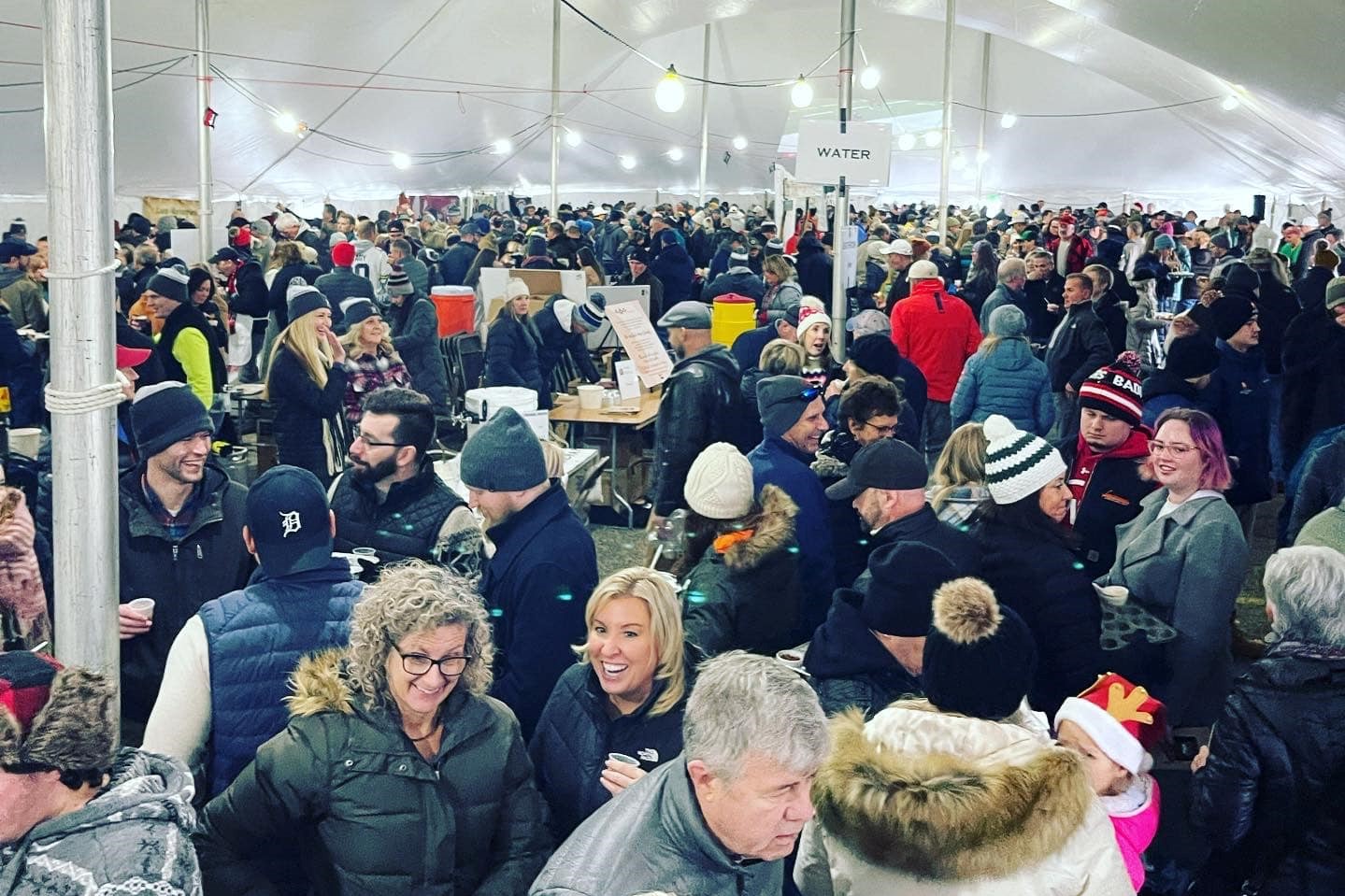
By Caleb Rollins
How did a church of seventy-five people in the small town of Ada, Michigan, come to organize the largest chili and beer festival in the country? “It’s an outflow of who we are as a church,” says Rev. Dr. Mara Joy Norden, senior minister of The Community Church in Ada. Combining their natural tendency for hospitality and fun with intentional community engagement and some entrepreneurial voices in their congregation, the members of this small church have created an annual event that draws thousands of people each December to their church parking lot. And with each version of the event, proceeds are split between the congregation’s community mission budget and the Ronald McDonald House
The Community Church’s commitment to their neighbors began in 1902, when they were formed as Ada Reformed Church in the center of town. From its earliest days, the congregation would allow patrons of downtown businesses to park their car, or horses, on the church’s property. Yet, as the congregation made the shift into the twenty-first century, their central location alone wasn’t enough to sustain their community engagement. In 2001, the congregation underwent a time of intentional revisioning informed by listening sessions with the community. As a result, the congregation committed to deepening its natural tendency for hospitality in the community, including a new stipulation that the pastor should spend 10 percent of their time on community engagement.
This boost in community involvement aligned with a plan by the city to redevelop the downtown area. The leaders of The Community Church soon found they had a seat at the table for many of the conversations about the future of their neighborhood. One such conversation involved the congregation’s strategically located parking lot that had served the downtown for decades. The church renegotiated their lease with the city, ensuring that patrons could still easily park while visiting downtown and the church could benefit financially without needing to cover maintenance costs. Additionally, The Community Church hosted multiple community events in the parking lot, including the local farmers market.
While the church put into action their commitment to deeper community engagement, they also continued another core part of who they are: gathering to eat, drink, and have fun. In the early years after their revisioning, a few people in the congregation started an annual chili cook-off with beer pairings that was held in someone’s house. After a few years, a member dreamed up the idea of hosting the event in the church parking lot under a big circus tent and inviting the whole community. This first gathering in the parking lot in 2015 has since grown to include dozens of chili contestants, thirty breweries, bands, and more than four thousand visitors.
After the first few years of the official Ada Chili and Beer Festival, The Community Church realized they could leverage the platform of this event for generosity. They found partners for this generosity at the Ronald McDonald House, which provides places to stay and wraparound services for families with children receiving care at local hospitals. With partnerships at this nonprofit and many others in the community, the festival, which started as a way for the congregation members to gather for fun, has transformed into something more. “It has really become a community event. There is a sense that this belongs to Ada and not the church,” reflects Norden.
With this one big idea of their congregation fully embraced by the community, members of The Community Church have now begun dreaming how they might next use their resources to benefit others. As they look toward the future, they hope to continue combining their natural tendencies with intentional practices of generosity and dreaming big. Says Norden, “Even though we are 115 years old, everything we do is a grand experiment.”
Struggling with the financial realities of a small and aging congregation, Altama Presbyterian Church sold their property at a reduced cost to a local nonprofit because its mission aligned with their own.
Struggling with the financial realities of a small and aging congregation, Altama Presbyterian Church sold their property at a reduced cost to a local nonprofit because its mission aligned with their own.
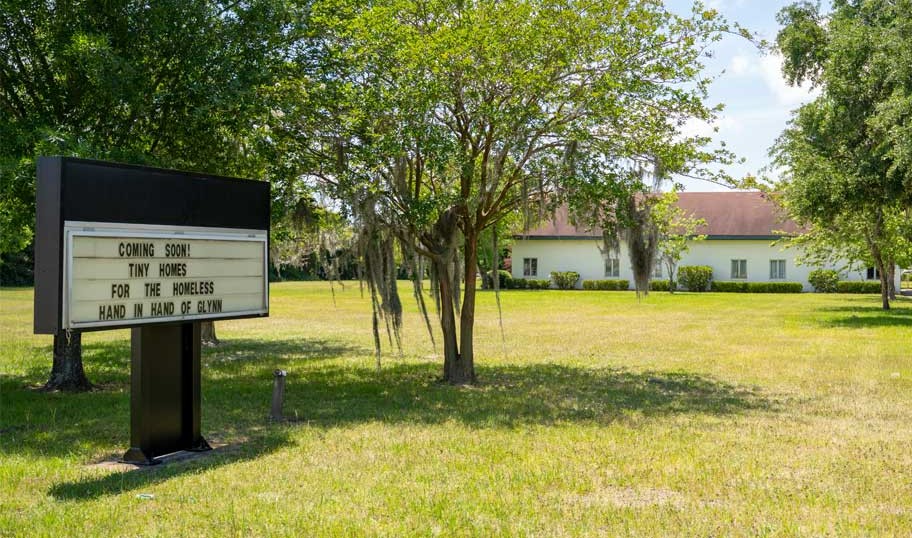
By Caleb Rollins
In 2019, Altama Presbyterian Church met for the first time with Hand-in-Hand of Glynn, a nonprofit dedicated to providing permanent supportive housing to unhoused people in and around Brunswick, Georgia. This new organization wanted to purchase the church’s property to build a village of sixty tiny homes with supportive services for people experiencing homelessness in the town of about fifteen thousand people. For the members of Altama Presbyterian, this opportunity presented a near perfect solution to their real estate woes.
Struggling with the financial realities of a small and aging congregation, the church had put their building and land up for sale two years earlier. They faced mounting maintenance costs and shrinking income. “We had this big piece of property and couldn’t afford a full-time pastor,” remembers church clerk Penny Moore. While they hoped they might sell the land to another church or an organization that aligned with their mission, they knew they might instead have to sell to a developer who would knock down their sanctuary and replace it with a strip mall.
Fortunately, the leaders of Hand-in-Hand were searching for a place to put into practice their theory of housing-first homelessness support. After city planning barriers forced them to back out of another deal, Hand-in-Hand approached Altama Presbyterian. Unfortunately, even with the donations they had gathered, Hand-in-Hand could not match the sale price for the church campus. After a few conversations though, the church decided they could lower the sales price because of how the nonprofit’s mission aligned with theirs. “They have always really embraced the idea of helping others, especially the less fortunate. Everywhere is part of the church for them . . . the whole city of Brunswick,” says Altama Presbyterian pastor Rev. Jamil el-Shair.
In addition to agreeing to lower the price and wading through the rigamarole of real estate transactions, the leaders of Altama Presbyterian had to attend to some items unique to their building sale process. They met with leaders of the local presbytery to ensure that the congregation could maintain the funds from the sale rather than the monies being shared throughout the region. Furthermore, to help support the mission of Hand-in-Hand, and to shepherd along the sale of the property, members of Altama Presbyterian spoke at a local zoning board meeting in support of the tiny homes village project.
With the real estate transaction complete, the congregation was faced with another unexpected challenge: deciding what to do with all of the items, cherished and otherwise, inside their soon-to-be demolished sanctuary. With the move to their newly rented home needing to happen quickly, congregation members realized they could not save everything in the fifty-year-old building. Some items they sold; others they had to let go. Fortunately, they worked with Hand-in-Hand’s builders to save a precious stained-glass window and cross. All the while, they found space to grieve this move and the destruction of the building that had been their home for decades. Through conversation and reflection, they said goodbye and looked forward to the next chapter of their church, wherever that might be. “The church is the people. It’s not the building we are in,” reflects Moore.
After the move into their rented home, Altama Presbyterian is looking forward to using some of the funds of the sale to purchase a new permanent location for their church. Meanwhile, Hand-in-Hand has begun construction of the tiny homes village with hopes of opening in 2023. Even though they had to tear down the sanctuary, they have incorporated the old fellowship hall into their design as the community center of the village. Some of the members of Altama Presbyterian hope they might be able to come back to this fellowship hall turned community center to volunteer once the village opens. It’s a vision for this plot of land the church could not have dreamed of themselves, but through some good fortune, hard work, and self-reflection a hopeful future has begun to emerge.
St. Paul’s United Methodist Church used their extra church building to support a nonprofit focused on one of the most urgent and challenging social problems in their community.
St. Paul’s United Methodist Church used their extra church building to support a nonprofit focused on one of the most urgent and challenging social problems in their community.
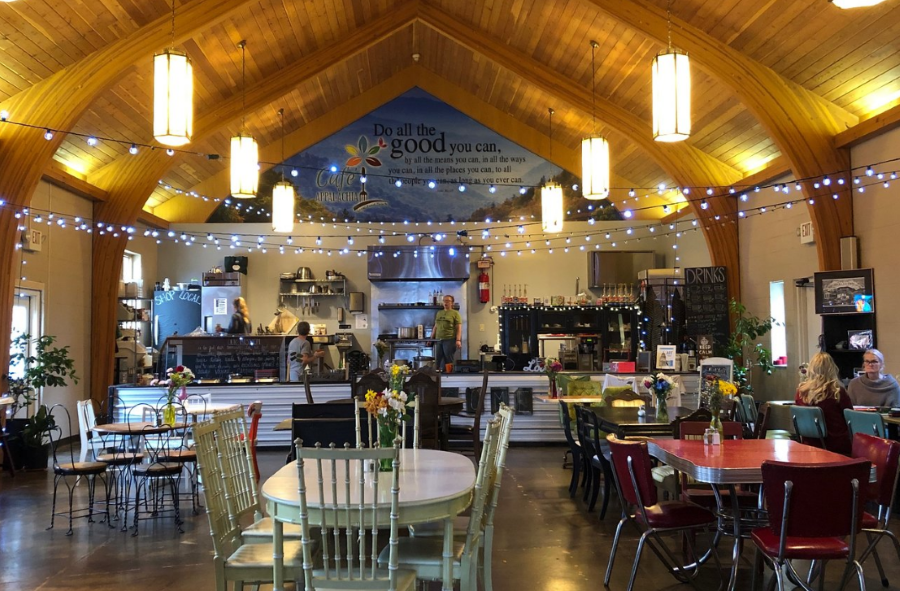
By Caleb Rollins
Years ago, the children of St. John’s United Methodist Church in South Charleston, West Virginia, gathered for games and fun in a small area adjacent to their sanctuary at the edge of downtown. Today, a vegetable garden sits on that plot of land providing produce for the café now run out of the former church building. Café Appalachia, a pay-what-you-can coffee shop and restaurant, opened in the old worship space in 2018. Part of the organization Pollen8, Cafe Appalachia also trains and employs women recovering from substance misuse. The journey to this social enterprise coming to occupy an old Methodist building began years ago and required a mixing of cultures and financial sources to come to fruition.
The building of St. John’s actually belonged to St. Paul’s United Methodist Church, which had come to own it through a series of mergers over the last fifteen years. The general decline of attendance and financial security at several local congregations led to an opportunity familiar to many consolidated congregations. They now held an extra piece of real estate, but they had to maintain it and decide how they might steward it to further their mission. With the central location of the former St. John’s plot, St. Paul’s had the opportunity to sell this land and gain a substantial sum of money and provide some security to daily operations. According to St. Paul’s pastor Rev. Paul Mateer, the congregation had conversations with a restaurant that wanted to purchase the parcel for about $200,000.
However, the congregation maintained active relationships with many nonprofit organizations and hosted community meals. Through this community engagement, they met Cheryl Laws, the founder and CEO of Pollen8. Laws presented to them her vision of Café Appalachia, where all people could come to eat and women recovering from substance misuse could more easily reintegrate into society. The old church building would serve as a perfect site for this new social enterprise, but St. Paul’s would have to give it to Pollen8 for little to no cost.
In discerning whether they wanted to invest in the mission of this nonprofit, the congregation came to know some of the women engaged in Pollen8’s programming. These women, who would be the ones working in the proposed café, did not match the typical demographics of the congregation. Through small efforts of relationship-building though, any concerns about the cultural differences between the church and the nonprofit were allayed. Even with the strengthening bond between the congregation members and women of Pollen8, the church still had to determine whether they could afford to sacrifice a six-figure windfall to support the dream of Café Appalachia.
Leaning on the expertise of the members of their congregation and the resources of their conference, St. Paul’s came up with a compromise. Rather than give the old church building to Café Appalachia, the congregation would apply for some grants to help substitute for some of the potential revenue from selling the land to the highest bidder. Through a grant from their conference, a denominationally affiliated foundation, and a few other small sources, the congregation raised $45,000. While this amount did not equal the $200,000 offer they had previously received, it eased the concerns of the congregation’s trustees enough for them to move forward in partnership with Café Appalachia.
This process of relationship building and piecing together the right financial components did not happen overnight. Yet, through the investment of time and energy by many in their congregation and beyond, St. Paul’s United Methodist Church used their extra church building to support a nonprofit focused on one of the most urgent and challenging social problems in their community.
While the Church of the Advocate's ample campus and cavernous interior support Art Sanctuary’s practical needs for storage, rehearsal, and performance space, the church’s activist history is also a source of heady inspiration.
While the Church of the Advocate's ample campus and cavernous interior support Art Sanctuary’s practical needs for storage, rehearsal, and performance space, the church’s activist history is also a source of heady inspiration.
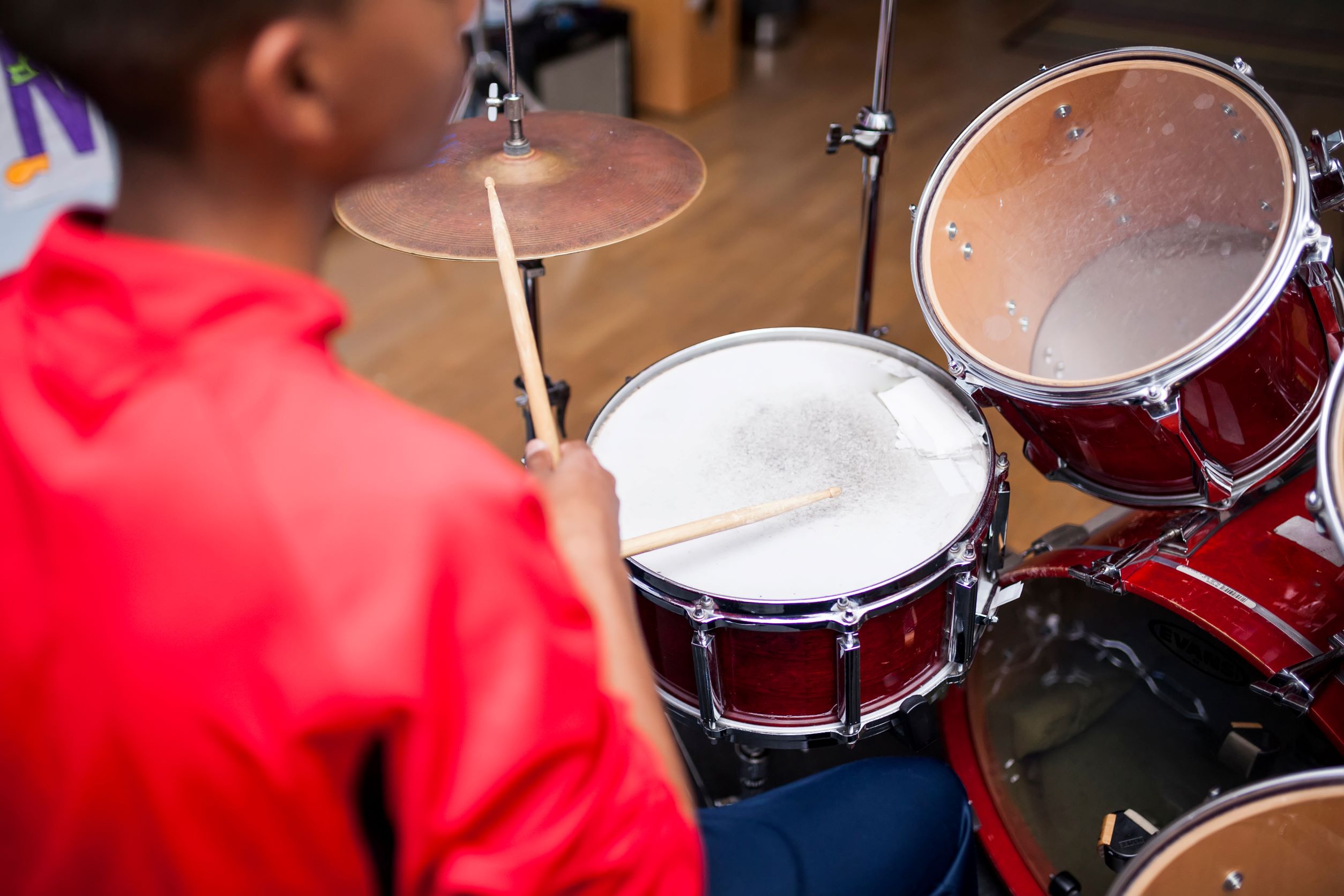
Excerpt from Art Sanctuary by Ann de Forest for Partners for Sacred Places. Originally published February 2015.
For a few sultry nights this past spring, North Philadelphia’s landmark Church of the Advocate was transformed into Harlem’s Cotton Club, circa 1940. On stage, teenage performers bedecked in vintage finery channeled stars of a bygone era—Ray Charles, Etta James, Billie Holiday. “This joint is jumpin’,” they sang, and by the end of an evening that interwove old-time jazz standards with hip-hop dance, African drumming, and spoken-word poetry, the audience was jumping too. The crowd was on its feet for the finale, clapping to a rousing version of Stevie Wonder’s “Higher Ground.”
The North Stars Afterschool Program—in which twelve- to eighteen-year-olds study music, poetry, voice, and dance with accomplished professional artists free of charge—is just one of several high-impact programs initiated and run by Art Sanctuary, a community arts organization based at Church of the Advocate in North Philadelphia. As the brainchild of Philadelphia writer Lorene Cary, Art Sanctuary was originally founded to bring prominent African-American writers and performers to inner-city audiences often overlooked by national book and concert tours. At Art Sanctuary’s recent Reading in Concert series, for example, Pulitzer-prize winning playwright Charles Fuller spoke informally to high school students at Church of the Advocate about his craft, career, and formative years spent in nearby housing projects.
North Stars is just one example of Art Sanctuary’s responsiveness. The Afterschool Arts Program answered a need expressed by Eileen Brown, cofounder and president of Grands as Parents (G.A.P.), who was raising six grandchildren on her own. Also housed at Church of the Advocate, G.A.P. is a support group for grandparents who suddenly find themselves caring for their children’s children. Although G.A.P. offered reading and crafts for younger children and sports activities for teens, Brown expressed concern that teenagers with artistic inclinations did not have an outlet; Art Sanctuary established the North Stars program to provide that outlet. Since its beginning, more than 125 teens have been transformed by the program, including all of Eileen Brown’s grandchildren. This year Brown once again sat in the audience, proudly watching her two youngest grandchildren perform in the African dance numbers.
While her granddaughters grin and glow after strutting on stage, Brown knows that North Stars’ true value comes from the program’s less glamorous moments. The gradual mastery of difficult dance steps and the steady presence of North Stars’ instructors are what will make a lasting difference in the teens’ lives. “It builds up their self-esteem,” she says. “They do better in school.”
Cary notes that shyer kids sometimes gain confidence at North Stars and then become so involved in student council or theater at their schools, they no longer have time for the program. “Sometimes we’re victims of our own success,” she jokes. Seifert’s research supports these observations. Social Impact of the Arts has demonstrated that neighborhoods with thriving community arts programs experience lower truancy and delinquency rates.
Church of the Advocate makes a fitting home for organizations like Art Sanctuary and G.A.P., which are part of a buzzing hive of community services at the church, including a soup kitchen and clothes cupboard based in the neo-Gothic National Historic Landmark. While its ample campus and cavernous interior support Art Sanctuary’s practical needs for storage, rehearsal, and performance space, the church’s activist history is also a source of heady inspiration. As the site of the city’s Black Power Conference in 1968 and of the Episcopal Church’s first ordination of women in 1974, the Church of the Advocate resonates with the significant contributions it has made—not just to Philadelphia but also to the world. As Cary says, “People get that we’re righteous if we’re at the Advocate.”
And though Art Sanctuary moved its offices to South Philadelphia this spring to further its commitment to build bridges to other neighborhoods and communities, the Advocate remains Art Sanctuary’s true home, where North Stars kids build confidence as they learn to play guitar and dance, and where renowned artists like Charles Fuller tell inner-city youth their own stories of struggle and triumph. “Our groundedness comes from our relationship with the church,” says Tarana Burke, Art Sanctuary’s managing director. “We will always be a part of the church.”
Read the full story.
Kinder Academy boasts of “quality childcare that provides a structured preschool program with the convenience of daycare hours.” The childcare center at Bustleton UMC is the jewel in Kinder Care’s crown, made possible with the space and support offered by the congregation.
Kinder Academy boasts of “quality childcare that provides a structured preschool program with the convenience of daycare hours.” The childcare center at Bustleton UMC is the jewel in Kinder Care’s crown, made possible with the space and support offered by the congregation.

Excerpt from Kinder Academy by Allison King for Partners for Sacred Places. Originally published February 2015.
The Bustleton neighborhood of Northeast Philadelphia looks like a tidy suburban enclave of modest brick homes and well-kept yards. With its white spire and wide-columned portico, Bustleton United Methodist Church reinforces that impression. But this neighborhood of working-class families—home to a growing number of immigrants from India, Russia, and Eastern Europe—has been hard hit by the current economic crisis. And the Bustleton UMC childcare center, run by Kinder Academy, Inc., sees the economic impact in the children it cares for and educates.
“We serve the working poor,” says Leslie Spina, director of the Bustleton childcare center and founder and administrator of six other Kinder Academies throughout Northeast Philadelphia. “Seventy-five percent of our children come from single-parent homes; 56 percent are receiving subsidy. The majority are struggling.”
Nicole Spellman was certainly struggling when she moved to Philadelphia four years ago, newly single with two young children, no job, and no friends or family nearby. The Bustleton childcare center offered her a lifeline. Anytime she had a job interview, she could drop off her kids at the day care free of charge. Bustleton Kinder Care became an anchor for Nicole as she adjusted to her new situation and neighborhood. “People would give me directions, help me get to the places I needed to go—all the little things that make you feel welcome,” she recalls.
Kinder Academy boasts of “quality childcare that provides a structured preschool program with the convenience of daycare hours.” The childcare center at Bustleton UMC is the jewel in Kinder Care’s crown, made possible with the space and support offered by the congregation.
Kinder Academy has made vibrant use of the church’s underused space by repainting, restructuring, and retrofitting old auditoriums and screening rooms at Bustleton to serve as bright yellow classrooms for “Caterpillars” and “Butterflies,” the oldest preschoolers. The center and church coexist in a mutually beneficial (and mutually dependent) relationship. Several in the aging congregation volunteer as tutors or donate art supplies. One congregant, Al—better known to the children and staff as “Pop-Pop”—serves as resident tinkerer and fix-it man. “This is what a retro-fitted program looks like,” says Spina, waving her hand down a corridor of rooms that perform double-duty nights and weekends for Sunday school, scout troops, and AA meetings. “It’s more about the families [than the facility]. We make connections with the families.”
For Spellman, that connection continues to make a difference in her children’s lives. They still start their day at Bustleton’s day care so Nicole can get to work. And when she picks them up there at the end of her workday, she often lingers, making sure all homework is done before they go home. Besides, laughs Nicole, “they always seem to have the supplies—those glue sticks and scissors—I can never seem to find at home.”
The Kinder Academy program at Bustleton has long been responsive to children with special needs and their families, mainstreaming them into the classroom and accommodating their aides or individual assistants. With fifteen years’ experience in childcare, Spina knows how to help parents with special-needs children navigate the bureaucratic maze and learn what services the state offers. Her base at the congregation gives her a willing volunteer network to tap into. When Nicole’s son was struggling with reading, Spina arranged for an after-school tutor, a volunteer from the church, at no extra charge.
Such extraordinary attention and responsiveness to families’ needs is the ultimate mark of a day care center’s commitment to quality. “It’s all about relationship building,” says Cohen. Whether caring for infants or providing a safe and stimulating environment for elementary schoolchildren at the beginning or end of the day, the best day care centers are “like a second home for the child.” As Spellman and her children attest, that is exactly the environment Spina and her staff have worked hard to create at Bustleton. “They made us feel welcome when we knew nobody. We’re all very comfortable there.”
Read the full story.
Neighborhood Bike Works, a Philadelphia nonprofit serving the larger community, operates out of the basement of St. Mary’s Episcopal Church.
Neighborhood Bike Works, a Philadelphia nonprofit serving the larger community, operates out of the basement of St. Mary’s Episcopal Church.
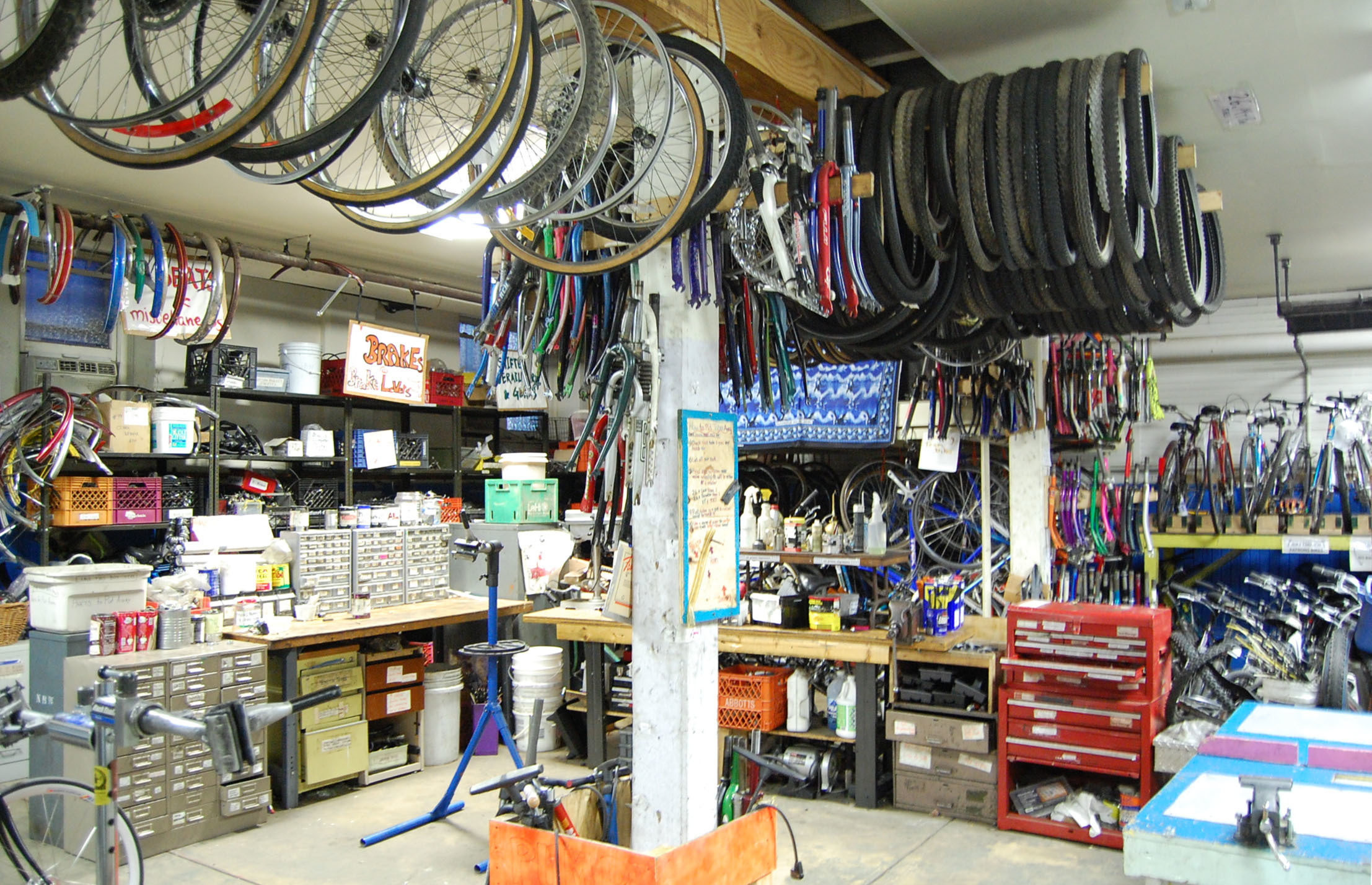
Excerpt from Bike Works by Allison King for Partners for Sacred Places. Originally published February 2015.
Since 1996, Neighborhood Bike Works (NBW) has introduced kids to a world of opportunities through bicycles. In after-school, weekend, and summer classes, youth ages eight to eighteen come from West Philadelphia and beyond to participate in NBW’s Earn-a-Bike program, where they learn about bike safety and repair. After fixing up used bikes donated by the community, participants graduate with a bike of their own, a helmet, and a lock.
Neighborhood Bike Works is housed in the basement of the parish hall of St. Mary’s Episcopal Church, Hamilton Village (Philadelphia, PA).
The kids involved get a sense of true accomplishment in transforming broken-down bikes into a fun and functional means for getting around town—their own personal treasure they get to take home and keep.
Bike Works’ “trash to treasure” philosophy could also describe their transformation of St. Mary’s parish hall basement into a colorful, lively workspace. The basement presents a scene of ordered clutter, with every surface a variation on the theme of bicycles. Tires, tubes, handlebars, and other bones of bicycle skeletons hang from the ceiling and walls. Bright murals painted in collaboration with the city’s Mural Arts Program feature Lance Armstrong and Major Taylor, an African-American cyclist who in the 1890s defied Jim Crow laws to compete, becoming a world-famous racing champion. Even the banisters are fashioned from bike gears and handlebars. NBW has utilized the church’s undercroft as well, as storage for used bikes and parts sold under the auspices of the archly named Divine Bike Church, to earn money for NBW’s youth development programs.
St. Mary’s has welcomed a bunch of noisy, sometimes unruly teenagers into their building.
NBW’s active outreach to the larger community resonates with St. Mary’s own mission. The association has become “symbiotic.” NBW is one of the faces St. Mary’s presents to the world as well as to its own congregation.
Through a singular focus on bicycles, NBW has spawned programs that change young people’s lives and by extension transform communities too. Participants in the Earn-a-Bike sessions take home much more than the cool bikes they fixed up themselves. They gain confidence, work habits, and practical skills that have a lasting impact. Building and repairing bicycles involves both collaboration and the ability to work independently.
NBW’s success can be tied to its attitude toward the youth it serves. Rather than seeing the kids, many of them poor and marginalized, who come to NBW from all over the city as problems, NBW sees them as full of potential community resources.
Earn-a-Bike, the racing team, recreational bike rides, and an array of programs formed with partners ranging from Spiral Q Puppet Theatre to the School District of Philadelphia provide means for kids to realize their own potential as community resources, to see themselves as leaders and problem solvers, and to have fun in the process. NBW also provides a refuge from neighborhood distractions for at-risk kids.
St. Mary’s Church, on the edge of the University of Pennsylvania campus, has proved an ideal location for that refuge.
NBW keeps growing, with a satellite workshop in West Philadelphia’s Haddington section and another on Temple University’s campus in North Philadelphia.
Note: This article was written in 2015. Since that time, Neighborhood Bike Works continued to grow until they needed more room than St. Mary’s basement. Bike Works moved just a few blocks away from St. Mary’s, but the memories and the murals remain.
Read the full story.
When asked to use its building and property to shelter women and families, Salt House Church said yes.
When asked to use its building and property to shelter women and families, Salt House Church said yes.

Excerpt from A dying church’s gift inspires a young congregation to help people experiencing homelessness by Julia Duin for Faith & Leadership.
A dying Lutheran church in the Seattle suburb of Kirkland had a difficult decision. Should they close and sell their property, or should they give the assets to another congregation?
Trinity Lutheran Church’s decision to give up its property to new owners nearly a decade ago led to the planting of Salt House, an enterprising, high-tech Lutheran congregation.
With core values of generosity and radical welcome, the progressive church has embraced LGBTQ folks and established a fund for reparations. Among its biggest commitments: sheltering people experiencing homelessness. Today its campus includes a day center in the church basement and a twenty-four-hour shelter on land it sold to the city.
The original gift of the building and assets is now part of the congregation’s DNA, helping drive decisions about who and what they will become. “This whole ability to start Salt House was from the generosity of the dying ….So who were we to stint on generosity?” explained a Salt House pastor.
The Salt House story began in 2013. At that time, only a few dozen people were coming to Trinity Lutheran Church each Sunday, while Holy Spirit Lutheran, a nearby congregation with traditional worship but a liberal bent, was thriving. One day the pastor, Rev. Mike Anderson, got a phone call from leaders at Trinity. But “instead of trying to keep a dying congregation going, we decided it might be better to let the congregation die and resurrect a new one.”
Trinity wanted to have some say in what happened to its assets, which consisted of the church, the land it was on, a parsonage next door and $100,000 in the bank. Specifically, they wanted the building to house a worshipping community with a social justice outreach. Could Holy Spirit help?
Holy Spirit Lutheran spent eight months discerning and approving a vision for a place with contemporary worship to attract young adults. They came up with a church name – Salt House – and hired a thirty-something pastor, Rev. Sara Wolbrecht.
Holy Spirit’s support — together with the assets transferred from the now-defunct Trinity church — proved essential in helping Salt House attain parish status in the relatively quick time of three years.
The church wasn’t even a year old when it was approached by two Catholic parishes about their unfinished basement.
The Catholic groups had been looking for space to fund a day center for homeless families that would include showers, food service, and a laundry. They would pay to finish the basement and staff it with social workers from Catholic Community Services.
For the thirty people then attending Salt House, it was not an easy decision due to potential resistance from the surrounding community and the church’s original vision to focus on needs of youth. However, the congregation recognized the great need and opportunity and said yes to what became the New Bethlehem Day Center.
“It was an evolving mission and vision,” Anderson said. “You can plan your vision at the outset, but you also must respond to opportunities and needs which arise.”
But Salt House members’ commitment to helping the unhoused didn’t stop there. When approached by Deputy City Manager Tracey Dunlap, a member of Holy Spirit, about buying a portion of their land to build a homeless shelter, they agreed.
Now Kirkland Place for Families and Women operates right next to the church.
The congregation, now with some 150 people, works to include people experiencing homelessness through activities such as quarterly feasts; toiletry, sock, and gift card drives; and training for tutoring and parenting. Salt House also allots about $5,000 annually to fund outreach to the LGBTQ community and 1 percent of its offerings for reparations to black individuals.
Wolbrecht summarized these ministries in a sermon as a retrospective of the congregation’s first seven years and a vision for the next seven. She preached on Jesus’s questions to Peter during a post-resurrection appearance.
“What does it look like to love like Jesus here and now?” she asked. Then she ran through a dizzying list of activities Salt House oversees.
“Do you feel where we’ve been is incredible?” she asked. “Do you feel led to be where we are going right now?”
Judging from the applause, they did.
Read the full story.
Beyond the first step of acknowledgment, some faith communities are taking up concrete reparations as a way of demonstrating authentic repentance for their role in systemic oppression.
Beyond the first step of acknowledgment, some faith communities are taking up concrete reparations as a way of demonstrating authentic repentance for their role in systemic oppression.
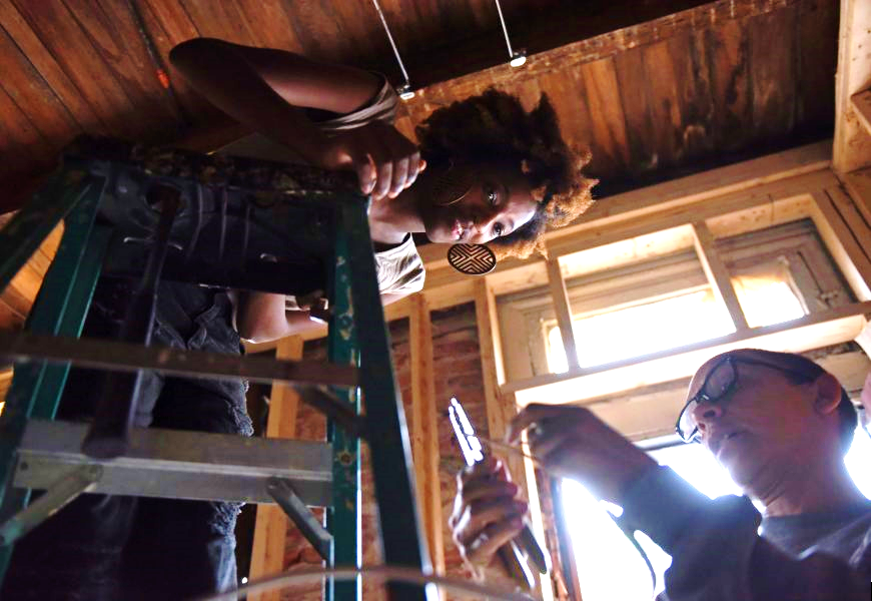
Excerpt from The path to reparations by Cynthia R. Greenlee for Faith & Leadership.
One memorable day two summers ago, Rev. Natalie Conway was sitting in Baltimore’s Memorial Episcopal Church when her brother called. He’d visited Hampton National Historic Site, once one of the nation’s largest plantations and found records that mentioned probable enslaved ancestors who shared a family surname: Cromwell.
The Baltimore-raised siblings had been searching online for their ancestors. That’s no small task, since paper documents don’t always survive time, disasters, or household purges. Moreover, bondspeople are hard to trace because—deprived of literacy, last names, and personhood—they left few clues.
Conway, a deacon at the church, recalls her brother asking whether she knew that Charles Ridgely Howard may have owned their ancestors.
“Where have I seen that name?” she said. “And sure enough, it was on one of the plaques at the back of the church.”
Howard, it turned out, was the parish’s first rector. Memorial Episcopal Church was established in 1860, just before the Civil War erupted, when Southern sympathizers broke from their abolitionist mother church. Memorial’s founding fathers were slaveholders and, after the war, proponents of the Lost Cause, a narrative that painted the seditious South as the aggrieved party.
A second Memorial member also had a connection to Hampton. Restaurateur Steve Howard, 54, is an indirect descendant of Charles Ridgely Howard.
“The fact that [my ancestors] were enslavers wasn’t hidden. It just wasn’t dwelled upon in our family history,” he said. “It was, ‘Here were these people; they had a farm, they were involved in politics and building the city and all that—and they had slaves, too.’ Let’s move on,” was the general sentiment.
The convergence of Conway’s and Howard’s stories—one arising from people enslaved at Hampton, the other from the planter class enriched by stolen human labor—became the narrative linchpin for Memorial Church’s reparations work.
Today, the congregation is at the vanguard of religious communities’ racial reconciliation efforts. It has created a reparations program that includes the establishment of a $500,000 fund to support black-led nonprofits such as Black Women Build; deepened ties with a nearby African-American Episcopal congregation; set up a standing committee to consider how the church can meaningfully affect racial justice; and committed to a continuing effort to excavate the church’s history, warts and all.
The Episcopal Diocese of Maryland, which includes Memorial, agreed to study reparations in 2019. By September 2020, more than 80 percent of its delegates voted to establish a $1 million seed fund to be disbursed to programs in black communities.
In its recent history, Memorial has a reputation for progressivism, as the first Maryland church to bless a same-sex union (in 1992) and as a leader in the support of LGBTQ clergy and ministry to those living with HIV/AIDS.
Even so, committing to reparations required learning about where the church had stumbled and broadening his own view of what needs to be repaired, said Rev. Grey Maggiano, the church’s rector.
In May 1956—almost two years after the U.S. Supreme Court declared public-school segregation unconstitutional—Memorial parishioners refused a substantial grant for church expansion because of the funding’s conditions.
The congregation would have to admit black members. The vestry voted no and showed the rector the door.
Maggiano had studied public policy before coming to Memorial in 2016, a year after Freddie Gray’s death in police custody sparked the Baltimore uprising. The church is in a largely black neighborhood near Eutaw Place, where turn-of-the-century mansions are within walking distance of open-air drug markets and boarded-up buildings are proof of urban divestment.
He asked black neighbors what their experience of the church had been. The answer: “Your part of the neighborhood isn’t safe for us to walk through.”
Maggiano requested 911 call records for the area. For 2019 alone, he found 280 calls that reported “suspicious persons” in the vicinity. Combine that with a mostly white congregation that didn’t desegregate until 1969, and the wide gulf between the church and its neighbors was no surprise.
Maggiano and his parishioners have navigated blind spots and tender points. When Conway preached about her brother’s discovery, the plaques were still in place, though covered with black cloth.
“I could see it flapping in the wind. It made me angry.” She searched for a way to channel her pain and righteous anger.
Days later, white and black congregants from Memorial and its sister church, the historically black St. Katherine of Alexandria, visited Hampton plantation, where Conway and Howard offered a liturgy-libation to honor the enslaved.
Still, some black members didn’t want to engage in race discussions; such talks had gone badly before. They “liked this church and wanted to continue to like white members,” Maggiano said. And Howard suspected, even when people didn’t say it, some white members felt unfairly implicated.
Hard though those lessons were, Memorial had a few things in its favor—a tangible connection to slavery, a motivated rector, a sympathetic diocese—which made the conversation less fraught, though not easy.
Howard said, “It’s about building relationships; it’s not just about money. I mean, money helps. Without money, there’s a credibility question,” he said.
“But if we can have a strong relationship with St. Katherine’s and St. Katherine’s can be a viable presence in West Baltimore, and if organizations like Black Women Build . . . can thrive because of something that Memorial Episcopal does, that’s what I want to be a part of. I don’t want it just to happen. I want to be a part of it.”
Read the full story.
Davis Street UMC is selling its campus near downtown Burlington, NC to an. organization that provides therapeutic rehabilitation for children with autism.
Davis Street UMC is selling its campus near downtown Burlington, NC to an. organization that provides therapeutic rehabilitation for children with autism.
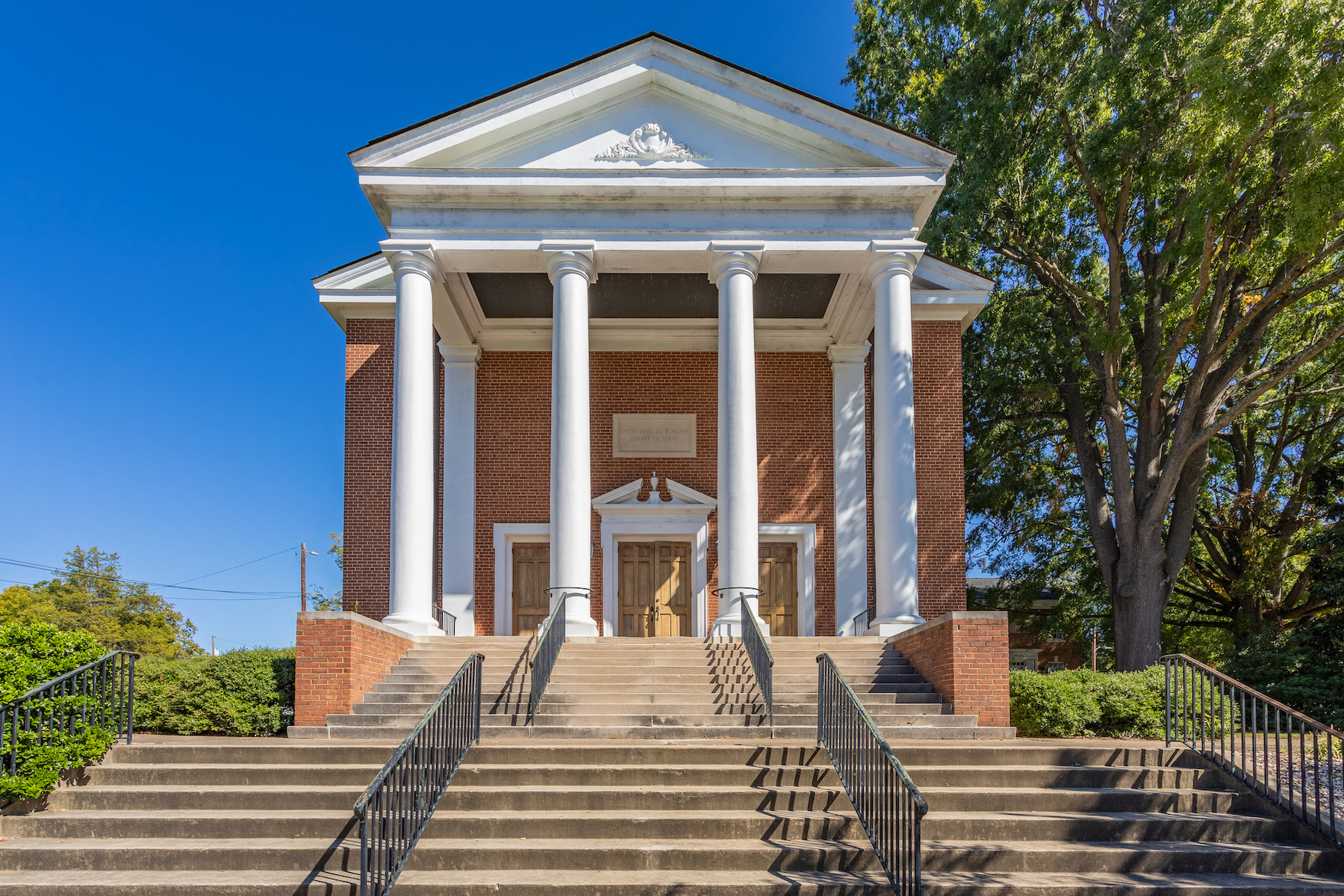
Republished with permission from Wesley Community Development news. By Mack King, Senior Director of Real Estate Services for Wesley.
Faced with dwindling membership, rising property costs and an uncertain future, one local church in Burlington NC has found a way to carry forward its mission to love God and serve neighbor, even though it means saying goodbye to its home of 120+ years.
Davis Street United Methodist Church will sell its campus near downtown to a group that provides therapeutic rehabilitation for children with autism. Church leaders say the life-changing work done by Kare Partners fits well with the congregation’s history of community outreach.
Though the singing and praying will come to an end, the Davis Street campus will remain Wesleyan in DNA, says Rev. Edgar DeJesus, the church’s pastor.
“The story of Davis Street Church is embedded in the building,” he said. “My prayer is that as God entrusts this sacred space to Kare Partners, that story can be told and shared for generations.”
The two parties connected through Wesley Community Development, a United Methodist-affiliated, non-profit organization that helps churches re-purpose and/or sell property with an eye toward sustainable ministry.
As aging congregations contend with building and maintenance costs, Wesley has fielded greater interest in finding innovative re-uses of church property. The Wesley team helps clergy and lay leaders consider ways to turn facilities into assets rather than burdens.
“Davis Street took this walk faithfully and prayerfully,” said Wesley President Joel Gilland. “This is the core work of Wesley, creating a positive outcome for ministry within the context of realities. The church was never the campus, and the campus was never the church. We assist in navigating that conversation.”
With its white steeple and 50-foot Tuscan columns, Davis Street served for generations as a stately presence overlooking a residential neighborhood. But the congregation hasn’t attracted younger churchgoers. About 30 people attend worship on a typical Sunday. Offices and classrooms sit mostly unused. All the while, upkeep on the 27,000-square-foot building gets more expensive.
A ‘better use of this building’
A sustainability task force comprised of church leaders spent two years in consultation with the Wesley team to chart a way forward.
“While we do have funds for repairs and modifications, we started looking at who’s going to be here to utilize the building?” said Vicki Ambrose, vice chair of the Church Council. “The better use of this building is for us to vacate.”
Founded in 2005, Gastonia-based Kare Partners provides services in cardiac, neuro and orthopedic rehabilitation. Its fastest-growing arm, Compleat KiDZ, offers a form of care known as Applied Behavior Analysis, the only evidence-based approach to autism treatment. Therapists teach skills like speech and communication, focus and attention, social skills and self-help skills.
The fellowship hall, classrooms and playground at Davis Street are well-suited for these activities. Kare Partners envisions the sanctuary as a community-oriented bakery and coffee shop that would employ young people with special needs.
“We want to be good caretakers,” said CEO Adi Khindaria. “Hopefully, we’ll take all the goodwill that’s been built up over the last 100 years and pass it on to kiddos who come to us.”
The Burlington City Council unanimously approved a rezoning at its Sept. 20 meeting, clearing the way for the project to move forward.
Kare Partners offered to let Davis Street congregation continue worshipping in the sanctuary through Christmas, a reflection of the collegial relationship that has taken root. After that point, church leaders hope to share space with an existing church.
While saying goodbye will be difficult, the people of Davis Street can give thanks for the next chapter of their spiritual home. “It’s going to be used,” Vicki Ambrose said, “for something in keeping with the mission of the church.”
***

Visit WesleyCDC.com to learn more about their services.
After seven years of discernment and planning, the Dominican Sisters of Hope permanently protected 34 acres of their property from future development with a conservation easement.
After seven years of discernment and planning, the Dominican Sisters of Hope permanently protected 34 acres of their property from future development with a conservation easement.
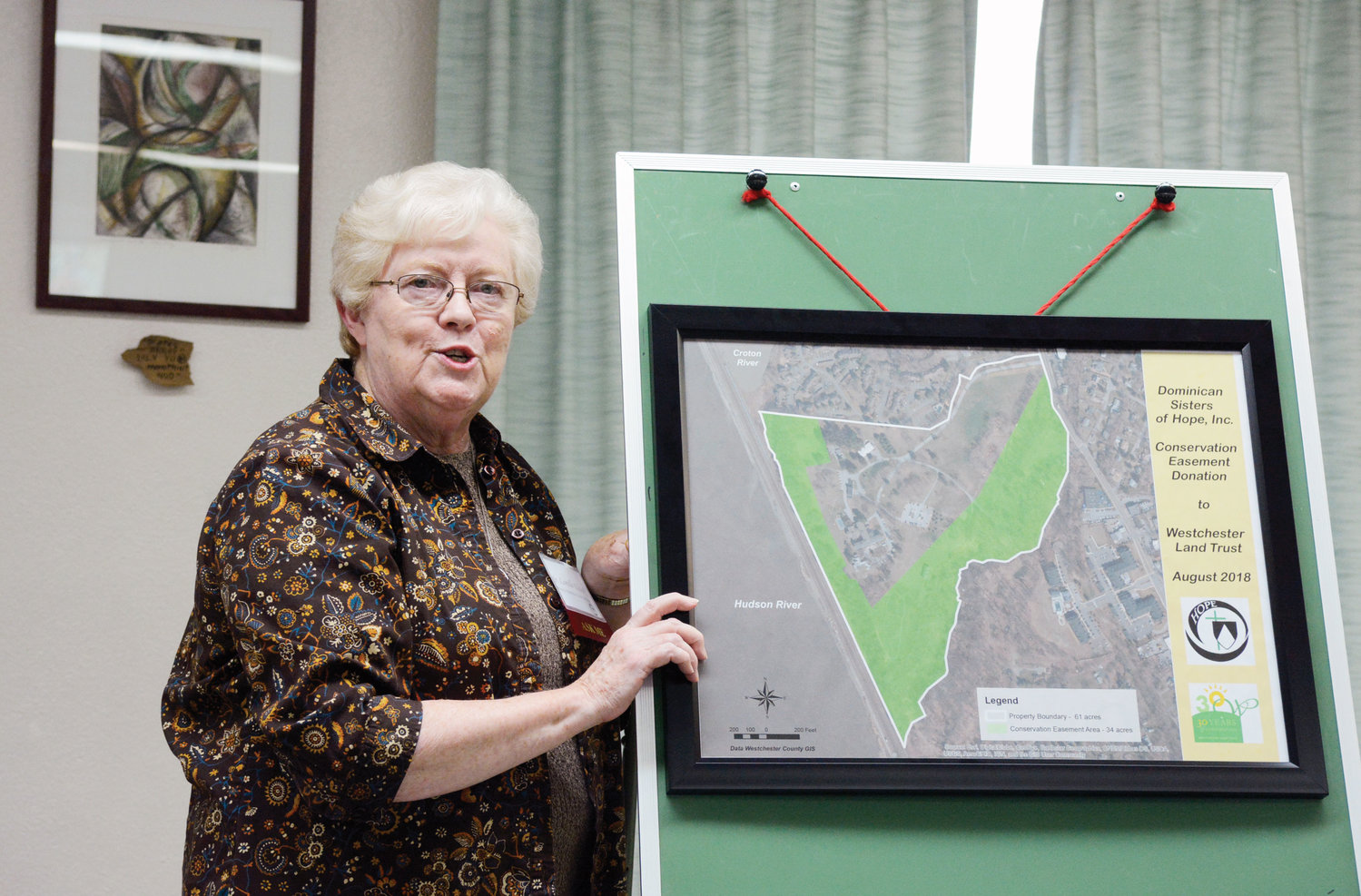
By Kelly Dunlap
“We are gathered here on the banks of the beautiful Hudson River to reclaim our place in the sacred community of life,” Sister Monica McGloin explained to an audience of nuns, conservationists, members of the press, and civic and community leaders. “We remember the red-tailed hawks, the eagles…. forgive us for destroying your habitat. We remember the white pines, the hemlock…. forgive us for poisoning and contaminating the environment…. We’ve been called to prayer, we have sought forgiveness, now let us pay attention to how we protect and preserve this land and all that lives upon it.”
This reflective and prayerful introduction kicked off a 2018 press conference at Mariandale, a sixty-one-acre property in Ossining, New York, owned by the Dominican Sisters of Hope. The celebratory conference marked the end of a seven-year discernment and planning journey.
Dominican spirituality is built on four pillars: study, community, service, and reflection/prayer. In 2011, the sisters chose to focus their study on their relationship with creation and their ongoing call to be in communion with all of it.
This focus on creation stewardship spoke to an ongoing, practical question in their community. About 23 years earlier, three Dominican groups had merged to create the current community. The new configuration meant that the sisters now owned more land than they needed and they had been asking themselves what should be done with the unused acres.
The learnings and convictions that came from the stewardship study guided their discernment of how to be faithful stewards of the excess property. For instance, even though a portion of the land would have been a prime property for development, they rejected that option since it was inconsistent with their values.
While Catholic religious orders are rooted in historical practices, structures, and theology, the Dominican Sisters believe God calls them to consider the needs of future generations. They feel it their religious duty not only to love their neighbors today but to consider the wellbeing of future generations.
Sr. Lorelle Elcock, then-prioress of the Dominican Sisters, explained her conviction: “We have a responsibility to be in right relationship with Earth, not over it or owning it, but as part of it, caring for it.”
Pressing environmental concerns like climate change and the need for land conservation rose to the surface as a key concern for the community. As the sisters considered different ways to protect the land, they held exploratory dialogues with conservation organizations and religious communities, like the nearby Maryknoll Sisters who had pursued similar protections.
After much prayer, study and dialogue, they decided to seek a conservation easement for thirty-four acres of their property. A conservation easement is “an agreement between a landowner and a land trust that permanently restricts the development of a property.”
After discerning the best use of the land, the work of finalizing the conservation easement still required a great deal of logistical, financial, and legal planning. According to Sister Elcock, keeping their “faith-inspired values” at the forefront during the lengthy process kept the sisters on track.
After additional years of careful planning, the sisters celebrated the completion of the easement with a press conference. The decision would “protect [the land’s] significant ecological resources, forever.”
“Our hope is that in the future, this land will be a source of healing for body, mind and spirit, as well as a place of refuge for the wildlife,” said Sister Elcock.
The conviction that their legacy ought to be consistent with their mission and faith-inspired values led to a bold move that will bless future generations, but the sisters aren’t done planning for the future. They’ve already begun exploring what might be the preferred future for Mariandale and its retreat center when they’re no longer around. As gatherings of many kinds at the center moved virtual during the pandemic and some continue in that format, they recognize the world is changing quickly, and they want to be faithful stewards of all of their resources. Just as they learned from fellow religious orders who pursued land preservation, they’re learning from the Nones and Nuns’ Land Justice Project about ways their land and Center at Mariandale might continue to be further transformed into an agent of justice.
The Sisters of St. Joseph in Brentwood, New York pursued several land stewardship projects including legal protection for a portion of their land to be used for sustainable farming, investment in solar panel installations, and more.
The Sisters of St. Joseph in Brentwood, New York pursued several land stewardship projects including legal protection for a portion of their land to be used for sustainable farming, investment in solar panel installations, and more.
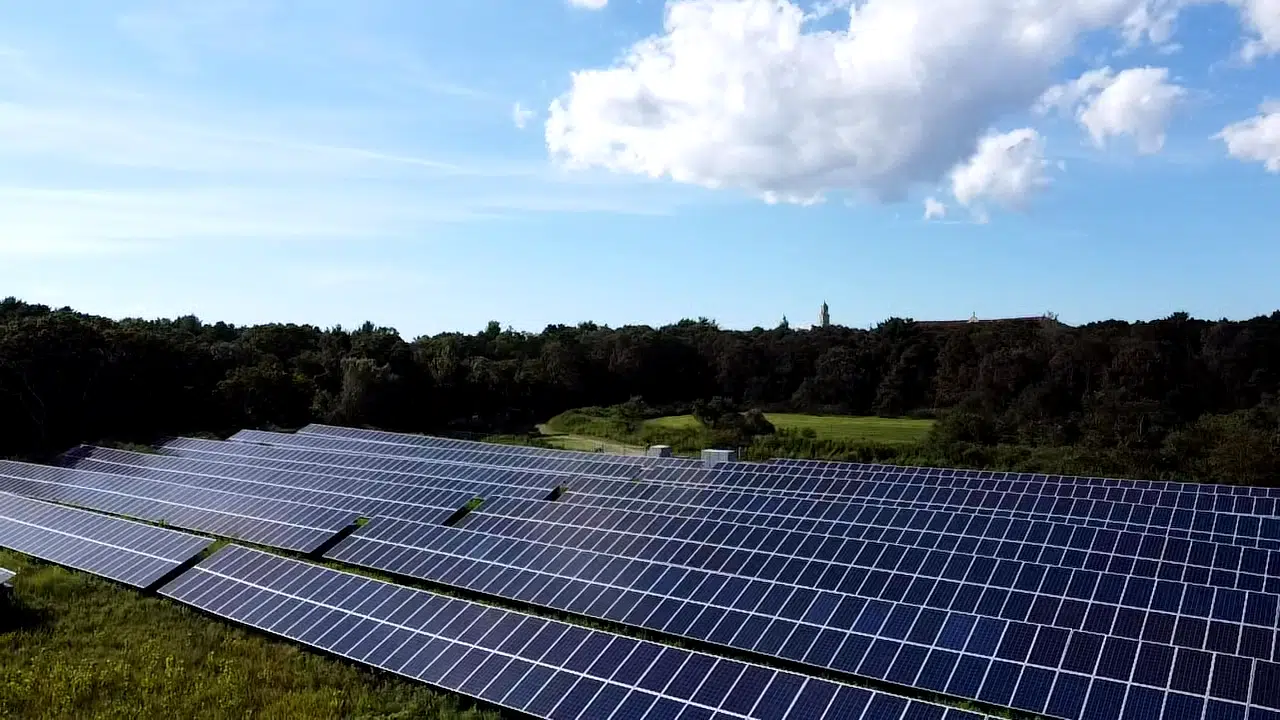
By Caleb Rollins
The journey to ceding control of faith community property can take years and often builds on intentional spiritual reflection and careful practical planning. The Sisters of St. Joseph in Brentwood, New York, whose roots go back to seventeenth-century France, exemplify how the persistence of preparation can lead to innovative and sacred use of religiously owned land.
The sisters run their ministry of justice and care for their neighbors from 212 acres of meadows and woodlands on Long Island. In 2002, the sisters began over a decade of communal study and reflection on how they might apply their ethics of justice to this land they hold. As a result, in 2015, the sisters created a Land Ethic Statement to guide their next steps in stewarding their property. “We will evaluate the consequences of all decisions made regarding the land in the context of our mission and will be aware of the interrelated justice issues and global implications,” the statement reads.
While they felt the time of study and conversation that led to the Land Ethic Statement was a transformational experience, they still had to put it into action. Sister Karen Burke, coordinator of Land Initiatives, said, “It was a moment of ‘everything looks good on paper, but now what?’”
Fortunately, through their years serving their neighbors on Long Island, the sisters had developed strong relationships in the community. A conversation with the local community foundation led to a connection with the Peconic Land Trust, an organization dedicated to preserving the farmland and natural lands of Long Island. With their Land Ethic Statement as a foundation, the Sisters of St. Joseph now had expert partners who could guide them with the legal and ecological knowledge often needed for intentional land stewardship.
The staff at the Peconic Land Trust helped the religious community develop a master plan for how best to manage their land sustainably and how they might transfer ownership into different types of conservation trusts. They initially focused on dedicating twenty-seven acres of their property to sustainable farming and ensured that the farming also aligned with their commitment to justice. To physically till the soil, the sisters partnered with local socially conscious farmers who focused on youth development, preserving native plants, and growing produce for local food banks. Through dedicating this land to sustainable farming and through navigating legal hoops for three years, the sisters eventually were able to sell their development rights of this acreage to Suffolk County’s Farmland Preservation Program. The land transition will ensure that this area of the sisters’ property is dedicated to sustainable agriculture practices in perpetuity.
This first project energized the land stewardship work of the Sisters of St. Joseph and spilled over into other projects. They invested in solar panel installations, rain gardens, growing native meadows, and environmentally friendly wastewater systems. Ultimately, they hope their view of the Earth and its creatures as sacred will continue to manifest on this land long after they are gone. With the help of their master plan and their partners at the Peconic Land Trust, they intend to preserve even more of their land through trusts, deed restrictions, and other easements. “The ultimate goal is to protect all the acreage from development,” says Sister Joan Gallagher.
This foresight and the perseverance required to slog through the legal minutiae of land rights sales stands on the work of learning and spiritual reflection the sisters began decades ago. Sister Karen believes that putting in place this foundation was a necessary step in their transformative work. Through connecting deeper with their traditions and identity based in the seventeenth century, the Sisters of St. Joseph were able to develop an innovative plan for their land that will serve the people, plants, creatures, and soils of Long Island for generations to come.
Cass Community United Methodist Church plans to build a village of 25 tiny houses that the working poor or formerly homeless can rent to own.
Cass Community United Methodist Church plans to build a village of 25 tiny houses that the working poor or formerly homeless can rent to own.
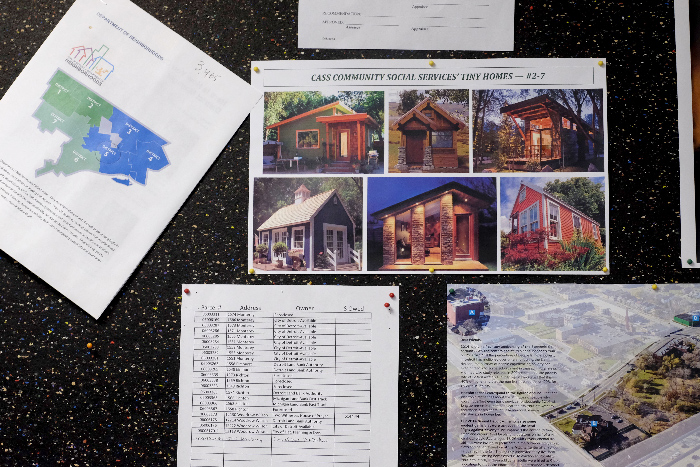
Excerpt from A Detroit pastor and her church are building something big with tiny homes by Patricia Montemurri for Faith & Leadership.
In Detroit’s urban core — ravaged by depopulation, unemployment and abandonment — the Rev. Faith Fowler is building something big with tiny homes.
The pastor of Cass Community United Methodist Church, known for her innovative, entrepreneurial outreach to the poor, has conceived and captained a project to build a village of 25 very small houses that the working poor or formerly homeless can rent to own.
But the homes are about more than a place to live, Fowler said. More importantly, they will be a foundation for the low-income poor to grow and hold an asset, to become stakeholders, literally and figuratively, in their neighborhood and in Detroit.
The Tiny Homes project is the result of much planning and thought. These are not cookie-cutter fabrications, mobile trailers or recycled shipping containers; the homes are designed to be not only efficient but eye-catching. Even darling.
Ranging from 250 to 400 square feet, they will have unique exteriors, evoking styles from mountain-lodge rustic to midcentury modern to New Orleans French Quarter. They will have decks and front porches and be built on individual lots.
The Tudor house — in effect, the development’s model — has a good-sized bathroom plus a single main room that features a sleeping nook, a living area, a washer-dryer and a full kitchen with donated granite countertops.
Seven years to home ownership
By year’s end, Fowler aims to have seven homes built and occupied. So far, more than 600 people have requested applications, hoping to meet the project’s financial qualifications to rent to own. If residents keep up rent payments for the first three years, they’ll qualify to make monthly payments on a subsequent four-year land contract, offering them full ownership in a total of seven years.
But the Cass development is not intended to be a glorified homeless shelter. Fowler says she’s aiming for a diverse group of inhabitants “so people won’t drive by and say, ‘That’s where the homeless live.’”
In fact, the homes are not necessarily for the homeless. Residents will need to have a source of monthly income. Cass envisions a mix of young and old, low-income workers, seniors on fixed incomes, people receiving disability benefits and students.
The Tiny Homes project will cost about $1.5 million, more than half of which Fowler has already raised from private donations and grants. Each house will cost about $40,000 to $50,000 to build, and volunteer groups, including United Methodist teams, will help with finishing touches, such as drywalling, painting and sodding lawns.
Asset-based perspective
“Most churches and others do ministries with the poor as a charity, and from a needs-based perspective,” Colmenares said. “We’re intentionally trying to lead the church away from a needs-based perspective.”
Colmenares said Fowler approaches ministry from an asset-based perspective, drawing upon the talents and labor of people in the community.
“She sees that those who have disabilities have assets,” Colmenares said. “Those who were in jail have assets. Those who were addicted and homeless — they have assets.”
At a recent open house, one visitor asked Conwell-Leigh why the houses aren’t designed to accommodate several individuals in shared living space. Conwell-Leigh explained that many poor people live communally out of necessity — in shelters, or with relatives and eating their meals at soup kitchens.
“Faith wants our folks to have what she had and so many of us have — a backyard, a place of our own,” she said.
But whoever lives in the Cass tiny homes won’t be alone. They can get help and community services just across the street.
“They can earn a GED, learn job training, use the gym facilities and get a free daily meal in our programs across the street,” Fowler said.
Mark Linton, 54, who lives in the low-rent apartments that CCSS renovated adjacent to the project, recently toured the showcase tiny home.
He’s on disability. He likes the Tudor’s curb appeal and the 300 square feet of efficient living space, “but it’s smaller than what I’ve got now,” he said.
When he hears about plans for three streets full of similar houses, Linton’s eyes widen, and he smiles.
“We need it around here. We have all these eyesores,” Linton said. “This will be beautiful.”
Read the full story.
Bethel AME is helping to address the affordable housing crisis in San Diego by building affordable units on their property. They raised funds to offset construction costs enough to make the project self-sustaining.
Bethel AME is helping to address the affordable housing crisis in San Diego by building affordable units on their property. They raised funds to offset construction costs enough to make the project self-sustaining.
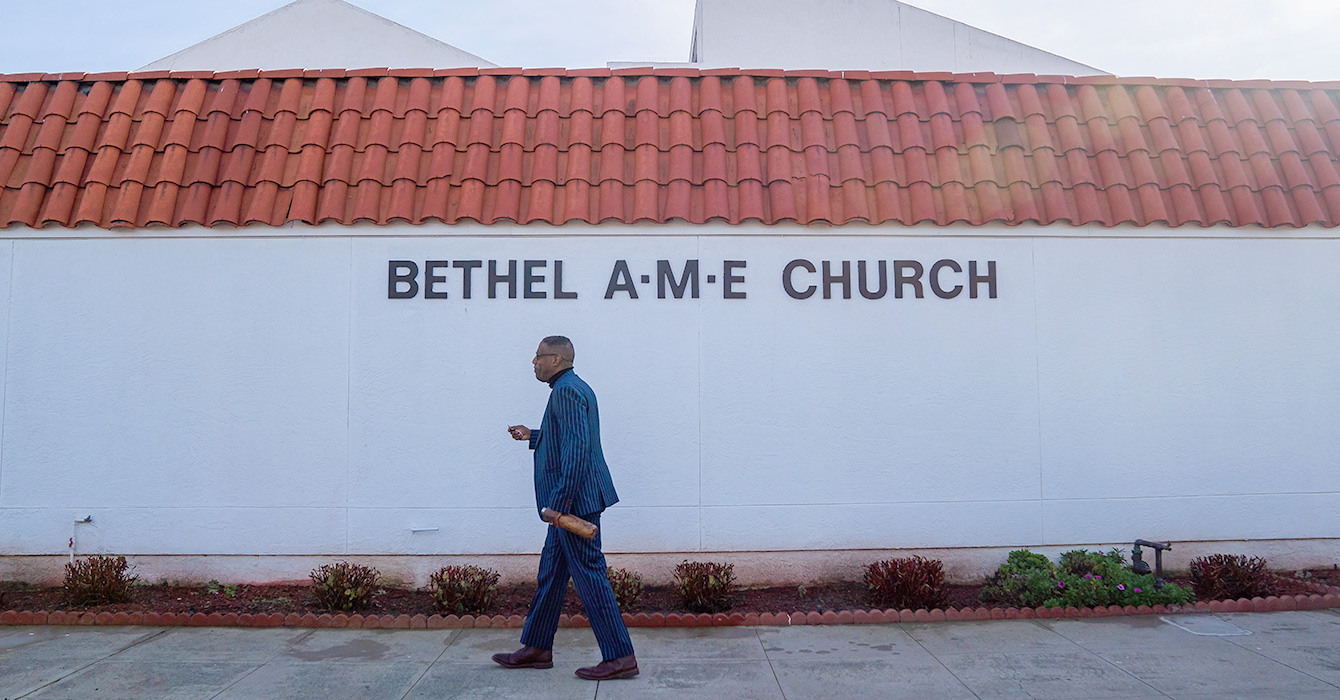
Excerpt from Yes in God’s Back Yard wants to build homes for those most in need of them by Kate Morrissey for Faith & Leadership.
A faith-based initiative anchored in San Diego wants to use property owned by religious institutions to help address the affordable-housing crisis in their city. The name is a reimagining of the old affordable housing debate between the “Not in my backyard” or NIMBY crowd and the “Yes in my backyard” or YIMBY contingents.
“Yes in God’s Back Yard” wants to make a difference. And Bethel AME and Pastor Harvey Vaughn III has committed to building affordable housing on church property.
Vaughn worked for a housing program at a St. Louis nonprofit before eventually heading to San Diego. His church, Bethel AME, is the city’s oldest Black church and has more than 600 congregants. When Vaughn heard a public radio report about homelessness and the lack of affordable housing in San Diego, he felt called to find a way for his church to get involved.
A 2020 study from the University of California, Berkeley found 38,800 acres of land in California used for religious purposes. Much of this land could potentially be developed to include affordable housing. In San Diego, the study found, faith communities owned 4,675 acres with development potential.
Vaughn believed that his church could be part of the solution.
Monica Ball has spearheaded the YIGBY program from the initial idea scrawled on napkins. For years, she worked to help people living on the street, and she saw organizations that had clients ready to move into homes but couldn’t find places for them to live.
Ball responded, “Even if only 10% of that land were developed for affordable housing, at 20 units per acre, more than 9,300 units would be added to San Diego’s market.”
“My faith community friends, all they can think to do is go downtown with backpacks, blankets, and bologna sandwiches, and we’re sitting on acres of land. It doesn’t take a genius to put together what needs to be done here. If enough religious institutions decided to participate in the effort, the current need could be met.”
The Berkeley study also found that religious organizations face barriers to building affordable housing on their properties. Those barriers include local building regulations, limited financing options and a lack of expertise in housing and real estate.
YIGBY hopes to offer options to streamline the process and guide houses of worship through the decisions they need to make.
Traditional affordable housing development takes about six years to complete and generally uses tax credit financing, according to Tom Theisen, former president of the regional task force on homelessness and member of the YIGBY advisory committee.
The costs per unit can easily reach $600,000. Such projects are not self-sustaining and require complex financing because the amount of rent money received from housing vouchers will not cover that cost. Using land already owned by faith communities, this model can be flipped and allow for innovative approaches that shorten the time frame and lower costs.
The YIGBY team’s goal is to develop self-sustaining projects that cost about $200,000 per unit so that rent will cover loan repayments.
But first YIGBY needed a proof-of-concept project. That’s where Vaughn and Bethel AME church stepped in about three years ago.
Vaughn said that his congregation quickly got on board after he presented the idea and that the conversation soon turned to the possibility of housing veterans. Because it’s home to both Navy and Marine bases, San Diego has a large military population, active and retired.
His project team began conducting site tours and, after seeing modular construction, decided to pursue that approach. Modular construction uses segments built off-site so that a building can be pieced together more quickly than traditional construction allows.
They raised funds to offset construction costs enough to make the project self-sustaining. Construction could begin as soon as in the next few months and is scheduled to wrap up in 2023.
Before taking on a project like building affordable housing, Vaughn said pastors must feel certain it is what they are called to do. Churches need to build trust when working with vulnerable populations. Churches need to build trust in the community in which they serve. And churches need to find trusted developers who will work with them in quality construction at affordable prices.
For Vaughn, being able to offer quality homes to people who need them will be worth the effort it is taking to get his YIGBY project up and running.
“This program can change the trajectory of a person’s life,” Vaughn said.
Read the full story.
What began in the '60s as church-based soup kitchen has transformed into an empowering, one-stop shop where visitors can pick out clothing, sign up for groceries, get lunch, register to vote, meet with health department and social service workers, get help with transportation issues, and more.
What began in the '60s as church-based soup kitchen has transformed into an empowering, one-stop shop where visitors can pick out clothing, sign up for groceries, get lunch, register to vote, meet with health department and social service workers, get help with transportation issues, and more.
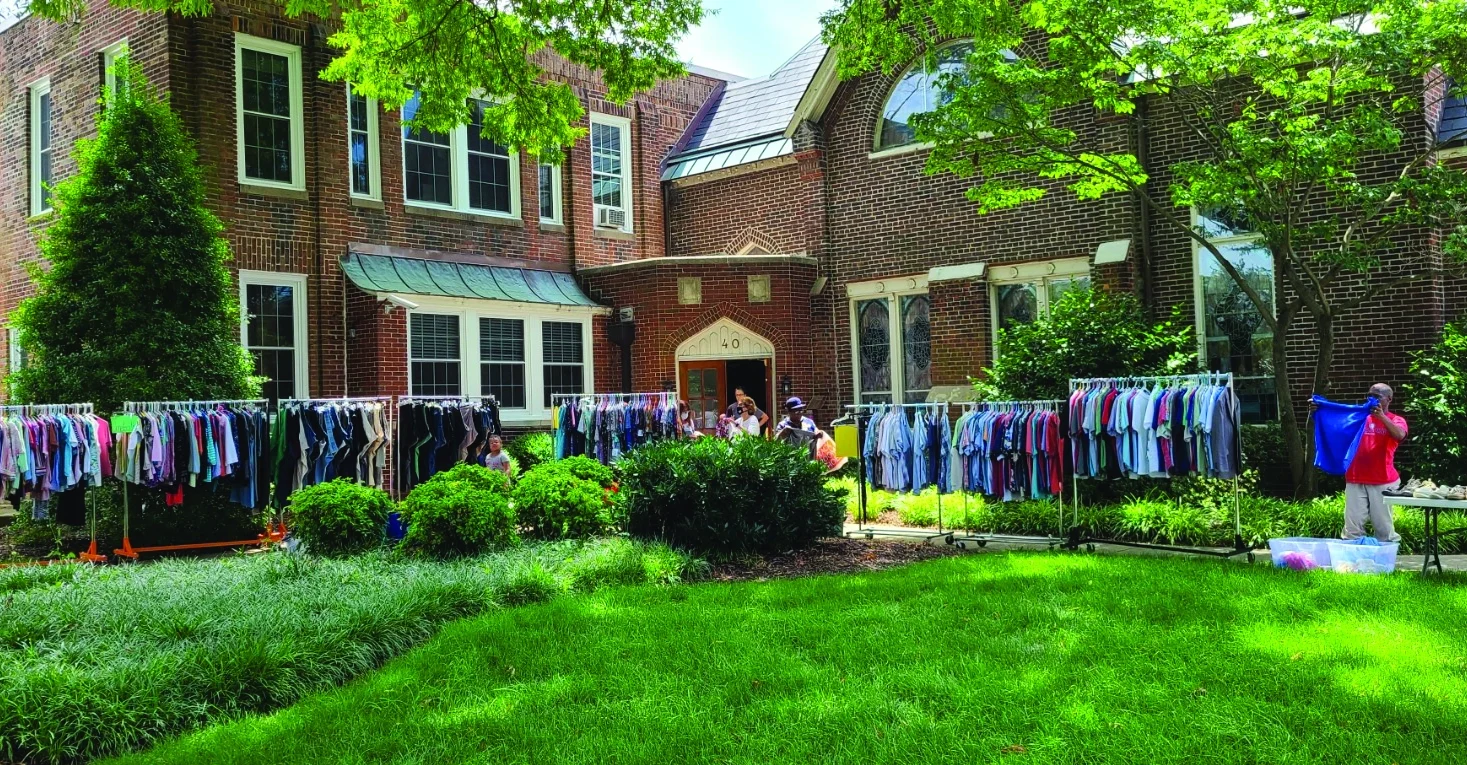
Excerpt from How Hampton Baptist Church helps level the playing field for good by Jennifer Colosimo for the Cooperative Baptist Fellowship blog
Back in the 1960s, Hampton Baptist Church started a soup kitchen to serve the food insecure community of Hampton, VA. After more than 50 years, organizers wanted to show that the program had also done some changing.
In 2015, the soup kitchen changed its name to SAME, an acronym meaning “So All May Eat.” It began changing into an organization concerned with much more than one hot meal every week.
The complimentary Monday meal is still the center piece of what they do; but it laid the foundation for a place where people could visit to feel welcome, cared for and lifted up on both sides of the buffet line.
It now includes a clothing closet that invites community members to shop, boutique-style, for clothing and accessories. Clients make their own style choices or can ask for assistance.
A monthly mobile food pantry also lets families pick out the groceries they want. In partnership with the Virginia Peninsula Foodbank, they include a delivery service for those who don’t have transportation.
“When we rebranded, we wanted to try to be more inclusive of people, and help them feel less patronized,” said Amy Witcover-Sandford, coordinator for SAME. “We wanted to step away from the idea that you visit a soup kitchen and get whatever they put on your plate to more of a welcoming place.”
“We care about sharing Jesus with people,” added Andrew Garnett, pastor of Hampton Baptist Church. “But we have an understanding that the Gospel is about more than that. It’s about the whole person.”
The handful of volunteers from which SAME originated has grown well into double digits including volunteers from the community. Youth groups from the area, local businesses, and civic organizations have helped to make an even bigger impact for the people in this community. All volunteers share in one accord remembering that people need to eat and to be treated with dignity, respect, and love.
SAME is doing more than just feeding others. People to come for lunch, shop for clothes, and sign up for groceries. And, people can also register to vote, meet with the health department or social services, get help with transportation issues and more. In 2021, volunteers helped nearly 1,000 different people, serving more than 4,000 lunches, giving away more than 6,000 articles of clothing, and delivering enough groceries for families to cook 16,000 meals.
Hampton Baptist is making a difference not only in the guests but also in the church members. The church is challenging its members, giving them something that stretches their mindset and gives them a point of pride in their ministry.
SAME is now a place where people with different ethnicities, backgrounds, socioeconomic statuses, are in community sharing, growing, making a difference. This is a powerful witness to what society could be when everyone sets asides differences and work for common good for everyone.
Read the full article.
Atlanta’s First Presbyterian Church launched a social entrepreneurship program to recognize how God was already moving in their city and to provide business mentorship and financial assistance to aspiring social entrepreneurs.
Atlanta’s First Presbyterian Church launched a social entrepreneurship program to recognize how God was already moving in their city and to provide business mentorship and financial assistance to aspiring social entrepreneurs.
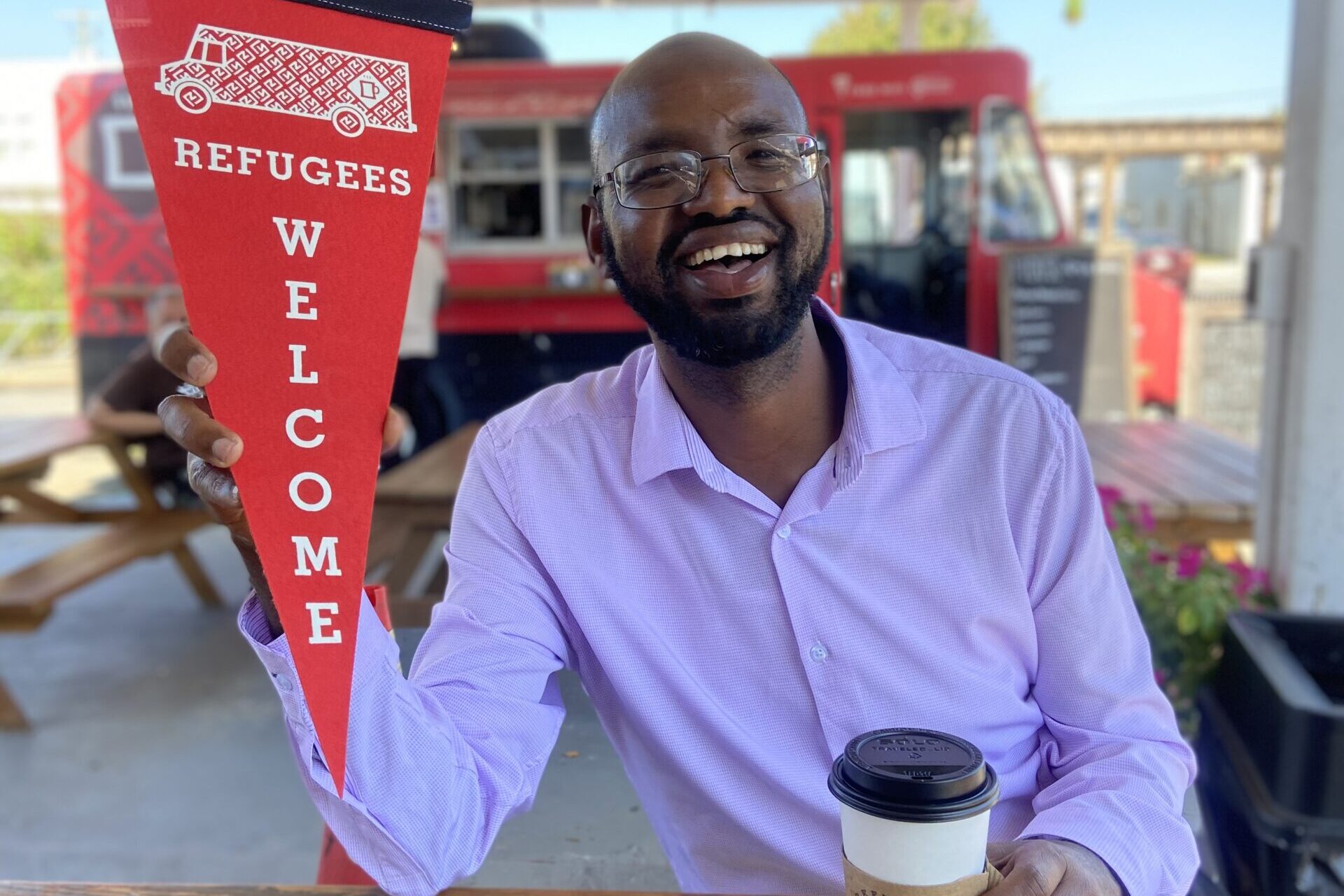
By Kelly Dunlap
The community surrounding Atlanta’s First Presbyterian Church has changed drastically since the church was founded nearly 170 years ago. What was then suburbia is now the heart of the metropolitan city. The church building’s Romanesque architecture, its name in the National Register of Historic Places, and its hymn-singing, organ-accompanied choir tell of a church with a rich history and an appreciation for tradition. But many who found a spiritual home at FPC wondered if God was calling them into something new.
The arrival of a new pastor in 2018 presented the opportunity to create a strategic plan and thus kicked off a period of discernment. Lay leaders and pastors felt called to explore ministry possibilities “beyond old models of mission and service.” They began trying to see their community with new eyes.
They asked: “What needs are we missing? What resources do we have that we’re not using?” Among these resources, they considered funding, space, material assets, and the congregants’ gifts and expertise.
With a fresh perspective of God’s work in the community and the congregation, the discernment committee identified a new ministry goal: “to promote individual economic empowerment.” But as FPC’s then-executive pastor Rebekah LeMon recounted, they got “stuck” determining how to pursue this goal. Still, they remained committed to seeing with new eyes and resisted resorting to familiar old solutions.
They found traction again when lay leader Ellen Adair Wyche learned of a social entrepreneurship program run by a Houston congregation. Social entrepreneurship is the process of developing a business that addresses a social problem.
Ellen Adair was energized by this new ministry model and arranged a meeting between the program’s creator and FPC leaders. What was calendared as a thirty-minute lunch stretched into two hours. After more conversation, extensive research, logistical planning, and recruiting of volunteers with passion for and expertise in business development, FPC launched its own social entrepreneurship program called Epiphany.
Epiphany solicits applications from aspiring and early-stage social entrepreneurs with business ideas that will be both financially sustainable and address challenges facing the community. They’re seeking proposals that address “homelessness, housing, refugee resettlement, criminal justice reform, racial equity, poverty, human rights, employment, health care, community development, or education.”
After thoughtful consideration of the proposed business models, Epiphany leaders select finalists who then receive assistance from experienced mentors and coaches, recruited from the congregation itself, in refining their business plans. After this period of collaborative and hands-on development, Epiphany leaders choose a small number of applicants to become Epiphany fellows and receive funding. Funding amounts vary by year and are dependent on the generosity of the congregation and the needs of the venture. The 2022 cohort received grants from a $200,000 funding pool.
Epiphany’s first round of grants helped launch a coffee company that provides job training and a living wage to resettled refugees; a mobile app that provides basic information about housing court to reduce evictions; a candied pecan business that helps fund Meals on Wheels, and more.
One of the program’s most unexpected positive outcomes is how it’s engaged and empowered the congregation. Some church members, who had not yet participated in mission projects but who had professional expertise to coach and mentor these entrepreneurs, stepped up to volunteer. Epiphany, then, not only identifies and affirms the potential within social entrepreneurs but also that of volunteers. According to Ellen Adair, the congregation responded with an “enthusiasm and commitment beyond what we’ve seen” for other church projects. It also sparked some to think more deeply about the connection between their professional lives and vocation.
Leaders named the program Epiphany, in part, as a testimony to how an established church began to see itself and God’s work in the world in new ways. Through faithful discernment—or “being led by the Spirit,” as Ellen Adair describes it—they discovered and stepped into a new way of doing ministry. To FPC lead pastor Tony Sundermeier, this is the epitome of the journey to Epiphany: “Being surprised by God, inviting us to participate in what God is doing in ways we couldn’t have fathomed or imagined.”
Finally, as Ellen Adair points out, the work of Epiphany is actually not a novel venture within the Christian tradition: “Christians have long been in the business of building sustainable social systems to supporting human flourishing.” In fact, Epiphany is a “modern way to recapture an ancient idea.”
Farm Church does not own a church building but instead uses a lot of land from a local nonprofit that they farm each Sunday morning before worshiping together on the same property.
Farm Church does not own a church building but instead uses a lot of land from a local nonprofit that they farm each Sunday morning before worshiping together on the same property.
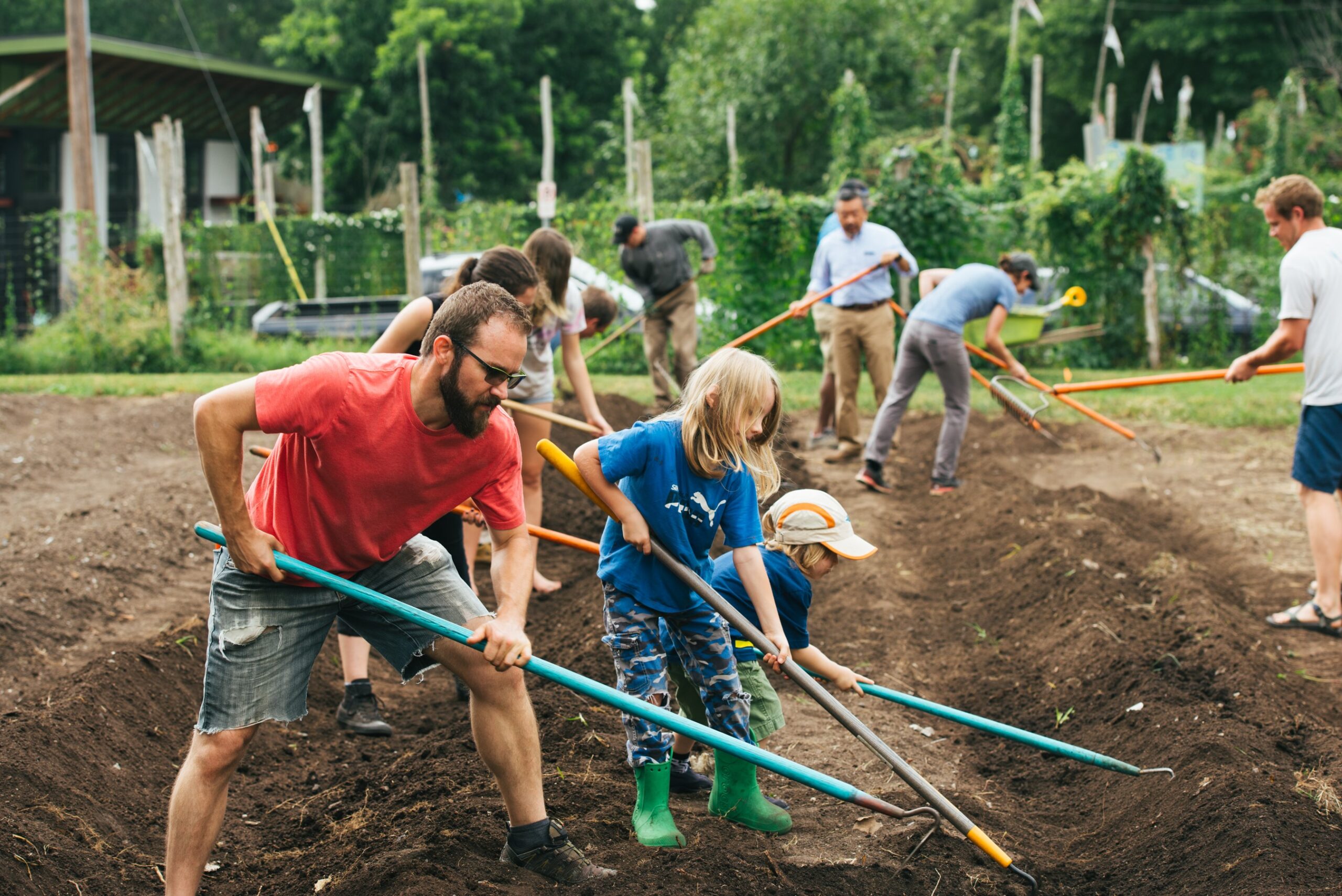
By Kelly Dunlap
If you visit Farm Church on a Sunday morning, you might catch rows of tomatoes out of the corner of your eye, and church-goers will likely have fresh dirt under their fingernails when they pass the peace.
Farm Church is not a metaphor. The small congregation in Durham, North Carolina farms a small plot of land together every Sunday before gathering just a few feet away to worship.
This unique church model was dreamed up by pastor Ben Johnston-Krase and founded alongside two other pastors and with support from the PCUSA. The pastors, who had shepherded more traditional congregations, were energized by the idea of a church whose primary unifying mission was to respond to a social problem. Finding spiritual and social meaning in farming, they determined to focus on the problem of food insecurity and to respond by growing food to give away.
Now in its seventh year, Farm Church donates produce to local nonprofits and churches who put it directly into the hands of those experiencing food insecurity. Between January and August of 2022, the church harvested and gave away over 1,000 pounds of food. The vast majority of that weight came from leafy greens, with heavier vegetables like carrots and onions still growing.
Ben, who now leads Farm Church in the role of co-chaplain, explains that through their labor and donations, they’re making the statement: “People are worthy of good food – food that is fresh and nutritious.”
***
In addition to the atypical Sunday schedule, worship location, and specificity of mission, the church offers a different kind of Christian community.
Ben says they set out from the beginning to be a place for those who were wounded – some by the church itself. Many who attend Farm Church are not inclined to show up at a church building on Sunday. Its location makes the church a “less baggage-laden environment,” says co-chaplain Cole Parke-West.
“It’s the love and care between us that functions as the ‘mortar’ in our brick-free church,” they recently shared in an instagram post.
While the church is unmoving in their mission to farm, they welcome an expansive theology and allow worship rhythms to evolve. “We’re about the radical welcome of Christ,” Ben explains. To be a welcoming place of spiritual nourishment for those not as comfortable with traditional church, they forgo some church elements like membership and creeds and welcome wisdom from outside the Christian tradition, alongside doubt and questions.
Ben sums up the church’s core theological message: “We articulate the good news by giving away a lot of food.”
***
The co-chaplains have words of both encouragement and caution for those who may want to begin a similar community or incorporate elements of Farm Church into their own.
Check your capacity, Ben cautions. Audit what consumes your church’s time and energy. Then ask: Can we drastically shift attention and resources from typical demands (like building maintenance and budget concerns, for example) to nontraditional priorities?
Cole agrees: “It’s not a matter of making minor tweaks while maintaining the status quo.” In addition to auditing your capacity, audit the power dynamics in your community. They urge careful consideration of whose voices frame the social problem and the solution you might want to tackle. By centering the voices of those who have traditionally held power and privilege, you might unintentionally perpetuate the unjust dynamics inherent in the social problem you’re trying to address.
Farm Church admits that this is not necessarily easy or straightforward. Its own community is made up of people who hold privilege as white Americans and who are not themselves food insecure. Still, the congregation maintains that diverse representation and ceding power to the historically marginalized should be a core value, and it’s one they’re pursuing.
Cole says the result will be a “radical re-centering” that will – or should – be transformational. They admit that transformation and new ministry models often come with risk, “but isn’t any act of faith risky?”
A monthlong fast led a church to donate $150,000 to students at HBCUs who needed financial assistance in order to graduate.
A monthlong fast led a church to donate $150,000 to students at HBCUs who needed financial assistance in order to graduate.
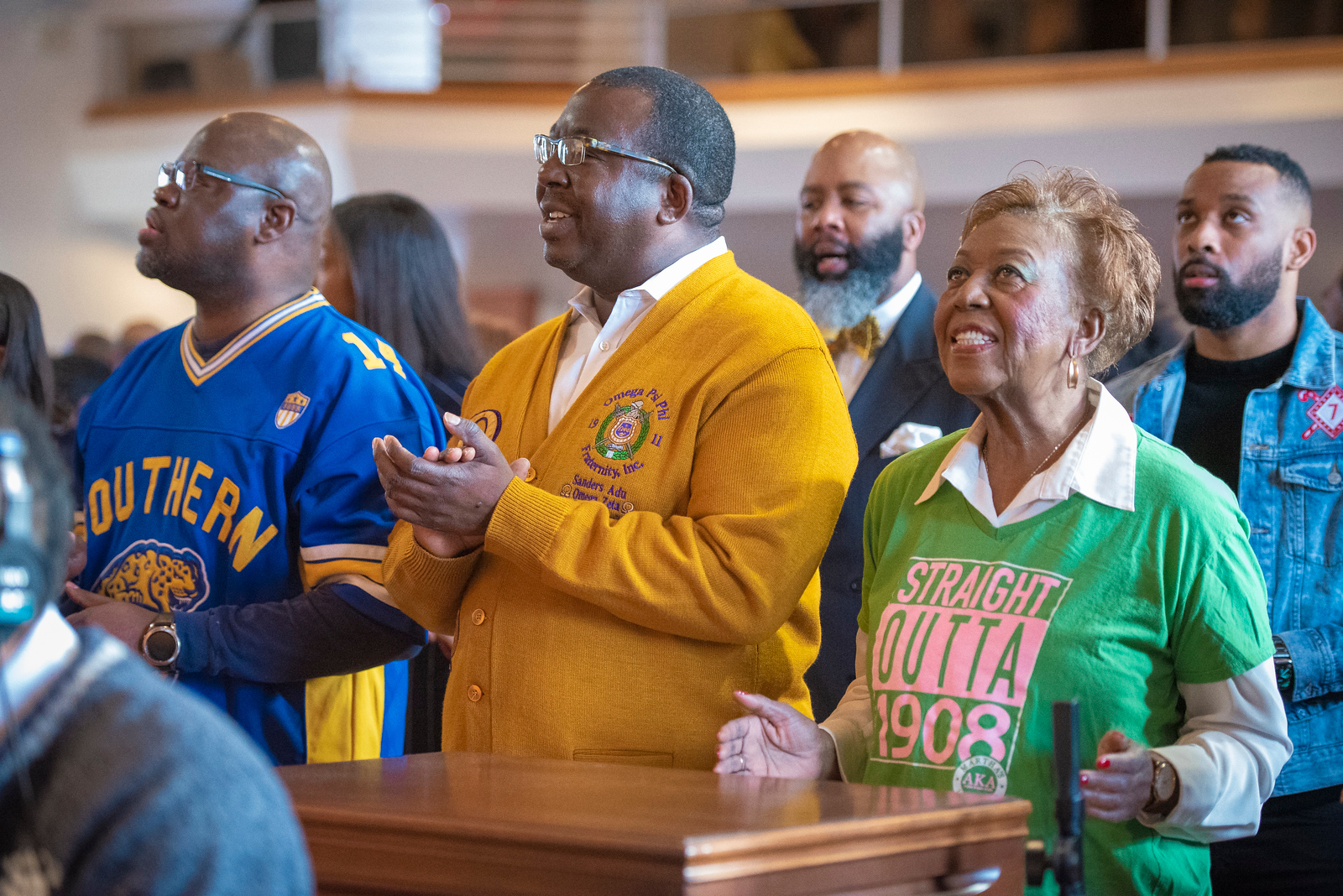
By Starlette Thomas
A monthlong fast led a church to step up to the plate for thirty-four unsuspecting college students. Located in Alexandria, Virginia, and dating back to 1803, Alfred Street Baptist Church, one of the oldest African American faith communities in the state, has a long history of giving back to its community.
During the Civil War, the church collected the “Poor Saints” offering. In the 1920s, it had a “lending library,” which offered a collection of sixteen hundred books to African American residents. Since there was no school for African American children, then pastor Rev. Andrew Warren Adkins assisted in founding the Parker Gray High School. He even served as a high school teacher.
The church established the Alfred Street Baptist Church Foundation in 2002, which regularly provides college scholarships to high school students. Showing support from start and now to finish, it’s an expression of the church’s mission. Members are also encouraged to start their own “Legacy Scholarship” through the foundation, ensuring that educational opportunities are passed down.
The church’s current pastor, Rev. Dr. Howard-John Wesley, invited members to fast not only from food but also from social media and unnecessary spending. It was 2019. At the beginning of the year, New Year’s resolutions are common, expected even as persons set goals to be a better version of themselves than the previous year.
Leading by example, the pastor cut his $4-a-day coffee expense and donated the money instead. It all added up, and what they gave in return, recipients like Mya Thompson, a twenty-five-year-old senior at Howard University in Washington, D.C., didn’t see coming.
Churches in the United States have a long history of offering financial support to students seeking to pursue postsecondary education. No matter their size, faith tradition, or geographic location, churches have sought to meet the spiritual as well as social and personal needs of their communities.
Pooling resources and sharing the burden of others, the members of Alfred Street Baptist Church continue a practice started by the early church members (Acts 2:44; 4:32). It is what Christians have done for centuries.
“We said we would pray as a church to what the Lord was telling us to do [with the money] and that we would donate it 100 percent outside of the church,” Wesley said. It turned out to be an answer to prayer for those stuck between student debt and a graduation date.
The church had hoped to reach a goal of $25,000, but it far exceeded their expectations, not doubling but more than quadrupling to $150,000.
Mark Lavarin and Elijah McDavid, the pastor’s assistants, came up with the idea to donate the money to historically black colleges and universities (HBCUs), and the congregation wasn’t let in on the surprise until after the money had been donated.
“The entire congregation was just moved to tears,” said Wesley. “In this time . . . we feel it is important as a body of faith that we exemplify what it means to take care of strangers.”
Howard University received $100,000; and Bennett College in Greensboro, North Carolina, a college for women, received $50,000.
Wesley worked with officials at Howard University to identify students in need. These students were ready to graduate but would not have been able to without the church’s assistance. The debt was preventing them from graduating. For Thompson, it was $2,500.
Wayne A. I. Frederick, Howard University’s president, said, “It will teach them about paying forward and teach them about the responsibility to the community around them.” Mya Thompson certainly feels this sense of responsibility.
“What Alfred Street did for me, I feel like next semester or next year as an alumna of the university I can come back and do something nice, maybe pay for their books or pay for their graduation fee,” she said. “I feel like it’s my duty to do that for students of my university,” Thompson said.
Sources
Alfred Street, History, accessed October 18, 2022, https://www.alfredstreet.org/about-us/church-history/.
Alfred Street, Newsroom, accessed October 18, 2022, https://www.alfredstreet.org/newsroom.
Katie Kindelan, “After a month-long fast, church pays off $100,000 in debt for 34 college students,” GMA, February 15, 2019, https://www.goodmorningamerica.com/living/story/month-long-fast-church-pays-off-100000-debt-61046793.
First Baptist Church of Clarendon in Arlington, Virginia decided to serve its community by sharing its square footage for affordable housing, a child development center, and a seminary.
First Baptist Church of Clarendon in Arlington, Virginia decided to serve its community by sharing its square footage for affordable housing, a child development center, and a seminary.

By Starlette Thomas
Would you believe a church building is not just a sacred space for its members, but could be shared with the community? More than pews and Sunday school classrooms, what if a church was used outside of Wednesday nights and Sunday mornings?
What if, in addition to a gathering place for worship and discipleship, a church was used to provide low-income housing and a place of learning?
Church-building renovations typically seek to improve the existing structure and to keep up with the changing needs of the congregation. We’ve all experienced a church giving campaign or two, where we were invited to pledge to give to the “building fund.”
This fund is often used for building maintenance and repairs. Sometimes the members decide a new building is needed for any number of reasons, including a growing congregation. But what about a growing community?
What began as the First Baptist Church of Clarendon in Arlington, Virginia, then a community of ten thousand residents, became a multipurpose building for a city of nearly forty thousand. It was the church’s third renovation, and the leaders decided to mix things up a bit.
Like so many congregations throughout the United States, theirs was graying, and the building was aging. The members could no longer keep up with the financial responsibilities due to the rising costs of a property that now serviced only one hundred members each week.
The church’s leaders saw it coming. The attendance began to decline in the 1970s. It was inevitable, and the leaders decided they needed to take decisive action to ensure that both the building and the opportunity to worship in it remained.
So, with the approval of Arlington County, the church’s leaders sold its “air rights” to a developer for $5.6 million in exchange for an eight-story apartment building with 60 percent of the units designated to provide affordable housing for low-income tenants. The two-story church would also be renovated and maintain its Georgian façade and steeple. According to the church’s website, “The church steeple remains in place, a beacon that shows the building is a place of worship.”
The John Leland Center for Theological Studies as well as a child development center would return to the church’s educational building. “It’s a great move for Leland,” said Mark Olson, the seminary’s president. “It’s in the middle of a very urban environment, close to a busy Metro stop and very accessible to anyone in the D.C. area. There are tons of young people, especially at night. It’s an exciting place to be for a seminary that wants to be on the cutting edge.”
Completed in 2012 and renamed the Church at Clarendon, the building serves its community by sharing its square footage. For two years the church’s members had been meeting all over the neighborhood, and now they would welcome neighbors to their new home.
Rev. David Perdue, the church’s interim senior pastor at the time of the renovation, said, “We’re reintroducing ourselves to the community. . . .We’re prepared to receive visitors and let them know: this is who we are.”
Sources
“Our Story: How It All Started . . . ,” The Church at Clarendon, accessed October 19, 2022, https://www.1bc.org/our-story.
“Church at Clarendon prepares for ‘Homecoming,’” ARL Now, February 22, 2012, https://www.arlnow.com/2012/02/22/church-at-clarendon-prepares-for-homecoming.
Jim White, “Updated: Leland Center moves to church complex in Arlington,” Baptist News Global, September 27, 2011, https://baptistnews.com/article/updatedlelandcentermovestochurchcomplexinarlington/#.Y4eNhOzMJ_Q.
The Church of Jesus Christ of Latter-day Saints gave $32 million to the United Nations World Food Programme - the largest single donation to-date to a humanitarian organization - to fight the global hunger crisis.
The Church of Jesus Christ of Latter-day Saints gave $32 million to the United Nations World Food Programme - the largest single donation to-date to a humanitarian organization - to fight the global hunger crisis.

By Starlette Thomas
What would you do with 32 million dollars? This question might be posed to a potential lottery winner. Fortunately, for this story, you won’t need to buy a lottery ticket or stay up late to watch the lucky numbers roll in. Just keep reading.
What if a faith-based group decided to give it away? To share it with those who have needs far greater in places of conflict and of natural and human-made disaster?
In September 2022, The Church of Jesus Christ of Latter-day Saints gave the largest single donation to date to a humanitarian organization—$32 million.
The United Nations World Food Programme (WFP), whose mission is “saving lives in emergencies and using food assistance to build a pathway to peace, stability and prosperity for people recovering from conflict, disasters and the impact of climate change,” has been at the forefront of this global need and on the front lines for more than sixty years. But with twenty-one thousand staff members worldwide and though the world’s largest humanitarian organization, they still need a helping hand, which The Church of Jesus Christ of Latter-day Saints was happy to lend.
It’s not the first time the group has given so generously. But this donation tops the previous one, where Latter-day Saint Charities, the Church’s humanitarian arm, gave a $20 million grant to the United Nations International Children’s Emergency Fund (UNICEF) in support of their work to increase access to COVID care and resources.
Rather than setting up an endowment or investing in property or more building improvements, the Church began a partnership with the World Food Programme in 2014. The Church of Jesus Christ of Latter-day Saints gives roughly $1 billion annually to address the world’s needs.
The money was given in response to a world in crisis due to COVID-19 as well as the issues that preceded it, which were then exacerbated by the pandemic. It will be used to fight the ongoing global hunger crisis and is literally a life-saving gift.
World Food Programme executive director David Beasley called it an “extraordinary donation.” World Food USA president and CEO Barron Segar thanked the Church for what he described as a “transformational gift.” “I am confident that the Church’s gift will inspire others to join our movement to end global hunger,” Segar said.
The donation will help 1.6 million people in nine countries, providing food and critical assistance. The money will be directed to the most vulnerable communities in Afghanistan, the Democratic Republic of the Congo, Ethiopia, Haiti, Kenya, Nigeria, Somalia, South Sudan, and Yemen.
“We are so grateful to collaborate with the World Food Programme because we know they will get food to those who need it most,” said Bishop L. Todd Budge, the second counselor in the Presiding Bishopric. He presented the donation in Rome, Italy. “And we thank Latter-day Saints and friends of the faith whose financial sacrifices have made this gift possible. Such giving makes God’s children a little happier and all of us a little holier.”
The Church of Latter-day Saints described itself as a missionary church much like the early church. Formed after its founder Joseph Smith had an encounter with two heavenly beings in 1820, the Church was formally organized ten years later in 1830 in Fayette, New York. To date, the faith claims 15.6 million members around the world. So the Church is just giving to its neighbors.
Bishop Budge told Church News, “The humanitarian outreach of the Church is given without regard to race, nationality, religion, sexual orientation, or any of those things, the labels that tend to divide us. We reach out to everyone—all of God’s children—because God loves them all.” That’s the way we all win.
Sources
Mary Richards, “Church gives $32 million to World Food Programme in largest one-time donation to date,” Church News, September 14, 2022, https://www.thechurchnews.com/global/2022/9/14/23353487/church-gives-32-million-dollars-to-world-food-programme-largest-one-time-donation-to-date.
“Latter-day Saint Charities commits US$20 million in support of UNICEF’s global COVID-19 response,” UNICEF Press Release, February 26, 2021, https://www.unicef.org/press-releases/latter-day-saint-charities-commits-us20-million-support-unicefs-global-covid-19.
Alfred Street Baptist Church donated $1 million to Jackson State University during a water crisis to help students who had incurred related expenses and to help the university respond to the crisis.
Alfred Street Baptist Church donated $1 million to Jackson State University during a water crisis to help students who had incurred related expenses and to help the university respond to the crisis.

By Starlette Thomas
Jackson, Mississippi, has a water crisis. Honestly, the city has been in crisis for years now. Even before the water stopped running in parts of the capital city, residents didn’t consider it safe to drink.
Then the water treatment system failed, after flooding exacerbated existing problems, and residents were left to find water to meet their daily needs or to boil the water that now ran brown in their kitchen sinks.
In an interview with National Public Radio (NPR), Jackson resident Fran Bridges said, “Any house we go to in Jackson, you have to realize that people have been traumatized.” Bridges added, “And you just have everybody almost in a daze.”
What can a church or organization do when a system fails its community? Miraculously, Jesus turned water into wine at a wedding banquet. What miracles could God perform through a church or organization for this city?
Alfred Street Baptist Church in Arlington, Virginia, has a long-standing history of supporting communities in need and has strong ties to the historically black colleges and universities (HBCUs). In fact, it hosts an annual “HBCU Festival,” now in its twentieth year and “is dedicated to connecting high school students and their families to HBCUs and scholarship opportunities.”
Consequently, it came as no surprise when the church announced in a press release “Alfred Street Baptist Church’s (ASBC) Mission Division will donate up to $1 million to Jackson State University (JSU) to help defray costs related to the ongoing water crisis in Jackson, MS, which began in late August 2022.” Meeting two needs with one donation, the church addressed the needs associated with both clean water and education.
Due to the water crisis, the university’s staff was forced to work remotely while students attended classes virtually. But it is hard to do either when you haven’t had a shower.
The city’s water pressure remained low, but the pressures of campus life continued. Students still had books to read and papers to write.
Unfortunately, these students, while experiencing trauma, were still expected to login for lectures and discussion. But with no running water, the campus and halls were clear. It was clear they were going to need a miracle.
“We are incredibly grateful for the generosity and philanthropy of Alfred Street Baptist Church, which has a long history of being an advocate for historically black colleges and universities,” said JSU president Thomas K. Hudson. “Reverend Wesley and the Alfred Street family are living examples of the saying, ‘give and it will be given to you.’ This $1 million donation will make a significant difference for our students and the solvency of our institution.”
The gift sought specifically to help the university’s students. Almost $400,000 was designated to assist students who had incurred expenses due to the water crisis. The remaining funds will be used to address the university’s needs to include portable restrooms and showers.
“ASBC is pleased to provide support to one of the nation’s largest HBCUs in a crisis that impacts students’ daily existence on campus,” said Rev. Dr. Howard-John Wesley, the pastor of Alfred Street Baptist Church. “Effective learning cannot happen without ensuring that . . . the basic needs of these students are met.”
Sources
“Alfred Street Baptist Church Designates $1 Million to Jackson State University for Support During Water Crisis,” September 27, 2022, https://www.pr.com/press-release/870392.
Debbie Elliot, “Jackson, Miss., residents struggle with basic needs as the water crisis disrupts life,” October 1, 2022, https://www.npr.org/2022/10/01/1126121420/jackson-miss-residents-struggle-with-basic-needs-as-the-water-crisis-disrupts-li.
An English-speaking Seventh-Day Adventist church donates a $1 million dollar property to a Spanish-speaking Seventh-Day Adventist church.
An English-speaking Seventh-Day Adventist church donates a $1 million dollar property to a Spanish-speaking Seventh-Day Adventist church.
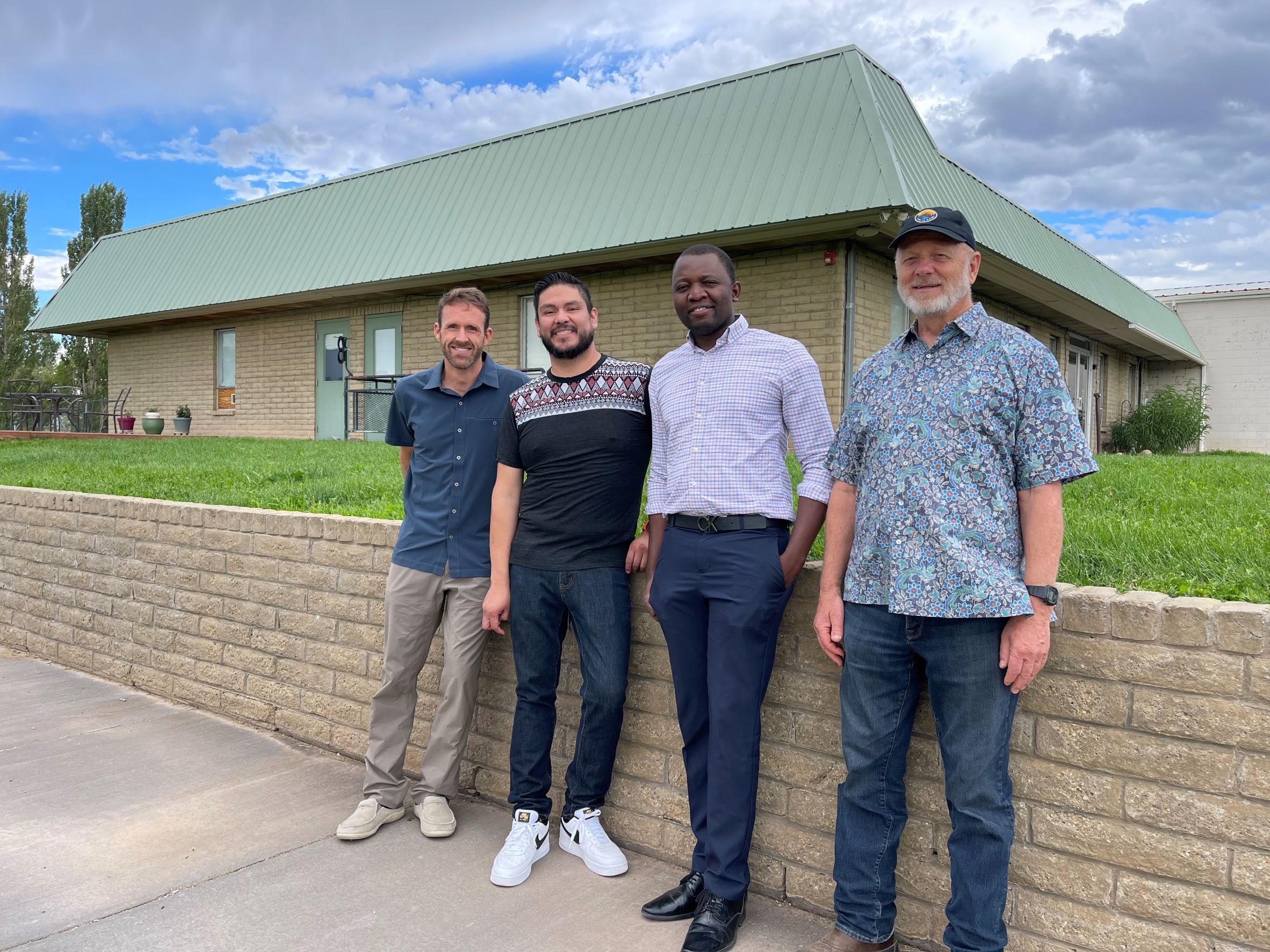
By Starlette Thomas
One congregation speaks English, and the other speaks Spanish, but the two Seventh-day Adventist (SDA) churches share a language of faith both can understand.
At Montrose Seventh-day Adventist Church this year, a retired pastor’s praying hands pointed him to a novel idea. What if you opened your hands and gave it away?
And by it, he meant a property worth $1 million.
“Lord,” retired pastor Fritz Kreiger prayed, “what would you have us do with our school property?” He wasn’t expecting the reply. “Give it away.”
Talk about coming bearing gifts! The building is twenty thousand square feet on four and a half acres of land. Previously, it had served as the location for an Adventist school and was also being rented to another ministry.
It wasn’t a feeling he could shake off. Kreiger described it as “a strong impression that settled on him.” He wrote later about his response after discerning that the church was to give the property away, “Well, that’s a crazy idea! But the thought persisted.”
Kreiger wasn’t the only one praying about a building. The Montrose Hispanic Seventh-day Adventist Church is growing. The pastor, Leonardo Jimenez-Chale, could see from his pulpit that the congregation had outgrown the chapel. The church’s leaders were looking for space to rent or purchase.
Both men were aware of the trend, the increased number of Hispanic members within their tradition. More space needed to be created to welcome them.
Kreiger and Montrose SDA’s pastor Nathan Cranson shared the idea with the congregation, certain there would be pushback. To their surprise, there wasn’t any.
Cranson shared the news with the Hispanic congregation and was greeted by the principal elder of the church with a hug. The squeeze seemed to release any feelings of anxiety, which were replaced with joy. A sweet relief!
Cranson described it as “what God has so beautifully orchestrated.” Praying hands had brought these two congregations together. God’s hands had brought it all together.
Pastor Cranson thought, We have just given away a million-dollar asset. He looked out at the congregation the following Sunday and noted the sweet fellowship as they shared Communion. “Rather than a divided church, we witnessed perhaps the greatest Communion attendance ever in church,” he said.
Giving the property away had somehow drawn them closer in their relationship to each other and with Jesus. With one so-called crazy idea down, Cranson remarked, “It is time we start acting on more of these ‘crazy ideas.’”
Sources
Nathan Cranson, “When God leads the way,” Rocky Mountain Conference of Seventh-day Adventists, September 1, 2022, https://www.rmcsda.org/when-god-leads-the-way.
“Local Church in the U.S. Receives $1 million dollar gift,” Adventist World, September 16, 2022, https://www.adventistworld.org/local-church-in-the-u-s-receives-a-1-million-gift.
“Montrose Hispanic Seventh-day Adventist Church,” Office of Archives, Statistics and Research, accessed October 19, 2022, https://adventistdirectory.org/ViewEntity.aspx?EntityID=53680.
A Disciples of Christ church faced closure due to declining membership and decided to turn the building over to new leadership to be used as a community hub and incubation space for new faith communities.
A Disciples of Christ church faced closure due to declining membership and decided to turn the building over to new leadership to be used as a community hub and incubation space for new faith communities.
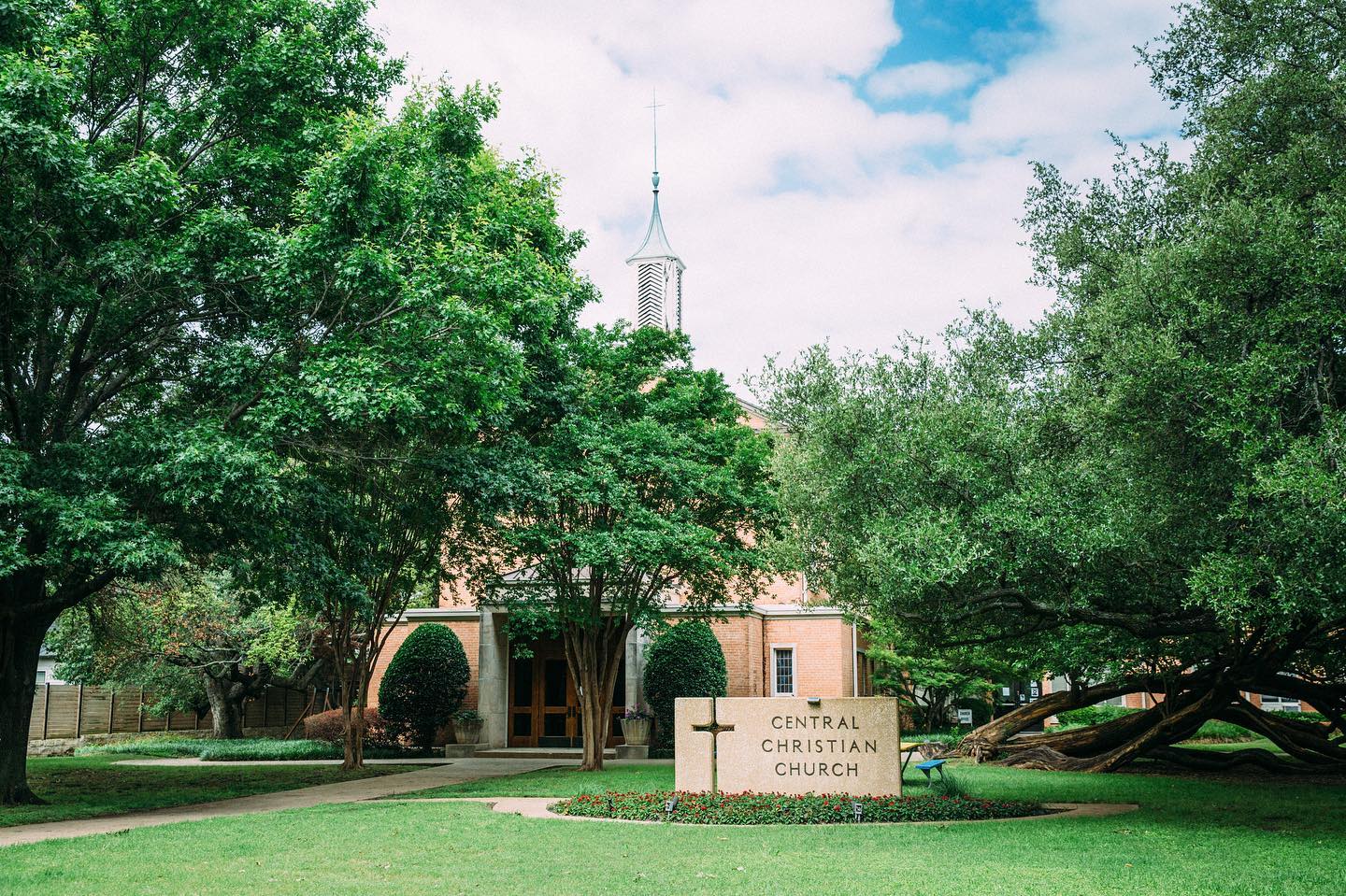
By Caleb Rollins
February 2022
Seven years ago Blake Schwarz started noticing a pattern around the Dallas-Fort Worth area. Some churches were closing, but others were just beginning. Churches ending their ministries held strategic real estate, but the new churches lacked the resources needed to find useful and sustainable physical homes. Schwarz realized the Christian leaders in his community could interrupt this real estate barrier and transform it into an opportunity. “The kingdom has the assets it needs, but the real estate isn’t changing hands.”
Schwarz, who serves full-time as the director of a faith formation and fellowship program at Park Cities Presbyterian Church in Dallas, began collating a list of churches in the Dallas-Fort Worth area that sat in strategic locations and were facing death. He hoped he could drum up support and funding to transition these buildings in a way that furthered the work of the church. However, he struggled to gain traction until 2020, when a mutual colleague connected him with the folks at Central Christian Church in Dallas.
Central, a Disciples of Christ congregation and one of the oldest churches in Dallas, began in 1863 on the upper floor of a blacksmith shop in what is now the downtown area. In the early 1950s, the congregation moved from downtown to the northern part of the metro. In the first decades of the twenty-first century, Central committed to building relationships with the people and organizations in their surrounding community. “Prior to the COVID-19 pandemic, a diverse group of more than a thousand people were regularly on our campus each month, focused on fellowship, learning, personal growth, creativity, health, and serving others,” said Pastor Ken Crawford. Yet even with this robust community engagement, the congregation declined in membership, and by the end of 2020, they faced the impending reality of closure.
Because of the deep relationships they had built with the community, they wanted their building to continue being used for a community-focused ministry. The city of Highland Park offered the church $7,000,000 to transform their campus into a large park that would serve the community for years to come. The church would use the proceeds to seed a foundation their former members could use to give to local causes they had supported for decades.
Schwarz also submitted a proposal to the congregation to continue using Central’s building as a community hub and incubation space for new faith communities under the name Central Commons. After cobbling together funding sources that included a financing agreement from Central and a bridge loan from a foundation committed to ministry development, Schwarz was still able to offer only half of what Highland Park could pay. Yet, despite that significant lower offer, the congregation discerned that investing in the Central Commons project most aligned with their mission and desire for the legacy of their faith community.
Nearly a year and a half later, Central Commons is buzzing. Multiple nonprofits and churches rent the space, a dog park on the campus serves the community, and the parking lot is rented out for various commercial activities. With some revenue from tenants, Schwarz has hired an operations manager to organize the complex calendar of events and space users. Through a team of volunteers, Central Commons is carrying on the spirit of community engagement of Central Christian Church. Meanwhile, almost all former members of Central have found new church homes, and they are investing the proceeds of the sale of the church’s property back into the community through various grants.
Schwarz has his hands full trying to raise funds for Central Commons and maintenance projects for the campus. Yet he still has his eye on the list of church buildings he developed seven years ago that might continue to serve as community assets even after their closure. Sometimes all it takes is paying attention to opportunities and needs …“looking at the assets of a community, needs that aren’t being met, and how you can meet those needs.” Schwarz hopes that with the right investment from funders and an intentional asset-based lens, more projects like Central Commons might be possible.
A baptist church uses building to jump-start new ecumenical congregation and host community organizations.
A baptist church uses building to jump-start new ecumenical congregation and host community organizations.
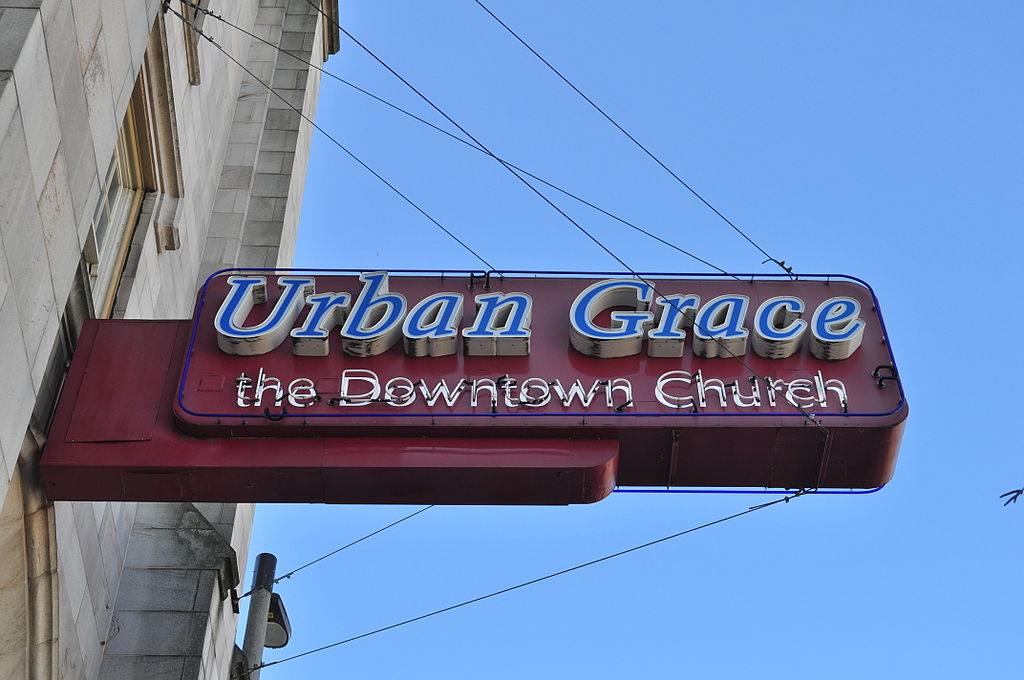
By Caleb Rollins
The faithful who gather at the corner of Ninth and Market Street in downtown Tacoma, Washington, have done their fair share of discernment over the past 125 years. Their latest decision led to the creation of Urban Grace in 2005, an ecumenical congregation with Baptist roots that now functions as a community hub for local nonprofits, dance companies, the farmers market, and more.
The history of this current iteration of Christian community that sits on the ancestral land of the Puyallup tribe begins in March 1883, with the founding of First Baptist Church and the first church building at this corner. In 1925, they decided to remain in the same location and built a new building. In the late 1970s, the people of First Baptist once again faced a decision about the future in their community. With membership declining, the congregation seriously considered a move to the suburbs, where they believed they could grow again.
However, after careful consideration, the members of First Baptist felt the call to remain in place and serve the community of downtown Tacoma. “Remaining downtown was an interesting and beautiful choice,” says Rev. Ben Robinson, pastor of Urban Grace.
Even with this renewed spirit and commitment, participation in congregational life continued to dwindle. By 2000, only twenty people regularly attended worship, and the closure of First Baptist and their forty-thousand-square-foot building became inevitable. In response to this ending, ecumenical leaders of Tacoma joined with the members of the congregation and determined to use the building to help jump-start a new ecumenical congregation. “There was no resistance because we knew we didn’t have much choice if we were going to survive,” says longtime member of First Baptist Willie C. Stewart. “We should have done it years ago.”
The first members of Urban Grace, including some from First Baptist, still faced an uphill battle to remain an asset to the community. They spent some time without a pastor and had to attend to decades of deferred maintenance on their nearly one-hundred-year-old building. In the midst of these hurdles though, Urban Grace built on community relationships that First Baptist had nurtured for years and began to cultivate new ties with their neighbors. “The church didn’t just move into a neighborhood; the neighborhood moved into the church,” says Robinson.
Urban Grace began increasing the number of community groups they hosted in their building. With funding and technical support from the National Fund for Sacred Places, a program of Partners for Sacred Places in collaboration with the National Trust for Historic Preservation, the people of Urban Grace deepened their understanding of the needs of their downtown neighborhood.
Because their church intentionally and clearly began meeting community needs, a regional foundation that typically does not fund churches agreed to fund investments in their decaying building. This foundation became convinced by the community-centric mission of the congregation and the use of their physical assets. “The building is the ministry,” says Robinson. This gift helped leverage more giving from the congregation for their mission and more funding from the National Fund for Sacred Places.
COVID has certainly shifted the practices of Urban Grace and the community members that use their buildings. Yet the groundwork the community laid in developing ties and gathering funding has helped them adapt to this challenge more easily. Today the church and the building are organized separately to allow for more flexibility and efficiency in their operations. The rental revenue that comes into the building does not always cover operating costs, but it has created a revenue stream that otherwise would not have existed.
Perhaps more importantly though, the opening of their building to community groups has allowed Urban Grace to fulfill its mission to serve the community. Their building continues to be a main avenue through which they show love for their neighbors. From the first decision to stay downtown to the welcoming and inclusive hospitality of today, the downtown congregation of Tacoma has shown what it means to love a place.
A 140-year-old congregation in the heart of south Minneapolis decides to close their congregation and donate their property to a nonprofit serving people experiencing homelessness.
A 140-year-old congregation in the heart of south Minneapolis decides to close their congregation and donate their property to a nonprofit serving people experiencing homelessness.
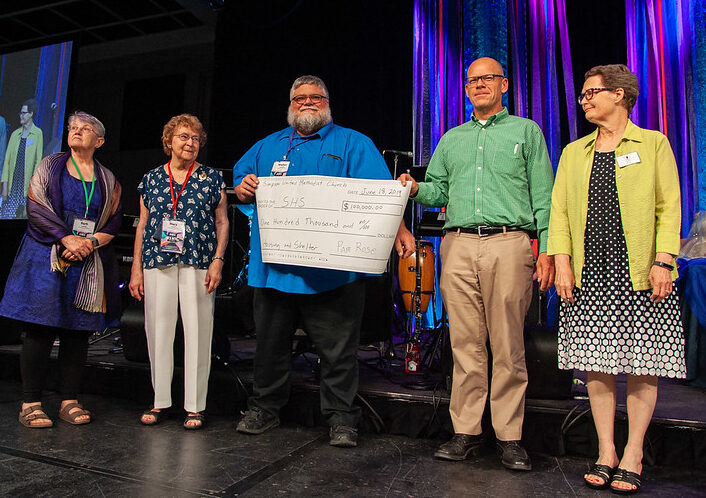
By Caleb Rollins
December 2021
How did a 140-year-old congregation in the heart of south Minneapolis decide to close their congregation and donate their property to a nonprofit that serves people experiencing homelessness? The story begins with conversation over a cup of coffee.
In early 2016, Walter Lockhart IV of Simpson United Methodist Church; Dan Johnson, Twin Cities district superintendent of the United Methodist Church Minnesota Annual Conference; and Steve Horsfield, executive director of Simpson Housing Services, met to dream about possible futures for the old church building.
Like countless urban mainline Protestant congregations, Simpson UMC saw stark decline over the final decades of the twentieth century. This diminishing membership was matched by a deteriorating building. “The building is disintegrating around us. It is deteriorating from its own weight,” says longtime member Mary Gates.
The congregation had attempted to address these challenges head-on and experimented with different ministry models. One model brought them into a relationship with Iglesia Piedra Vida, a Hispanic congregation that used the building as a place for spiritual growth and community engagement. Another model spurred the development of a food pantry for community members, especially those served by Simpson Housing Services.
Yet, despite these creative new partnerships and programs, the congregation continued to decline, and the building’s needs went unaddressed. “The season for having a sanctuary in south Minneapolis that seats five hundred people is over,” says Rev. Lockhart. “It’s time to open the door to new possibilities.” Members knew they needed to close, but they wanted to use their assets to spark something new. To find these new paths, Simpson UMC turned to an old partner.
Simpson Housing Services began as a dream of a former member who felt called to respond to the growing problem of homelessess in Minneapolis in the early 1980s. From an invitation to provide shelter for their unhoused neighbors came the creation of a separate nonprofit, Simpson Housing Services, that now serves more than five hundred individuals and two hundred families through sheltering, advocacy, and other supportive services.
Since Simpson Housing Services was running their shelter out of the Simpson UMC basement, this trusted nonprofit seemed a logical partner for the building’s next chapter. Through congregational and community meetings, the people of Simpson UMC decided to close their congregation and donate their property to Simpson Housing Services, which plans to construct a new building on the site for shelter, permanent supportive housing, and other services.
Rev. Johnson, who aided in the discernment process, described some of the challenges Simpson UMC faced in these periods of transition. “How do you communicate in a way that is honest and transparent and at the same time doesn’t contribute to rumors? Casting vision across a broad population and constituency takes time.”
While the decision to end the congregation and pass on the property to Simpson Housing Services became official in the summer of 2017, the process of constructing the new building is ongoing. Challenges from zoning and other municipal laws have slowed progress, and while Simpson UMC and other local Methodist congregations have donated to the project, Simpson Housing Services has had to patch together a funding package from other private and public sources. They plan to complete the project in 2023, providing the community with permanent supportive housing and a shelter on the same site where the organization began forty years ago.
In their closing chapter, Simpson UMC also continued to support some of their more recent partners. They felt compelled by the mission of Iglesia Piedra Vida and donated a portion of their remaining endowment funds to the congregation. Furthemore, the food pantry they began will live on in the new Simpson Housing Services building.
The process of decline, discernment, and transition took time to unfold, but the people of Simpson UMC continued to put their trust and support in their community partners, new and old. According to Rev. Johnson, they found joy in knowing their ministry would live on. “While they mourned the departure from that site,” notes Johnson, “they also celebrated that it wasn’t just a closure and an end to their name, work, and witness, but it would be reimagined and repurposed in new ways.”
When membership at Saint Stephens Presbyterian Church was low and potential for growth in membership seemed unlikely, the remaining members decided to close rather than use up their resources to remain open a few years longer. They then sold their building and converted their assets into a charitable endowment that would carry on the church's mission.
When membership at Saint Stephens Presbyterian Church was low and potential for growth in membership seemed unlikely, the remaining members decided to close rather than use up their resources to remain open a few years longer. They then sold their building and converted their assets into a charitable endowment that would carry on the church's mission.

By Caleb Rollins
January 2022
Is it possible that the closure of a small church might be better for a community than its continued existence? Dianne Willson, member of Saint Stephens Presbyterian Church in Sacramento, California, thinks so. Like many mainline Protestant congregations, the membership at Saint Stephens had been dwindling for years. The familial connections built over decades continued, but the potential for growth in membership seemed unlikely. “To have a dream and see that it’s not coming into fruition is heartbreaking,” said fellow member Sharon Brundage.
Fortunately, this congregation was in the enviable position of having enough assets to carry on for years, even with its weekly attendance dipping to fifty parishioners. However, instead of aimlessly drawing down these resources, the members of Saint Stephens entered a period of intentional discernment and study about the future of their life together. With the support and guidance of the Presbyterian Foundation’s Project Regeneration, this faith community committed to making a faithful, yet painful decision. When attendance at Saint Stephens Presbyterian Church dropped, the church decided that instead of drawing down resources for a few years longer, they would end their congregational life together, sell their building, and convert their assets into a charitable endowment that would carry on their mission.
This endowment, under management of the Presbyterian Foundation and with direction from former members, is currently supporting local and global nonprofits that Saint Stephens had funded for years. Evelyn Jordan joins other former members in volunteering regularly at North Highlands Food Bank, a local organization that, through support of the endowment, serves thirteen hundred people per month. “The dreams and the hopes are living on from the people that were at Saint Stephens,” said Jordan. Their endowment also responds to emergent needs around the world through Presbyterian Disaster Assistance and funds growing faith communities in the Sacramento area.
The close-knit faith community of Saint Stephens is able to have this long-term impact in their community and around the world because of their foresight. Rather than continuing to spend down their resources and wait to make any significant changes until they were backed into a corner, this faith community entered a period of intentional exploration about other possible alternatives for remaining a faithful presence in their community. Reflecting on this period of discernment, Brundage expressed gratitude.
“We looked back at our history and reminded ourselves of the things we had done and the ways we had been faithful. We knew that closing our doors was a way to continue to be God’s faithful people.”
The decision to close and fund an endowment that supports new and existing ministries may not be the course forward for every congregation struggling to maintain members and revenue streams. However, the community of Saint Stephens and their partners from the Presbyterian Foundation show the importance of careful reflection prior to the last stages of crisis. Looking back on the final days of life together in the institution of Saint Stephens, Willson notes that joy is indeed possible with these changes: “It was definitely more a celebration than a death.” Thoughtful deliberation and creative partnerships can indeed allow for faithful and joyful responses to some of the economic challenges facing mainline Protestant congregations today.
After a pastor receives a large donation to be used for community ministry, church leadership pursues alliances with local leaders to pay off medical debt.
After a pastor receives a large donation to be used for community ministry, church leadership pursues alliances with local leaders to pay off medical debt.

By Bo Prosser
What would you do if you were given a huge check and the only stipulation was that it had to be used to make a real difference in your community? That’s what happened to Pastor Jeff.
Jeff is a fellow in a peer cohort organized through Campbell University’s Center for Church and Community. He pastors ‘First Baptist Church’ in a small community in central North Carolina. His town is home to fewer than three thousand residents; the county population is about twenty-six thousand. Per capita income is $23,000. About 21 percent of families and 25 percent of the population are below the poverty line. Demographic data indicate approximately 61 percent white, 24 percent African American, and 15 percent other.
The Center for Church and Community received funding from Lilly Endowment Inc. for work focused on resourcing rural community pastoral leaders. Each year, twelve to fifteen fellows are selected from applications around the country. The fellows are resourced through social media, peer-to-peer conversations, individual coaching, and a series of retreats. These retreats focus on leadership development, spiritual discernment, and deeper understanding of their churches’ context.
First Baptist Church has a long history of serving its county. The church runs a food pantry, a senior adult ministry, children’s summer ministries, and a community “trunk or treat” around Halloween. The church has about one hundred weekly attenders with an online presence as well. Their ongoing ministry budget is modest, yet among the members are several generous donors.
Jeff came to one of the retreats perplexed. A church member had just delivered a check to the church and a promise for another one. The total gift would amount to around a million dollars. The only stipulation was that the gift be used for community ministry and not on the church building or personnel. Perplexed may be an understatement.
“I prayed we would make a significant impact on the community, but I had no idea what that might be,” says Pastor Jeff.
During the retreat, the cohort used Let’s Talk About Resources, a learning tool developed by Lake Institute on Faith & Giving in collaboration with RootedGood, to examine assets that might exist within the church and community for partnering. Through the tool, Pastor Jeff learned about a church in Texas that was helping to alleviate medical debt in its community. “The Holy Spirit began to speak to me, to lead me, to give me a similar idea for reducing medical debt in my community,” reports Pastor Jeff.
Medical debt is a problem not just in Texas but nation-wide. Over 100 million Americans (41 percent of adults) have medical debt. About half of the country has been saddled with debt because of medical or dental bills in the past five years. About one in five does not expect to pay off the debt.
Pastor Jeff discussed the idea with his peers and the retreat leaders, and he continued to pray. His heart swelled with excitement; his head was swirling. Leaving the retreat, he was eager to begin the conversation with his church, the donor, and the community.
This ministry has not easily materialized. The Texas organization wasn’t interested in working beyond its geographical context. He had a few other conversations, but he was attempting to do something so unexpected in his context that no one could relate to him at first.
He remembered that success would be predicated upon building a network of allies. So he began to look around for people in the church and community who could help him. This loose alliance eventually led him to the director of his local hospital.
At present this dream is still on hold. COVID has disrupted its progress. Pastor Jeff is still interested in making a difference in his county. The church leaders are still trying to meet with the local hospital. They are still trying to build alliances that can make a difference.
“This is not about marketing our church; this is about doing something so great for God that lives will be changed,” he says. “We are a small church, but we want to make a big difference in the love of Christ. I’m not discouraged. I’m confident God will make a way.”
What began as a one-time fundraiser becomes a yearly event for community-building, ministry, kindness, and play.
What began as a one-time fundraiser becomes a yearly event for community-building, ministry, kindness, and play.
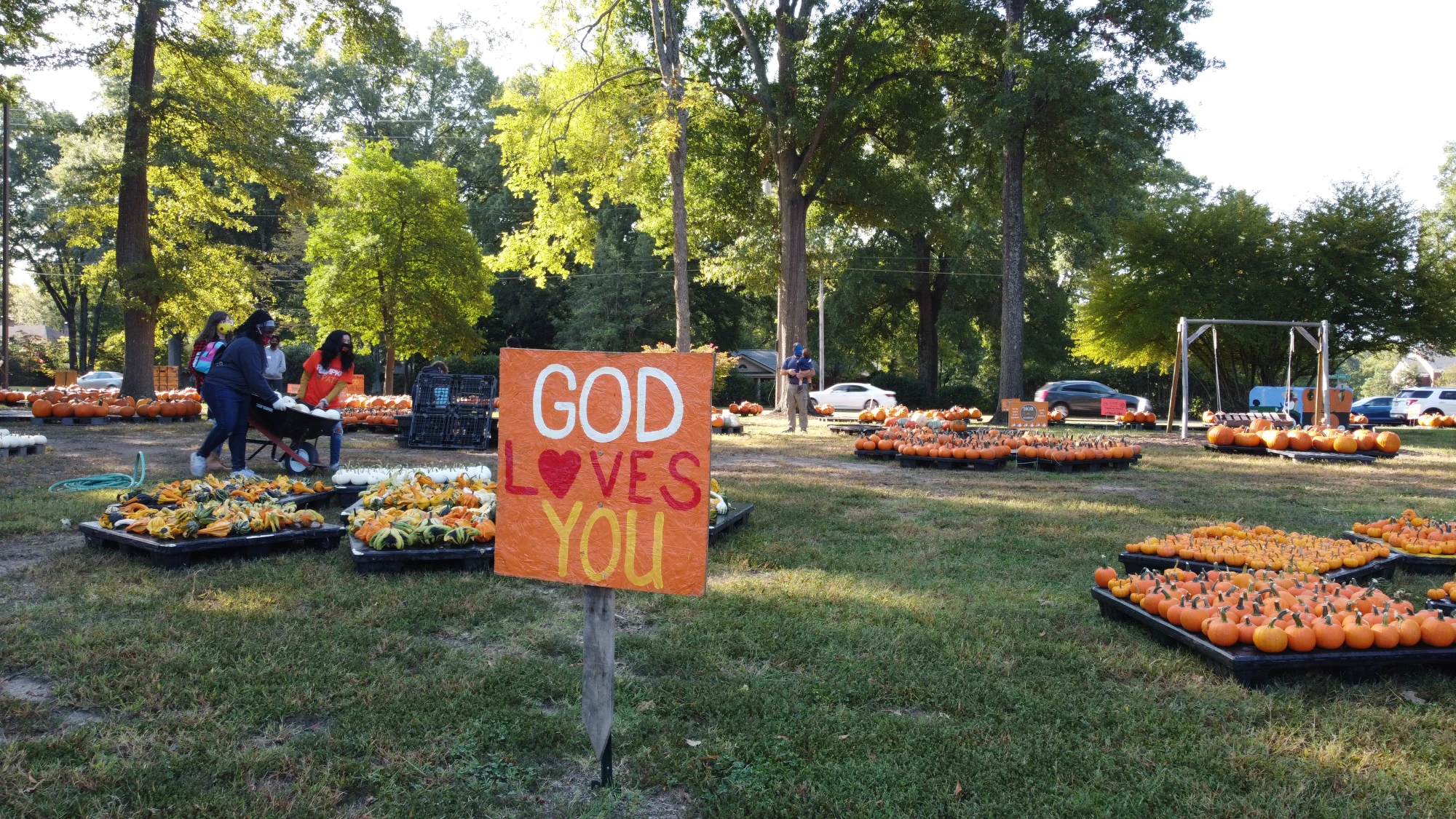
By Bo Prosser
The original plan was for the church to buy a few pumpkins in the fall and sell them to raise money for the youth summer mission trip.
Eighteen years later, this event has turned into a significant ministry for Second Baptist Church of Memphis, Tennessee, and the surrounding community. Today, more than a hundred volunteers of all ages from the church, a nearby high school’s social clubs and athletic teams, a women’s recovery program, and a local bakery are in the mix.
“We are proud that the Second Baptist Pumpkin Patch has become a fall tradition in East Memphis,” says pastor Stephen Cook. “Our front yard is now a place of ministry to our community—a place of hospitality, ministry, kindness, fun, and play. The Pumpkin Patch has become a gathering place for all kinds of people representing all areas of the community coming together under the umbrella of Christian hospitality.”
Things began to shift about ten years ago. On retreat, church leaders began to think about programs that needed to become “more ministry focused and less event/budget driven.”
“Our retreat leader pushed us to reexamine our thoughts about everything, especially the Pumpkin Patch,” says Cook.
One church leader asked, “You mean we should make selling pumpkins a ministry?”
And then transformation was at hand.
The church began to build partnerships, ask customers how they could pray for them, and engage community groups. Exclaims Pastor Cook, “When we thought in terms of ministry and partnership, the momentum began to build. We slowly grew from selling a few hundred pumpkins to selling over forty tons of pumpkins this past fall!”
Second Baptist is not a megachurch. The congregation has about two hundred faithful congregants. The secret to the church’s success was in reimagining the annual fundraiser.
The church quit talking about sales and started focusing on ministry. Mindsets began to shift. Partners began to inquire. Relationships began to form.
Thistle & Bee, a nonprofit organization serving women recovering from prostitution, abuse, and trafficking, helps with the annual event and sells their bee-related products of honey granola and candles. The offices and operations for this group are housed at Second Baptist facilities. The women have an opportunity to work for eighteen months in this social, emotional, and healing enterprise. The church kitchen, once used for preparing Wednesday night suppers for the church members, is now used by survivors of abuse and the sex industry.
Sweet Lala’s Bakery, a local business giving “second chances” to young people, is also a partner in the Patch. This family-owned business places a heavy emphasis on ministry to at-risk young people who deserve a second chance. Many of their staff are adolescents and young adults who are learning to turn their lives around for good.
Proceeds from the Pumpkin Patch support missions and ministries for children and youth. Pumpkin sales have supported student mission trips to Helena, Arkansas, the Rio Grande Valley in Texas, New York City, Atlanta, and South Africa. The sales have also purchased literacy materials, school supplies, and Christmas presents for children. They have also funded local spring break mission projects for Memphis teens, empowering them to use creativity to make their neighborhoods safer and more beautiful. Proceeds from the last two sales have even helped create an outdoor learning space for a local high school that partnered with the church during the pandemic.
Daniel Johnson, associate pastor and project leader for the Pumpkin Patch, shares, “One day I had a chance to look around at everyone attending. I thought it was an awesome depiction of the kingdom of God—everyone coming together in a time when so many need hope. I’m hoping it will continue to be this way.”
“The transformation was slow, hard work, but the Pumpkin Patch has become our congregation’s signature community ministry,” says Pastor Cook.
Some information for this article was provided by the communications department of the Cooperative Baptist Fellowship.
Chesapeake Bay Foundation and Branch's Baptist Church look to nature to solve environmental, health, and economic problems in Richmond
Chesapeake Bay Foundation and Branch's Baptist Church look to nature to solve environmental, health, and economic problems in Richmond
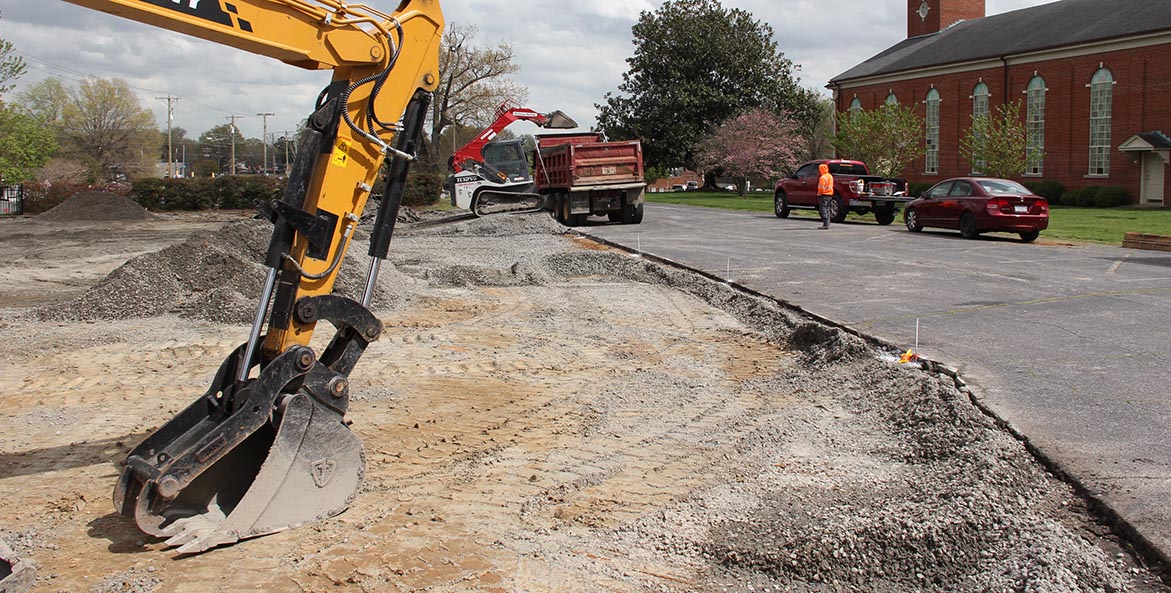
CBF and Branch's Baptist Church look to nature to solve environmental, health, and economic problems in Richmond
Republished from the Chesapeake Bay Foundation blog.
In the south side of Richmond, Branch’s Baptist Church had a problem. With attendance lower than in the past, the expansive parking lots surrounding the church no longer filled up on Sundays. Because those same parking lots create polluted runoff during heavy rains, the church was required to pay about $600 per month in stormwater fees to the City of Richmond.
What’s more, on hot summer days the asphalt surrounding the church absorbed and radiated heat. Research shows that paved-over, treeless stretches of Richmond can be up to 16 degrees hotter in the summer than leafier parts of the city. People living in those areas suffer disproportionately from extreme heat. City-wide, the issue has gained significant attention.
The church found a solution by looking to nature. Working with CBF, church members recently removed nearly 23,000 square feet of asphalt and concrete and are planting the once-paved areas with trees. The church grounds are now greener and more beautiful, and there are still plenty of parking spaces for congregants. Because the project significantly reduces polluted runoff to the James River, the city cut the church’s stormwater fee in half, saving them thousands of dollars a year.
“We might have had different reasons for doing this project, but we had the same goal—to stop some of that stormwater runoff,” said Jerry Smith, facilities chairman for Branch’s Baptist Church. “I wanted us to pay less in stormwater fees, CBF was focused on the benefits to the environment. This was a win for everyone.”
This isn’t the first time Branch’s Baptist Church has teamed up with CBF. In 2018, volunteers from the church and community worked with CBF to plant more than 100 trees on church grounds with help from a Virginia Department of Forestry grant.
This year’s work at the church built on that effort. A National Fish and Wildlife Foundation Small Watershed Grant to CBF is supporting the Greening Southside Richmond Project, which is planting trees to reduce runoff and cool some of Richmond’s hottest neighborhoods. As part of that project, the effort at Branch’s Baptist removed asphalt and concrete from three areas:
- A 14,400 square-foot portion of parking lot that is already replanted with 12 native trees;
- A 3,300 square-foot strip between parking spaces where river birch will shade cars that would otherwise heat up in the sun. During rain, runoff from the church’s roof flows into this strip and across a series of rocky wells and trenches, where the water is absorbed into the earth rather than sending polluted runoff into streams that flow into the James River, and;
- A nearly 5,000 square-foot unused basketball court that will be reforested this fall with native tree species.
The parking lot transformation was an impressive process. Heavy machinery first broke up the concrete and asphalt and hauled it away. The poor, compacted soil beneath the pavement now had to be brought back to life.
A backhoe spread a four-inch layer of compost on the previously paved areas, mixing it with the compacted soil to a depth of 24 inches. Over the former basketball court, a one-inch layer of biochar was mixed in. This charcoal-like substance helps create healthy soil where plants can grow better.
Design work by AMT, an engineering firm, and construction by contractor Exact Stormwater Management, in coordination with the City of Richmond, ensured success. Richmond’s Parks and Recreation Department completed the remediation work on the basketball court.
While the remediation of the basketball court was taking place outside, experts from the Virginia Department of Forestry led a workshop at the site attended by forestry and urban planning professionals, who were all interested in how to cool and beautify cities by planting trees in once-paved-over spaces.
While the transformation of the Branch’s Baptist Church parking lot is a big deal for the church, it’s still a drop in the bucket amidst the miles of concrete and asphalt in Richmond’s southside.
But the newly planted trees are an inspiration for what’s possible. By reclaiming unused paved areas and planting them with life-giving trees, the church is serving as an important model for how to create a cooler, greener, and healthier place for people living in south Richmond while also restoring the James River.
A story about a Cooperative Baptist Fellowship congregation that is home to no less than five Birmingham-area nonprofit organizations and aside from the congregation’s weekly worship service, four other churches gather there on Sundays.
A story about a Cooperative Baptist Fellowship congregation that is home to no less than five Birmingham-area nonprofit organizations and aside from the congregation’s weekly worship service, four other churches gather there on Sundays.
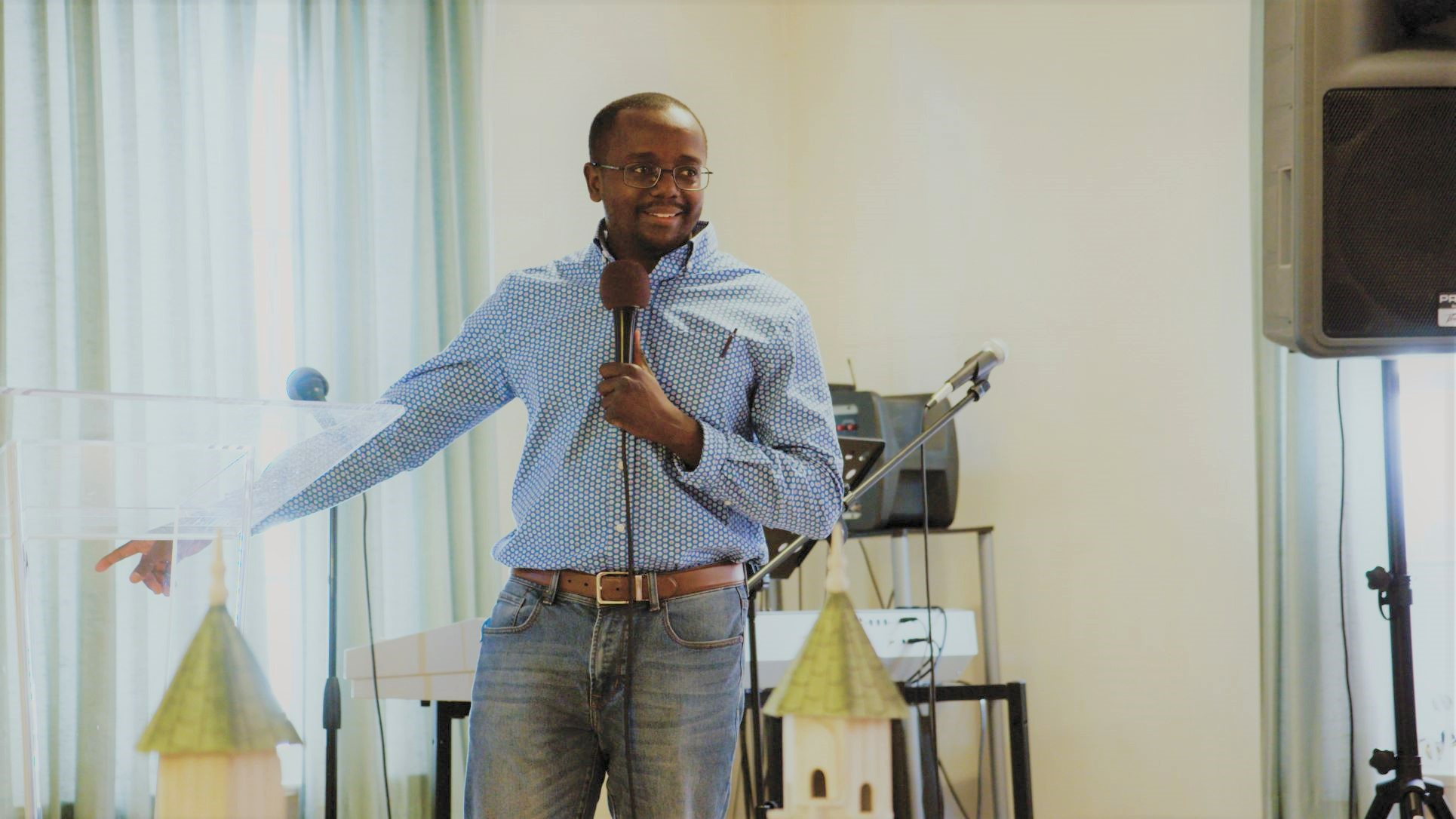
Excerpt from Sacred Spaces, Innovative Places with permission from the Cooperative Baptist Fellowship.
Southside Baptist Church has been a presence in downtown Birmingham, Alabama for well over 100 years. In the 1950s, hundreds of children and adults would meet in assembly rooms to sing and pray together before dividing into small Sunday school classes in a sprawling church building big enough to accommodate the masses. When the demographics of downtown Birmingham changed in the ‘70s, some churches relocated to the suburbs, but Southside remained committed to its neighborhood.
Membership has dwindled at Southside over the years, but the church still has a sprawling campus that has gradually become home to many other groups who serve the neighborhood alongside the congregation.
Southside dedicated space to a Korean Baptist church around 1982, and the church still meets there today. In the early 1990s, Southside provided temporary office space to Southside Ministries, a cooperative ministry, while they renovated their own building. Word-of-mouth led other organizations to Southside, and soon they were housing YMCA summer camps and other area organizations. Hosting organizations has become more of a necessity over the last couple of decades as the cost of utilities and maintenance has increased but the church’s membership, and therefore income, has not.
The church formalized its space partnership process years ago by establishing a committee that vets nonprofits who wish to use the facilities. These organizations must have nonprofit status or be in the process of securing it, have insurance, a constitution and by-laws and a mission statement. The Southside Building Use Committee does not insist that everything line up perfectly with Southside’s beliefs. But, each organization using space must exhibit some reflection of Southside’s mission. Southside Baptist is committed to the wellness of the whole person, so nonprofits must align with that commitment in some way, which is rarely an issue. Over recent years the church has hosted community nonprofits, a school for critically at-risk youth and adults, feeding ministries, and other organizations providing direct services.
Today, Southside Baptist is home to no less than five Birmingham-area nonprofit organizations and aside from the congregation’s weekly worship service, four other churches gather there on Sundays. “Years ago, these could have been ministries of the church,” Dr. Kelley, Southside’s pastor, said. Today, however, with declining membership, they’ve decided to open their doors to other organizations and churches in the spirit of cooperation rather than having to “own” the ministries themselves.
GREEN-LIGHTING GENEROUS SPACE SHARING
Like Southside, many churches have ample space that sits empty five or six days of the week. Consider the layout of your church and which rooms might be completely vacant or rarely used. If these rooms can be converted to office space, the next step is to think about which nonprofits or organizations might need affordable space. Which nonprofits would be a natural fit for your congregation? Family Promise discovered Southside because one of the board members was also a member of the church. If members of your congregation serve on boards or volunteer regularly with area nonprofits, these might be good places to explore first because they’re pre-vetted and already share a connection with the church. You might also make a list of nonprofits the church partners with who would benefit from more affordable or adequate space.
The biggest reason for Southside Baptist Church to extend hospitality to so many is that they simply wanted to maximize the space so that it doesn’t sit empty and dormant, which they believe is poor stewardship of the expansive facility resources they have. Dr. Kelley quotes a speaker he once heard when he says, “Churches are often closed when people most need them,” and Southside wants to be open for social ministries that will provide a tangible difference in the Birmingham community.
While vehicles may be confused by the tricky intersection outside of Southside Baptist Church, the intersection inside is clear: church and community are finding mutually beneficial ways to serve together.
A story about a Cooperative Baptist Fellowship congregation using a preschool model that is not only self-sustaining but also provides some financial benefit to the church.
A story about a Cooperative Baptist Fellowship congregation using a preschool model that is not only self-sustaining but also provides some financial benefit to the church.
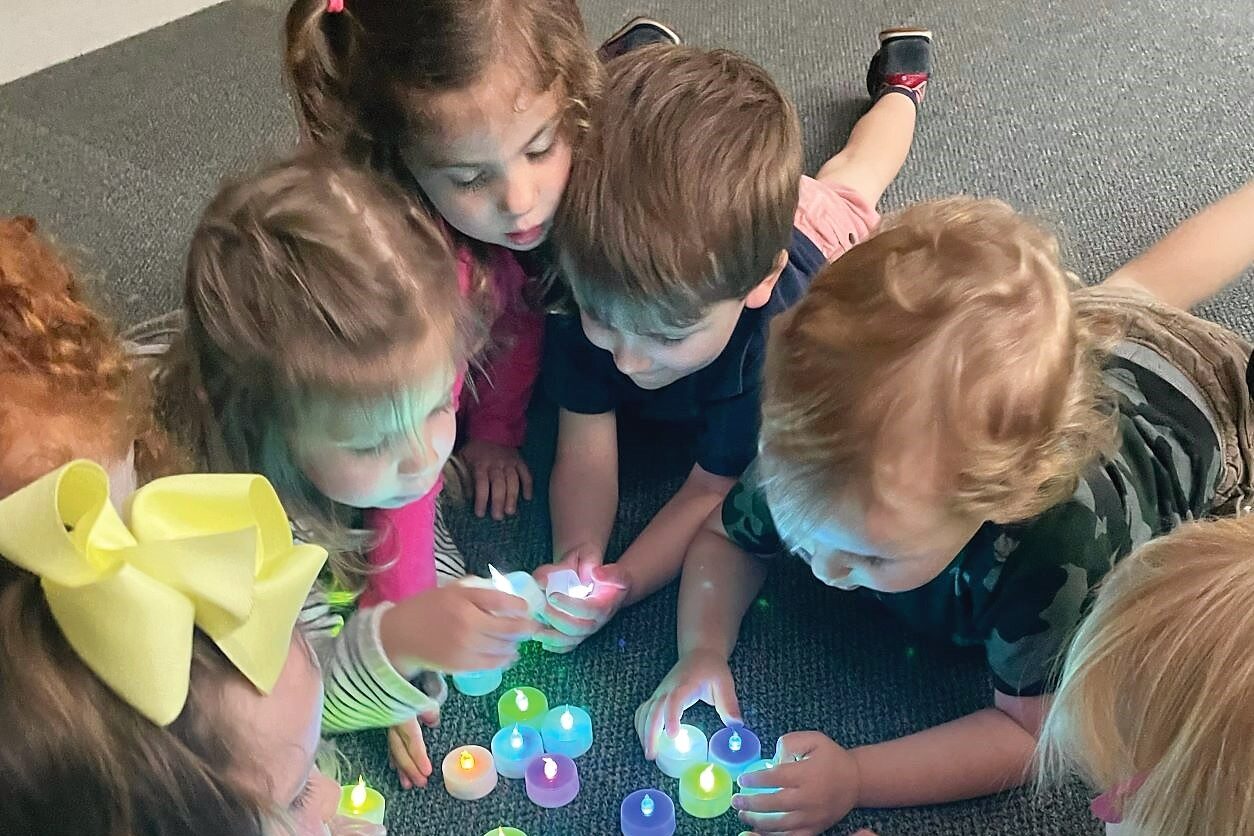
Excerpt from Sacred Spaces, Innovative Places with permission from the Cooperative Baptist Fellowship.
“River Road Church, Baptist” occupies a serene hilltop minutes away from the University of Richmond. Inside the church’s preschool, however, serenity gives way to classrooms brimming with activity.
The River Road Preschool Development Center currently serves about 180 students and operates a standard half-day program that can be extended for convenience and tailored to each family’s needs. The Center’s director, Danielle Simone, brought needed changes to the preschool and led efforts to “blur the lines” between preschool and church.
Church preschools are perhaps one of the most common ways to make use of spaces that otherwise sit empty for most of the week. Many churches have preschools that are in high demand because of their location and/or reputation in the community, but preschools often present their own set of challenges such as extra maintenance costs. Preschools can also pose a financial challenge as enrollment fluctuates from one year to the next. Many preschools see a balance sheet that is break-even at best, so the church must be willing to absorb costs associated with an operating loss and invest in the upkeep of the preschool area. The preschool model at River Road is not only self-sustaining but also provides some financial benefit to the church, which makes it extremely rare.
ENGAGING ENRICHMENTS PROVIDE AN ATTRACTIVE MODEL
The River Road Preschool Development Center operates its primary schedule from 9a.m. until noon. But, Danielle says that periodically surveying parents has tremendously helped in providing additional services to meet needs of those families enrolled in the school.
Flexibility is the key, she says, in appealing to the schedules of those who attend the school. Early care begins at 7:30 a.m. and extended care is offered until 4 p.m., as well as “lunch bunch” and afternoon enrichments that change every 6-8 weeks.
Enrichments are seasonal and often feature outside vendors who come to the preschool to provide classes and recreational opportunities for the children. These include academic offerings as well as classes such as dance, soccer and martial arts. The add-ons to the half-day program make the preschool a one-stop shop in terms of managing the child’s day.
The preschool also offers six weeks of camps throughout the summer which include extended care offerings, except for the week of Vacation Bible School at the church. Children from the school are encouraged to attend Vacation Bible School so as not to compete with the church’s ministry. The students and families also contribute to the ministry of the church with two fundraisers each year that benefit the Fellowship Fund, which offers monetary assistance to families and individuals.
Because of the profit the preschool makes from this model, they are able to give back to the church as a way of offsetting the cost of operating rent-free. In a previous era, the preschool gave a set portion to the church, but under Danielle’s leadership, the contribution from the preschool has been more generous. The funds contributed by the preschool bless the congregation by assisting with ministry programs as well as offsetting the cost of utilities and custodial staff.
CONSIDERATIONS FOR A MORE ADAPTIVE CHURCH SCHOOL MODEL
The River Road Preschool Development Center didn’t employ an effective model of offering extended care and enrichments overnight. It has taken strategic communication and a delicate balancing act when it comes to logistics and staffing.
When asked for her best piece of advice when it comes to a more a la carte model of preschool operations, Danielle said, “Start small, and do it well.” She added, “Evaluation is key, and knowing the cost of every seat in the school is very important in determining tuition and related fees.”
When it comes to the relationship with the church, both Daniel and Danielle agree that, like all relationships, it takes intentionality and communication. But it’s worth the effort if the church and school become more collaborative and less insular. When churches and their schools can share events, spaces, and their mission, stewarding their resources looks less like a business and more like the Body of Christ.
A story about a Cooperative Baptist Fellowship congregation who received a gift of land in Eastern North Carolina and discovering that it would be suitable for solar farms.
A story about a Cooperative Baptist Fellowship congregation who received a gift of land in Eastern North Carolina and discovering that it would be suitable for solar farms.

Excerpt from Sacred Spaces, Innovative Places with permission from the Cooperative Baptist Fellowship.
What might your church do with a gift of over 200 acres of farmland? This was the dilemma for the membership of First Baptist Church of Mt. Olive, North Carolina. In 2003, the church was the recipient of a significant gift from the estate of a church member. The gift included over 200 acres of land. Part of this acreage was quickly sold. A sizable portion was seen as valuable for farming and this acreage was leased at a competitive rate for agricultural use.
In 2013, Birdseye Renewable Energy was looking for tracts of land in Eastern North Carolina that would be suitable for solar farms. The company reached out to the church. Two parcels met the needs for successful solar farming.
Church leadership was intrigued. The FBC Mt. Olive Trustees, who represented the church in the process, committed themselves to learning everything that they could about solar farming.
Within a year, Birdseye and the church moved from that initial phone call to reaching an agreement to lease the appropriate two parcels. The properties are leased through 2044 and return 400% more in income per year than would have been the case had they remained leased for traditional farming.
One result of the agreement has been the way that the experience has expanded the horizons for the church. Today, when Pastor Dennis Atwood talks about the farms, the church and the church’s engagement with the community, he does so in ways that clearly conveys the importance of living with a posture of possibility and an attitude of openness. The solar farm experience has helped both Atwood and other church leaders to appreciate and embrace the idea of how limitless possibilities really are in so many situations.
Another clear benefit of the solar farms is that they have helped the church to think more clearly and personally about what it means to care for the environment. Solar energy is clean energy. It is a way to be a good steward of the earth. As the church has learned about all of this, they have thought more deeply about other ways to care for God’s creation and about how they themselves can play a key role in this work. FBC Mt. Olive’s perspective on creation care and its role in the life of the church and in the development of a strong Christian theology likely would not be where it is today without their direct experience with solar farming.
The major benefit for the church has been the financial blessing because of the solar farming venture. It has certainly eased the financial challenges of the church. And the entire Mt. Olive community has also benefited. First Baptist is currently working on a new ministry initiative called The Gratitude Project through which the church plans to provide $100,000 to identified community partners who are working to alleviate poverty, improve affordable housing, provide educational needs for children and youth or to support economic development among the poor in Mt. Olive. This gift is a direct result of the earnings being generated by the two solar farms.
When one first hears the story of First Baptist Mount Olive and their two solar farms, the initial reaction might be to conclude that this is a remarkable story but not one that can be reproduced. Yet, church leaders are quick to point out is that other churches should explore this opportunity.
Rev. Atwood points out that often, rural churches have members with lots of land. In turn, a strategic conversation might involve asking members to at least consider leaving a small portion of their land to the church in their will or to gift a small portion of their land to the church while they are alive.
There are many creative ways that congregations can use property as a means of generating revenue. The example of Mt. Olive First Baptist Church opens a world of possibilities for churches to explore.
A story about two Cooperative Baptist Fellowship congregations who offer examples of rethinking the profit there is in pavement.
A story about two Cooperative Baptist Fellowship congregations who offer examples of rethinking the profit there is in pavement.

Excerpt from Sacred Spaces, Innovative Places with permission from the Cooperative Baptist Fellowship.
Whether your town is host to college game day or just the local fall festival, creatively using the parking lot on your church property can potentially generate funds. Two Cooperative Baptist Fellowship churches are notable examples of rethinking the profit in pavement.
Auburn First Baptist Church is just steps away from the Auburn University campus. For university home football games, it rents the spaces in its parking lots. The funds raised from parking don’t go toward the operating budget. As seen with Covid and the empty football stands, those funds are not guaranteed. Instead, the church allocates a set amount for vehicle maintenance and splits the remaining earnings between an account for youth camps and retreats and the youths’ missions giving fund.
Youth and their parents work the football games parking vehicles to earn funding toward the trips they take with the church. By working just two games, most students can pay for the trips they’ll be taking throughout the year. The youth group also collectively decides to donate a portion of their funds to meet needs outside of their community.
First Baptist Church of Raleigh, North Carolina is in year three of operating a food truck called “And Also With ‘Cue” out of its parking lot. The church used to rent its parking spots to those who work downtown.
A few years ago, FBC Raleigh had funds for a small missions grant. Their then-new Minister with Community steered an idea to include a local barbecue pit master. David With, minister and church member, was interested in beginning a food truck from which to sell his barbecue and the pastor had give-back concept in mind. This allows a person to purchase a meal from the food truck and by doing so, provide a meal for a hungry neighbor in the community. The downtown location was prime to draw business from the many state employees who work in the area.
Both congregations were able to see potential in a part of the church many do not often consider when thinking about assets. They both saw ways that the space outside their walls could draw those who might not otherwise ever step foot on the church’s grounds.
Auburn FBC’s Associate Pastor says that by pricing their spots at a competitive rate they can provide a needed service and involve the youth in learning firsthand about stewardship. Their youth can both contribute to the decision-making about how funds are spent and offer a greater amount together than they would be able to offer individually.
At FBC Raleigh, “And Also with ‘Cue” gives its patrons an opportunity to participate alongside the church in community engagement efforts. During the pandemic, giveback meals were provided to first responders and a women’s shelter. Now that the church’s clothing ministry has returned to operation, clients are offered a meal once per month. Reed says that even though there are other options to eat downtown, none of them give patrons the satisfaction of knowing that they are providing a meal for someone else with their purchase.
Both endeavors have had their fair share of challenges. One of the biggest challenges Auburn FBC has faced has been the absence of parking demands during the Covid-19 pandemic. Likewise, at FBC Raleigh, the launch of “And Also with ‘Cue” was delayed by city licensing and food truck approval processes.
Nonetheless, both congregations have worked to overcome challenges and continue the stewardship of any profits in ways that make a substantial difference to those who receive meals and funding as a result of making good use of a seemingly unimportant slab of pavement.
What can be gleaned from these two congregations is how the revenue is stewarded. The proceeds from sales of meals and parking spaces are not being used to pay for building maintenance or staff salaries but to further the church’s mission and are support the local community or broader causes. Every church can look at the potential in its pavement and think creatively about how to steward the revenue to live into its mission.
A story about how one Cooperative Baptist Fellowship congregation sold their land to reduce debt.
A story about how one Cooperative Baptist Fellowship congregation sold their land to reduce debt.

Excerpt from Sacred Spaces, Innovative Places with permission from the Cooperative Baptist Fellowship.
About a decade ago, First Baptist Augusta chose to purchase land that bordered its property. Two residential homes had come up for sale and FBC had first right of refusal on both lots.
Fast forward ten years and FBC has moved in a different direction regarding the two lots. In the summer of 2022, the church hopes to finalize sale of the property to a developer. Within a couple of years, the plan is for a new active adult retirement community to stand on the site – benefitting both the community and the church.
Today, most churches are beginning to think about reducing rather than increasing their footprint.
In 2020, a leadership group in the congregation was actively discussing how to reduce their $4 million debt. At the time, a church member was working professionally with a developer hoping to purchase property to build an active-adult retirement community. The church member presented this idea to both the church and the business group. Though the opportunity was unexpected, church leadership was able to recognize the possibility in front of them and quickly pivot.
Planning & Patience
The agreement has been finalized and the church has pivoted, once again, by evaluating their staff, facilities, and volunteers that will be needed to minister to their new neighbors. The leaders of FBC Augusta want to be good neighbors, and they want their church to be an attractive, meaningful place. The leaders are focusing on physical and spiritual access for their new neighbors.
Another attitude that has shaped the congregation in the process is patience. FBC’s leaders have been clear that this decision is not about just selling property – it’s about selling property to the right kind of developer for the right reasons. The retirement community option included not only revenue possibilities but also opportunities for ministry and even a potentially exciting living option for existing church members. Had the developer wanted to build something that the church did not feel good about, they would patiently awaited a better option.
Challenges
The decision to sell their property has not been without obstacles.
First, the church has worked hard to be a good neighbor. The developer offered focus groups for the community about the project. Solutions were offered about concerns about traffic and increased population.
Second, church leaders had to respond to a few members who felt that selling the property wasn’t a wise decision. Again, churches have often been in the property acquisition business not vice versa. So, this was a new way of doing things.
Third, FBC Augusta leaders have also had to know when to decline parts of the offer. For instance, they would have generated significantly more revenue by agreeing to sell a portion of their parking lot in the deal. However, church leaders ultimately decided this wasn’t in their best interest.
IMPORTANT CONSIDERATIONS
FBC Augusta’s story offers lessons in planning, patience, and strong communication with one’s community. Church leaders also emphasize the importance of church trustees in the process.
For their part, the church has made sure over the years that they asked people with backgrounds in banking, law, accounting and real estate to serve as trustees. The trustees’ main focus is to represent the church in property, legal and financial matters. Thus, when the opportunity with the land sale arose, the church had the right people in place to lead the congregation through the process.
The senior minister also played a key role. While the trustees handled the organizational side of the deal, the pastor focused on the relational side with church members, neighbors, and the larger community. This relational element is every bit as critical as the business side.
At FBC Augusta, the first conversations about selling the property took place in early 2020 with groundbreaking not happening until the summer of 2022. To make such a decision, churches must be patient and comfortable with the journey. They must also realize that you can never anticipate everything that will happen. They must also recognize that there will invariably be missteps and unexpected results. Yet, as in many matters of faith, the hope is that the risks and challenges are far outweighed by the end result.
A story about how one Cooperative Baptist Fellowship congregation imagined using their space in a new way.
A story about how one Cooperative Baptist Fellowship congregation imagined using their space in a new way.
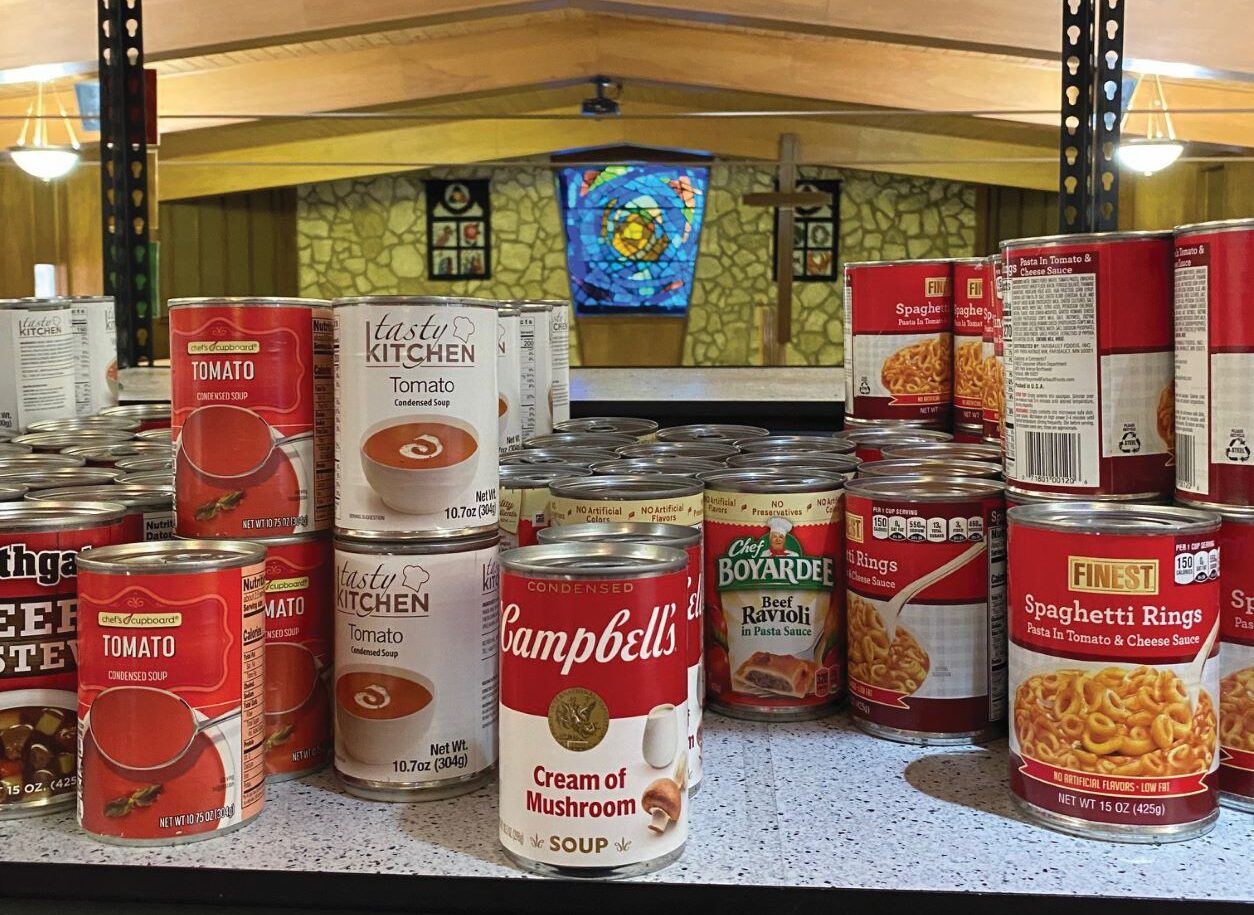
Excerpt from Sacred Spaces, Innovative Places with permission from the Cooperative Baptist Fellowship.
After years of declining attendance, Englewood Baptist Church recognized that it may not be able to continue as a distinct church.
Englewood’s pastor Mark Buhlig began to actively explore the work of area nonprofits. He was interested in ministering to home-insecure people and also thought the church property might be able to house a nonprofit, thereby taking some of the facility burden off the church.
Mark connected with a nonprofit serendipitously named A Turning Point (ATP). ATP offered a clothing closet, food pantry and a certificate program for adults who did not graduate high school.
While ATP was thriving, it was limited by the property it currently occupied. Englewood had an abundance of property and facilities but few funds and people. It was a perfect match!
Pastor Buhlig approached ATP to gauge interest in forming a new partnership. Englewood’s desire to address community homelessness and ATP’s interest in the same need provided an initial project for collaboration. Collaborating on the homeless ministry provided the two entities a chance to get to know each other and build trust. Their combined work was a success.
This slow and intentional shared work paved the way for a deeper look at life together. After much conversation and reflection, ATP moved to Englewood’s property and became the primary occupant. The church gifted ATP majority use of the property. The nonprofit doesn’t pay rent but is responsible for utility bills and any necessary maintenance and renovations. Englewood still has its name on the deed and retains access to the space it needs to be church.
ATP and Englewood offer a fascinating example of partnering in shared spaces. ATP has the property it needs without the price tag of purchasing a piece of real estate. Englewood found new life through no longer having to worry about utilities and building expenses. It is a win-win for both groups.
Benefits & Challenges
The unique relationship between ATP and Englewood has been transformative for both communities in expected and unexpected ways.
For ATP, relocation encouraged their board to dream and refocus as considering relocation required a lot of conversation, prayer, and thought. Once on site, ATP also benefited from friendships with church congregants.
The relationship has also been transformational for Englewood. Finances were freed up for ministry and faith was deepened. The church has expanded its community outreach and the church house has been brought back to life.
It is not quite accurate, however, to say this transition has been all smooth sailing. These types of major changes take time and in this case the transition was a three-year process that is still evolving. To bring such an idea to fruition takes dedication, resilience, and patience. Community leaders in the neighborhood struggled to understand the transition and new function of the property which led to several meetings with government leaders and other community.
Lessons Learned
Englewood and ATP leadership offer three suggestions to those interested in a similar path.
First, have clear guidelines provided in writing that both groups agree to follow. Everyone must be on the same page and clearly know what is expected of the other. Otherwise, misunderstandings are inevitable.
Second, make sure the merging groups are ready to be a part of each other’s lives. Englewood and ATP intentionally interact with each other. A church member is on the ATP board. ATP leadership visit and lead worship at Englewood periodically.
Third, the church must willing to giving up control of how the space is re-allocated. For instance, ATP determined that the best location for its food pantry was the sanctuary, which would simultaneously continue to serve as Englewood’s worship space. In the end, the congregation supported the idea and now celebrate that the sanctuary is a place where people come daily for all sorts of nourishment.
In the end, this story paints a vivid picture of what is possible for a declining yet vital congregation. Churches like Englewood and this partnership model exemplify that there are creative ways to breathe new life into both a community of faith and its facilities.
A story about what happened when a church learned to see its money in a new way.
A story about what happened when a church learned to see its money in a new way.

Excerpt from What Happened When A Church Learned To See Its Money In A New Way by Kevin Jones for Faith+Finance.
An interdenominational bible study and justice action group called Economics of Compassion saw the gentrification in the Over the Rhine neighborhood in Cincinnati through a lens of Biblical justice linked to economic analysis.
EOC taught its faith community to stop blaming the poor for their circumstances or see the homeless as broken people. “We learned to help people find their gifts and led them to invest in them,” Peter Block said. “We dropped the concept of charity, giving from those who have to the people we label needy. That sustains poverty and bad power relationships. Charity is not an economics of compassion. We looked for the assets of our neighbors.”
A $30,000 grant from the local Episcopal Cathedral had let the leader of a local African American-led accelerator called Mortar, operating in Over the Rhine, play the “connect-the-dots” role for six months as a system entrepreneur among the white churches, the city, local investors, the community foundation and CDFI’s and economic development agencies. Those new relationships enabled by that visionary grant from a church resulted within three years in more than $3.5 million in philanthropic, private sector and public investment in Mortar to help black led businesses create assets operating out of their pop up store front in Over the Rhine. Mortar has since been recognized as an award and grant winning national model and its leader has testified in Congress on the role of entrepreneurship in asset creation among marginalized communities.
Many church members were trained by Mortar in culturally appropriate technical assistance, and white professionals learned to both talk and listen to first-time non-college educated African American entrepreneurs and become long-term, valued mentors, spawning scores of new relationships with value for both.
The EOC conversations and teaching from Walter Brueggemann “caused the Cathedral community to repent of certain past ways of behaving and thinking; they realized that gentrification is not all good, that not all investment benefits everyone equally,” said the dean of Christ Church Episcopal Cathedral Gail Greenwell.
“There was a significant shift in our outreach projects. We went from ameliorating the symptoms of poverty to addressing system change.”
A core group of Cathedral community activists formed and they, with the Cathedral’s backing, raised a minority loan fund with partners. Now, along with public sector partners, the Cathedral plans to invest $10 million from its large endowment in a $50 million low-income housing fund, to counterbalance the gentrification. The wealthy church even learned to see its endowment in a new way. “We had always thought about preserving the (Proctor Fund) endowment. Now we’ve come to see with great treasure comes great responsibility, not in a noblesse oblige way, but identifying with our neighbors,” Greenwell said.
Two Lutheran churches in Baltimore partnered to provide no interest loans up to $2,000 to community members.
Two Lutheran churches in Baltimore partnered to provide no interest loans up to $2,000 to community members.

Excerpt from Criterion Institute’s 1K Churches: Extending Healing in East Baltimore.
Se pueden leer la traducción en español aquí (Read this story in Spanish)
Pastor Gary Dittman: When I was called to Amazing Grace 8 years ago, I had no idea how this small urban congregation would be used by God to do such big things! The congregation is community-based and boldly follows where Jesus leads. We are eager to extend God’s life-changing power into a neighborhood deeply impacted by the wounds of racism.
So here’s the tricky thing, when you’re working on healing in a distressed, underserved, disinvested-in community (and I know that’s a mouthful): the wounds are deep. The wounds, in fact, are gaping. When Amazing Grace Lutheran Church partnered with First English Lutheran Church in Baltimore, we were sure of only one thing: we wanted to extend the healing work already happening in our community.
McElderry Park in East Baltimore is a neighborhood deeply impacted by violence, poverty, addiction and trauma. The need for healing is immense. Historical redlining and disinvestment by the city has led to dramatic disparities in health, employment opportunities, and access to capital for entrepreneurial engagements.
Amazing Grace is a relationship-centered hub where activities and programs are community requested and directed. The people are resourceful, smart, and innovative. They live in the neighborhood. And one of the things we were hearing is that it would be beneficial to have access to money to solve problems and launch entrepreneurial endeavors.
So we set up a partnership with First English church to provide no-interest loans up to $2000 to community members and allow neighbors to pay back the loans within 18 months. A leadership team in the AG congregation called Shepherds participates in interviewing candidates, hearing about the plan for repayment and the amount that will work with the family budget. While First English funded the loans to begin with, Amazing Grace has also funded a few.
Here’s a few of the loans we’ve given:
- A grandmother newly raising her three grandchildren used a loan to get a vendor license to sell food plates from her grill in front of her house to support her grandchildren.
- A young man who was a licensed electrician had recently been released from prison. He used a loan to buy tools so he could secure employment.
- A family repaired their car with borrowed funds to allow them to get to work reliably.
- A painter from the community used a loan to purchase paint and equipment to begin his own painting service.
The program has indeed extended the healing ministry. Neighbors are honored and treated with dignity, respect, and trust. Families have an opportunity to support themselves.
Leaders of a church in Pennsylvania launched a Year of Contagious Generosity, and what happened next surprised a lot of people. Money raised benefited the local fire department, school district, and helped rebuild a community playground.
Leaders of a church in Pennsylvania launched a Year of Contagious Generosity, and what happened next surprised a lot of people. Money raised benefited the local fire department, school district, and helped rebuild a community playground.
By Jim Miller
Excerpt from an article originally published in Giving Magazine Vol. 22, No. 4 in 2019. You can access the full issue here.
What happens when churches ask their members to give even more? Is there a resounding thud as the idea falls flat, or do people open their hearts and wallets? Leaders of a church in Pennsylvania launched a Year of Contagious Generosity and what happened next surprised a lot of people. Money raised benefited the local fire department, school district, and helped rebuild a community playground.
Planning for the Year of Contagious Generosity started in the spring of 2014, when Mount Joy Mennonite Church paid off its mortgage. “We wanted some way to mark that,” noted Pastor Karl Landis. “We talked about continuing to raise building fund-type money—a capital campaign—but give the money away to organizations in the community that could benefit from it.”
First, “We adopted a three-part challenge for our congregation, from mid-November 2014 to mid-November 2015.” The challenge included contributing money (known as the Giving Project), volunteering time for community organizations (the Compassion Project), and figuring out ways to help in members’ own neighborhoods (Adventures in Generosity).
For Adventures in Generosity, “We encouraged people as families, as small groups, to listen to the Holy Spirit in their neighborhoods. To say, ‘This is an opportunity for me to be generous—let me step into that,’” said Karl. “We would measure the impact by storytelling, not money…. We invited people to write on cards what other members of the congregation had done, and we got a huge response.” The goal for the Giving Project was $100,000, or “the approximate amount of annual giving to the building project in the latter stages,” Karl said.
Karl talked with members of a local pastor’s association. “I said it would be great if we could give money away and say it was from the churches of Mount Joy, rather than just our congregation.” Other congregations contributed to the effort: Brethren in Christ, Roman Catholic, Lutheran, and United Methodist.
Cross Roads Church (Brethren in Christ) got involved after paying off a debt of its own. Doug Bender, Cross Roads lead pastor, invited Karl and Marshall Meador, the lay champions for the Year of Contagious Generosity at Mount Joy Mennonite, to present information to the Cross Roads board. In spite of the short time frame, the board surprised Doug—and Karl and Marshall of Mount Joy Mennonite—by setting a lofty fundraising goal.
“I had no clue how we could ever pull that off,” said Doug. He said the idea of raising money to give away in the community was new to his congregation. In the past, any year-end surplus likely would have gone to mission work or debt reduction. Cross Roads ended up raising about $55,000. The total was slightly short of the goal, but “still way beyond my expectations,” Bender noted.
When all was said and done, the Giving Project generated well over $100,000. “From all of the participating congregations, the total we gave away was $185,075,” Karl said.
Some of that went to help rebuild the Kids Joy Land playground that was destroyed by an arson fire in 2012. Volunteers from the community, including a number from Mount Joy Mennonite, built new play structures. “We challenged people to give away time as well as money,” said Karl. “We wanted to put our labor where our money is.”
As for the fire department and school system, “We went to them and asked if they had any items on their wish lists of around $20,000 to $50,000,” said Karl. “We were guessing at how much we might be able to raise.” School officials used the funds to help with a stadium project and the fire department was able to complete a much-needed building renovation. Mount Joy Mennonite Church also helped pay down the mortgage of a sister congregation composed mostly of immigrants.
Ultimately, the Mount Joy generosity campaign should be measured by more than how many dollars went where. New relationships have been formed and nurtured—and that can lead to empathy and mutual understanding that strengthen a community. Doug is grateful for the experience, which he believes expanded his congregation’s horizons.
Giving Magazine was a premier stewardship resource published by the Ecumenical Stewardship Center (ESC) from 1999 until 2020. The magazine served Christian faith communities throughout North America, providing thoughtful, practical, and inspirational content on faith and giving from thought leaders and practitioners alike. Giving was published annually from 1999 until 2018 (volumes 1-20), and then quarterly in 2019 and 2020 (volumes 21-28) in digital form only. In 2021 ESC closed its doors and committed its archives to the care of Lake Institute on Faith & Giving. For further information on ESC or its archives, please contact us at lfi@iupui.edu.
Austin church turns a $100,000 gift into $10 million in medical debt relief.
Austin church turns a $100,000 gift into $10 million in medical debt relief.

Excerpt from Austin church turning $100,000 gift into $10 million in medical debt relief by Brandon Mulder for Austin-American Statesman.
In six to eight weeks’ time, hundreds of people among the Austin area’s neediest will receive a surprise letter in the mail that may fundamentally improve their lives. On Sunday morning, Pastor Thomas Daniel announced to his congregation that the Covenant Presbyterian Church will relieve $10 million of delinquent medical debt that has burdened some of the community’s most vulnerable populations, many of whom are uninsured or underinsured.
The congregation, tuning in over a live video stream, had a collective reaction of equal parts excitement and pride.
“The number of people we’re imagining is going to be hundreds, into the thousands, whose lives are going to be directly changed by this,” Daniel said. “There’s nothing required of them. We’re not asking anything of them. It’s just a gift to say, you matter.”
Earlier this month, the West Austin church cut a $100,000 check to RIP Medical Debt, a nonprofit that buys and relieves delinquent medical debt that has gone into collection. Because medical debt is often sold to collection companies or debt- buying companies for pennies on the dollar, RIP Medical uses donations to purchase defaulted debt and forgives it on behalf of the nation’s impoverished.
According to the church, a $1 purchase can relieve $100 of debt. Covenant’s $100,000 donation, which comes from a surplus in the church’s 2019 annual budget, will relieve $10 million of medical debt in Travis County, the church said.
Debtors selected for relief must meet a set of criteria:
- They must earn less than two times the federal poverty level
- Their debts must be 5% or more of their annual income
- They must be insolvent, meaning their debts are greater than the value of their
RIP Medical pinpoints the portfolios of those that meet these criteria, then buys up and forgives that debt, which is followed by a forgiveness notice sent to the benefiting families.
“These are people who have to make decisions whether to pay for their medical bills or pay their rent,” said Whitney Bell, the church’s mission director. “Medical debt is never a result of a bad choice; it’s the result of an emergency. And it can haunt folks for a long time.”
The church’s other acts of charity, like helping people pay for groceries, rent or car payments, only address symptoms of poverty, Daniel said. Instead, the church wanted to address poverty’s root cause, and the $10 million in medical debt relief is a way to do that, he said.
Excerpt from Statesman – www.statesman.com/story/news/2020/03/30/austin-church-turning-100000-gift-into-10-million-in-medical-debt-relief/1435411007/
A congregation partners with an affordable housing nonprofit to create 173 apartments reserved for low-income families, seniors and those with disabilities.
A congregation partners with an affordable housing nonprofit to create 173 apartments reserved for low-income families, seniors and those with disabilities.
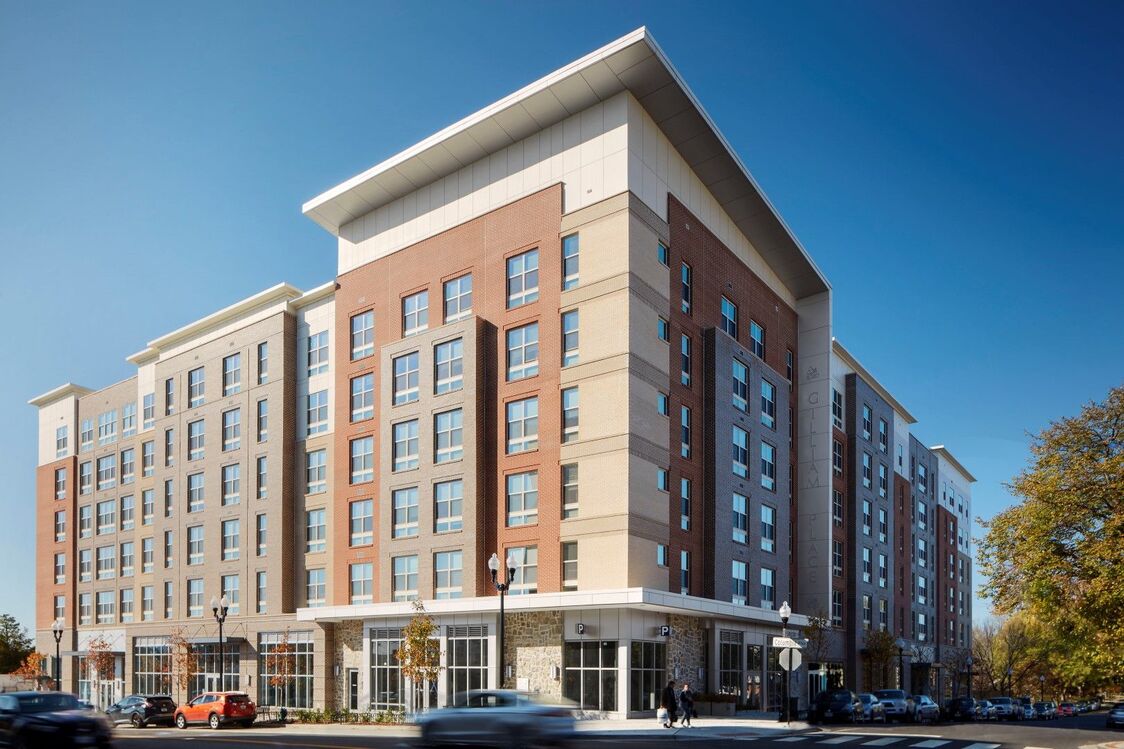
Excerpt from Affordable housing rises where a church building once stood by Edie Gross for Faith & Leadership.
Se pueden leer la traducción en español aquí (Read this story in Spanish)
Gilliam Place is an affordable housing complex born of one congregation’s quest to discern their calling in a community with changing needs.
The 173 apartments reserved for low-income families, seniors and those with disabilities are the result of a yearslong — and at times contentious– discernment process by Arlington Presbyterian Church.
Arlington Presbyterian’s stone sanctuary had occupied a lot near a busy intersection west of the Pentagon for more than 80 years. Like many churches, the congregation had seen its numbers dwindle, and its aging infrastructure had become an increasing burden. But what happened next wasn’t driven by finances, said Susan Etherton, a ruling elder and member for nearly 40 years. Arlington Presbyterian could have sold its property — worth more than $10 million just a few years ago — and built a new sanctuary elsewhere, she said.
“We weren’t looking to save ourselves,” said Etherton, who was deeply involved in the church’s effort to discover the community’s needs and discern how best to meet them. “It had to be grounded in that spiritual sense of, How is God calling us to be? What can we do, not for people really, but with people? How can we be in relationship with the community by doing something bold and courageous?
The congregation decided to join forces with the nonprofit Arlington Partnership for Affordable Housing, which shepherded the church through difficult conversations with its neighbors — and plenty of its own members — as well as negotiations with the local presbytery and the county. The organization then bought the land and constructed a six-story building where the church once stood, with five floors of affordable housing above retail space on the first floor.
Nina Janopaul, APAH’s president and CEO, estimates that more than 400 people have made Gilliam Place their home since it opened in August 2019. Hundreds more remain on a waiting list.
It’s hard to overstate the need for dedicated affordable housing, Janopaul said. Between 2000 and 2017, Arlington lost nearly 85% of its market- rate affordable housing units, largely because of increasing rent prices.
The entire process for Arlington Presbyterian, according to members, was an exercise in allowing God to reveal their purpose. They now rent space on the first floor of Gilliam Place, but that wasn’t a foregone conclusion. After selling the property to APAH, they gave away hymnals, pews and even the church organ, moved into a temporary worship space, and contemplated whether the congregation should continue to exist.
Church's money management lessons lead to transformation in an impoverished neighborhood.
Church's money management lessons lead to transformation in an impoverished neighborhood.
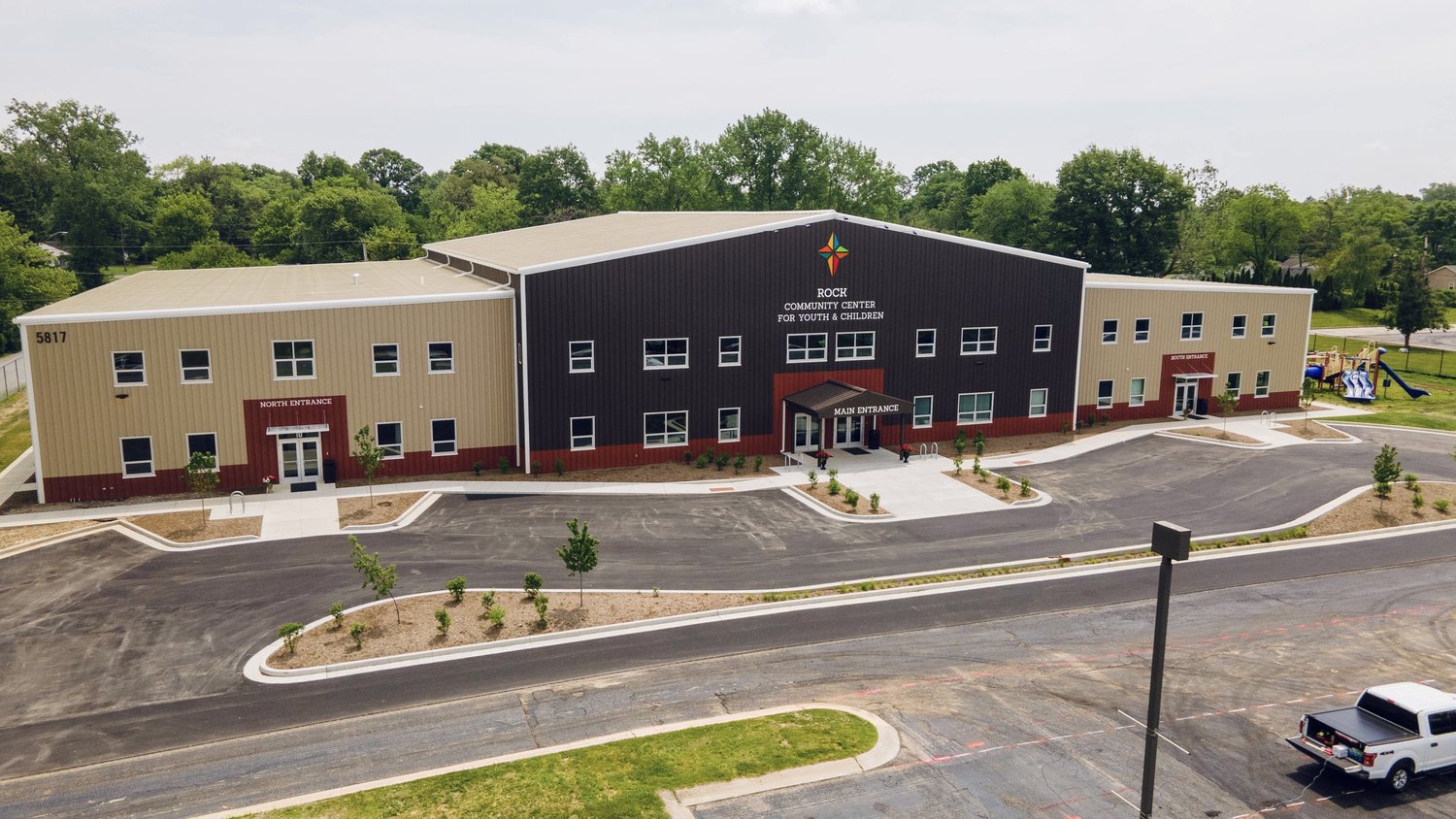
Excerpt from Church’s money management lessons lead to transformation in an impoverished neighborhood by Shari Finnell for Faith & Leadership.
After signing the deed to their new three-bedroom home, Steven and Harriet Gaither decided to keep the moving process simple. That first day, Steven focused on assembling their bedroom furniture, and nothing else.
Later that night, as the retired couple marveled at their first home purchase, Harriet whispered to Steven, “Do you hear that?”
He turned to her. “Hear what?”
Harriet once again prodded him: “You hear it?” Then, after a pause: “Quiet.”
They lay in each other’s arms, crying. It had seemed like an impossible dream — the American dream, Steven said.
“We didn’t have no money. No money at all,” he said.
Now, the Gaithers are able to sit on their own front porch with a clear view of a church that is restoring hope among residents in Arlington Woods, one of the most impoverished neighborhoods in Indianapolis.
Committed to giving back, Eastern Star Church, a Baptist church that describes itself as “one church in three locations,” has had a long history of supporting its neighbors in the 46218 ZIP code — an area where nearly 40% of residents live at or below the poverty line.
Here, the average household income is $26,400, compared with $44,900 for the whole of Marion County, Indiana.
During its 99-year history, the church has earned a reputation for helping thousands of disadvantaged people throughout the city through donations of food, clothing, services, funds and scholarships totaling in the millions.
During the past two years, the church has made an unprecedented investment in the 46218 community — setting into motion the ROCK Initiative, which stands for Renewing Our Community for the Kingdom.
It includes the development of a small neighborhood of new three-bedroom houses, like the one purchased by the Gaithers, and Sunstone at Arlington Woods, a mixed use building that features 25 apartments and retail space occupied by a credit union, a grocery store, a hair salon and social services providers. Boarded-up and dilapidated houses in the neighborhood have been renovated as well.
The ROCK initiative also funds reentry plans for ex-offenders who receive the one-on-one attention they need to interview for jobs and have their records expunged. They, along with others in the neighborhood and throughout the city, can access social services through the ROCK. In all, more than $5 million has been poured into the community since the ROCK Initiative was launched in 2017, primarily through private donations from church members. Longterm plans are underway to invest $30 million more into the neighborhood, including the development of a youth center and 25 more homes.
